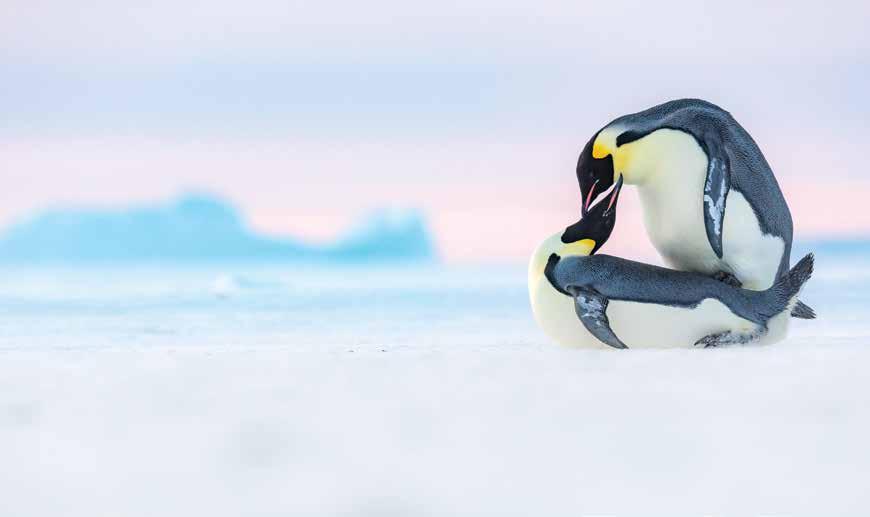
Wildlife Photographer of the Year
Inspiring and impactful
Classic & Wooden Boat Festival
Coming again this May
Sea Shepherd
Southern Ocean whaling


Wildlife Photographer of the Year
Inspiring and impactful
Classic & Wooden Boat Festival
Coming again this May
Sea Shepherd
Southern Ocean whaling
LAST YEAR NEW ZEALAND OBSERVED 250 YEARS since the first encounters between Māori and Pākehā (Europeans) in 1769, when British explorer James Cook arrived in Poverty Bay sailing on HMB Endeavour.
This significant time in history was marked by Tuia 250, a celebration of Aotearoa New Zealand’s Pacific voyaging heritage. It was a unique national opportunity for ‘all New Zealanders to hold honest conversations about the past, the present and how the country was to navigate its shared future’.1
The Australian National Maritime Museum’s Endeavour replica was chartered by the New Zealand Government’s Ministry of Culture and Heritage to take part in a special voyaging flotilla, a major element of the Tuia 250 celebrations.
From October to December last year, the flotilla sailed to and engaged with communities across New Zealand. It visited sites of cultural and historical significance and gave Māori iwi (nations) and communities the chance to share stories of arrival and their encounters with Tupaia, James Cook and his Endeavour crew.
The impressive flotilla comprised a double-hulled voyaging canoe, Fa’afaite, from Tahiti; two Māori waka hourua, Haunui and Ngahiraka Mai Tawhiti, from Aotearoa New Zealand; and three European tall ships: R Tucker Thompson, a traditional gaff-rigged schooner; the three-masted barquentine Spirit of New Zealand, which is believed to be the world’s busiest youth training ship; and our own replica Endeavour. Hundreds of New Zealanders took the rare opportunity to sail on one of the flotilla ships in a series of voyages around the country.
Large family-friendly events took place at port stops during the voyages, where the public could board the vessels and learn about Pacific, Māori and European sailing and navigation. Almost 20,000 people visited our replica Endeavour, including more than 1,000 students.
Tuia 250 also provided a once-in-a-lifetime opportunity for the museum’s own voyaging crew and support staff, who were honoured to be invited by local Māori iwi to their marae (meeting grounds). The crew recount powerful and emotional moments as Māori elders spoke of their iwis ’ own encounter stories and the lasting impact these had on their communities.
1
I, too, had a chance to sail on Endeavour during Tuia 250 as a crew member and to participate in the iwi welcome to the Waitangi Treaty Grounds. My overwhelming impression was of an incredible professional crew, led by captain Frank Allica, who successfully sailed Endeavour in some very challenging weather, and also represented the ship and its history in an impeccable way that reflected so positively on the museum.
As the custodians of the replica Endeavour, we are proud that the ship and our crew took part in this extraordinary voyage – one of great national significance for New Zealanders. The New Zealand Ministry of Culture and Heritage Tuia 250 website states:
The Tuia 250 commemoration has left a legacy for future generations. The legacy has been created through voyaging and encounters education and conversations that took place during the commemoration, through new physical markers and signage at sites of significance, through the changing of place names to reflect dual heritage, and through the healing that has occurred in communities and the strengthening of relationships.
This year and next, the museum will offer to communities all around Australia a unique commemorative program marking Cook’s 1770 voyage. Collectively called Encounters 2020, it comprises exhibitions, film, digital and educational initiatives and a series of voyages by Endeavour around the country, accompanied by a travelling exhibition of Indigenous art. The program will commence in Sydney in April. Importantly, our program explores dual perspectives, of both the view from the ship and the view from the shore. We know – as we witnessed with the New Zealand experience – that there will be difficult conversations taking place throughout Australia about the lasting impact of Cook’s arrival 250 years ago, particularly for Aboriginal and Torres Strait Islander communities. Our aim, however, is for Encounters 2020 to also leave a legacy for future generations of Australians by providing a platform for all of us to reflect on, discuss and re-evaluate the lasting impact of this pivotal event.
Kevin Sumption psm Director and CEO New Zealand Ministry of Culture and Heritage, Tuia 250 website.The Australian National Maritime Museum acknowledges the Gadigal people of the Eora nation as the Traditional Custodians of the bamal (earth) and badu (waters) on which we work.
We also acknowledge all Traditional Custodians of the land and waters throughout Australia and pay our respects to them and their cultures, and to elders past and present.
The words bamal and badu are spoken in the Sydney region’s Eora language. Supplied courtesy of the Metropolitan Local Aboriginal Land Council.
Cultural warning
People of Aboriginal and Torres Strait Islander descent should be aware that Signals may contain names, images, video, voices, objects and works of people who are deceased. Signals may also contain links to sites that may use content of Aboriginal and Torres Strait Islander people now deceased.
The museum advises there may be historical language and images that are considered inappropriate today and confronting to Aboriginal and Torres Strait Islander peoples.
Cover Pondworld by Manuel Plaickner (Italy). © Manuel Plaickner/Wildlife Photographer of the Year
2 Canoes and culture
A visit to the Massim communities of Milne Bay, Papua New Guinea
8 Thanks to our supporters
News from our Membership and Foundation sections
10 Head to the harbour
The Classic & Wooden Boat Festival gears up for May
16 Nature in focus
The best of Wildlife Photographer of the Year
20 ‘Volleys of small arms’
The military nature of Pacific voyages of exploration
24 Bound for South Australian
A field expedition uncovers more about a colonial wreck
30 ‘She will be the first woman that ever made it’
The 18th-century circumnavigation by Jeanne Baret
38 A relic of the Southern Ocean whaling wars
The museum acquires a Sea Shepherd boat
46 From shoal to market
Technology tracks the provenance and quality of seafood
48 Museum events
Your calendar of talks, tours and excursions afloat
54 Autumn exhibitions
HERE: Kupe to Cook ; Sea Monsters; Defying Empire and more
58 Encounters 2020
Commemorating the 1770 encounters around Australia
60 A scientific circumnavigation
The Schmidt Ocean Institute deploys RV Falkor in Australian waters
64 Paths for peace
High school students reflect on the Pacific theatre of World War II
70 Tales from the Welcome Wall
Las Balsas, the world’s longest raft journey
74 Currents
National awards recognise conservation staff and volunteers
The war canoes that are part of the traditional culture of these Milne Bay communities have now evolved into a means of working together
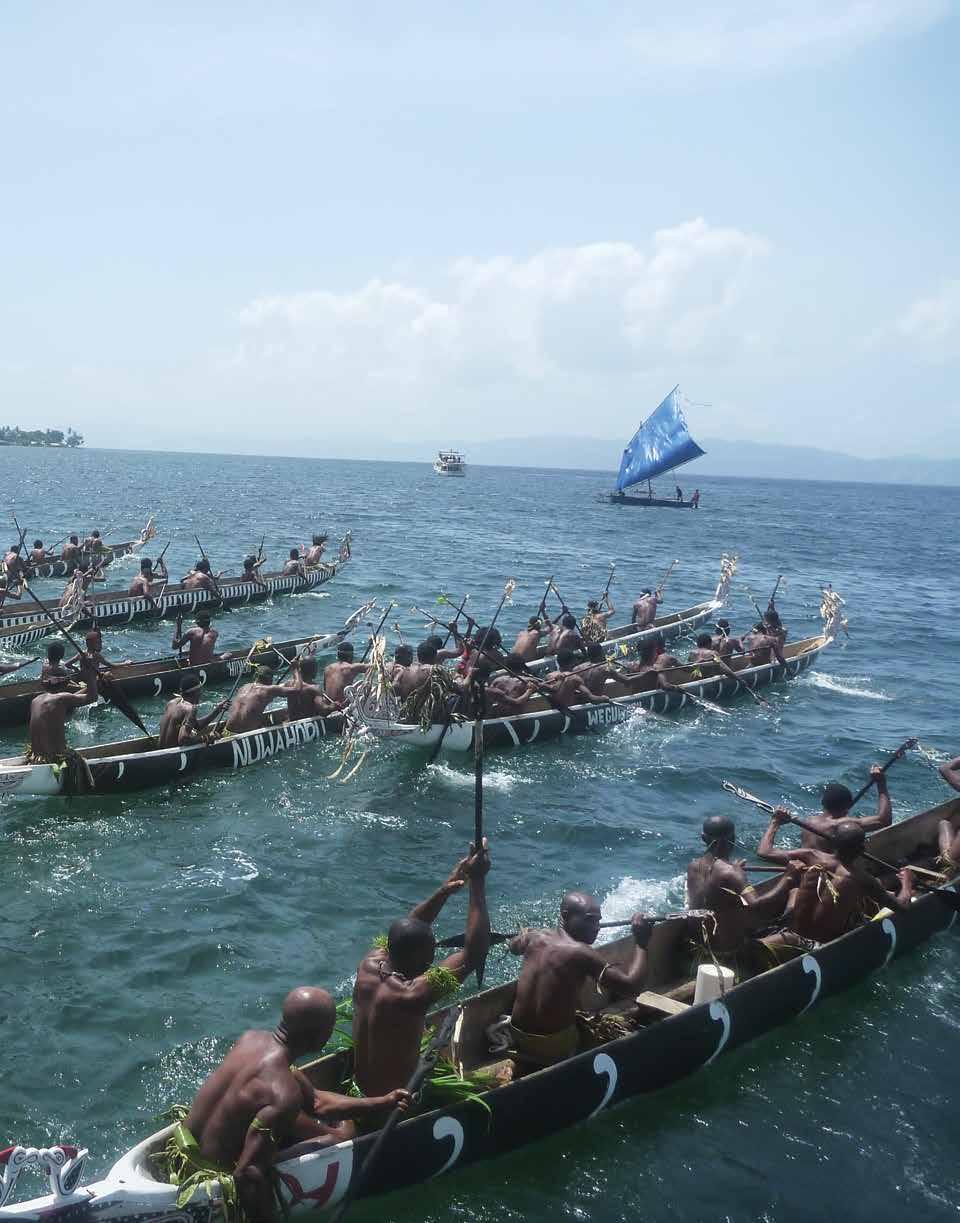
Alotau, on the shore of Milne Bay in Papua New Guinea, is a place of spectacular scenery steeped in culture and tradition. Curator of Historic Vessels David Payne travelled there in October 2019 to attend the opening of the Massim Canoe exhibition at the Massim Museum and Cultural Centre.
THE MASSIM CANOE EXHIBITION displayed the 22 plans of these communities’ traditional outrigger and war canoes that I had drawn after a month-long trip by motor launch in August 2017, documenting the various traditional watercraft of this remote region of Papua New Guinea (see Signals 121).
Facsimile copies of the plans had been sent ahead, and on arrival we worked with staff of the Massim Museum and Cultural Centre to reorganise the museum’s rooms, sort the plans and drawings into groups, mount them on the walls, set up the banners and help them create the display that they had in mind. We had it all together just in time, including a good interview on camera with the local media representative, Priscilla Waikaidi.
Susan Abel is a driving force behind the Massim Museum, which was set up by her father-in-law, Sir Chris Abel. She deserves much credit for the energy she put into making this happen at the Alotau end with her team: organiser Roz, trustee Jeff, staff member Lucinda and volunteers.
The Australian National Maritime Museum helped by funding all the design and printing, the stand-up banners, transport and incidental costs of the exhibition material. As part of the initiative, we engaged a local graphic designer to create the banners. The Australian High Commission generously sponsored the opening night, along with support from local businesses.
Sea and air transport are Alotau’s only connections to the rest of the country, but despite this it was a gala evening for the township, bringing many people together to talk over drinks, as well as look at the display. The Australian High Commissioner Bruce Davies and Consul General Jo Stevens attended, along with Allanah Banning and Edwina Sinclair from the Department of Foreign Affairs and Trade, and key local community leaders from Alotau, including Provincial Administrator Ashan Numa and his deputies, Mayor Gita Elliot, Kenu and Kundu Festival chairman Harold Tabua and tourism CEO Sioni Sioni.
It was satisfying to hear first-hand how complimentary they were of the plans and the research involved, enjoying and respecting the detail and time needed to bring them up to a high standard. While we talked about them being a valuable record for the future, the speeches also reflected on the importance of the wonderful Massim canoes to the culture of the communities who built them, and the need for future generations to continue making them.
The next day the annual Huhu Bay War Canoe Festival began, across the bay at Wagawaga. This was an extraordinary experience, with a community vibrantly celebrating their tradition and culture with pride and passion. The Maritime Museum’s Indigenous Programs Curator Helen Anu and I were among just a dozen visitors and tourists at the event.
At Wagawaga the village chief, Dago Alisa, warmly welcomed us and explained some of the background and proceedings. Our group was very kindly looked after by the small team from Maxine Nadille’s Egwalau Tours. Maxine had helped me in August 2017 with introductions to the festival chairman, Kaimouyoni Ila, who had allowed me to record Kaoha, one of the canoes from his village, Maiwara.
War canoes leave the beach at the Kenu and Kundu Festival, Alotau. All images David Payne/ANMM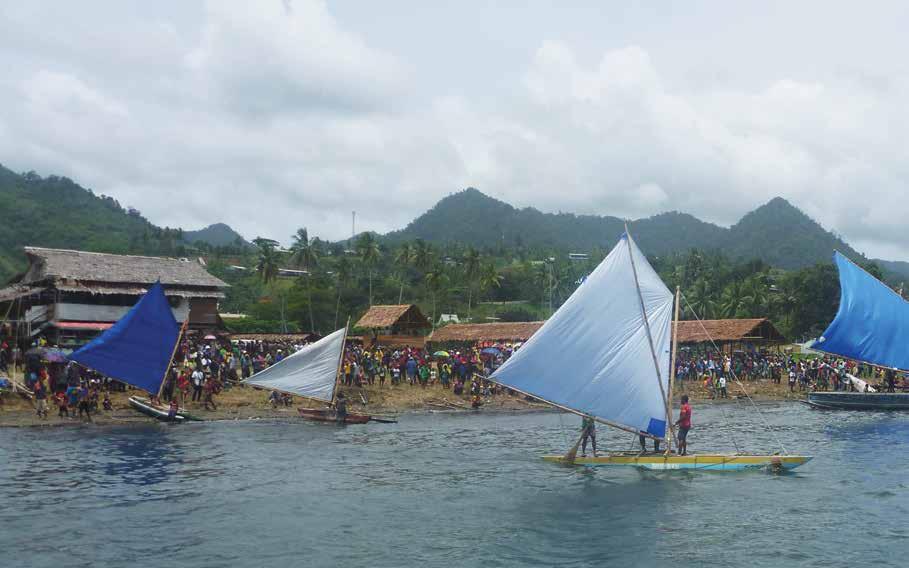
This is a major cultural event for the village communities on the shore of Milne Bay: Maiwara, Gibara, Camadoudou, Kilakilana, Gwavili, Gabuganabuna and the host for this festival, Wagawaga. In earlier times their war canoes were used for raids, but now the gebo or lopou war canoes come together in a festival to share food and friendship and make new connections.
It started with tepali, the arrival of feasting parties with their gifts of food and live pigs for the village chief. The pigs are trussed to tree trunks carried on shoulders, and part of the ceremony often involved ramming the trunk and its open roots against a tree next to the chief’s house. This was a symbolic gesture of old practices, as was the gift of a live pig. Pigs would be exchanged among the community, with only one becoming part of the feast. The men, carrying spears, led in the women, who were dressed in grass skirts or pandanus leaf bindings. As they approached the open area in front of the hut the men began an aggressive action timed to the beat of kundu drums, leaping forward at the crowd with spears and dressed with war paint, pig’s teeth adornments and colourful feathers. At the hut the food was deposited – or in some instances hurled up at the chief and his helpers – while each pig was placed under the hut.
Primary and secondary school groups also took part, dancing and singing as they came in, and at times groups that had already arrived broke into their entry procession dance again as we waited for the next group to come in. It rained, the wind blew, the sun came out, all adding to the wonderful atmosphere.
There was a shift in proceedings when a primary school group sang the national anthem then recited the Lord’s Prayer in the local Suau language supported by Emalyn, their cultural teacher, holding her grandfather’s ceremonial axe. The mix of cultures here includes a strong Christian faith among many of the community.
Culture was the keynote in the four speeches that were then delivered, beginning with the chairman of the festival, Kaimouyoni Ila, and ending with the local member of parliament, Charles Abel, who gave a strong speech emphasising that preserving and teaching traditional culture and developing leadership in youth were vital to future generations.
The war canoes that are part of the traditional culture of these Milne Bay communities have now evolved into a means of working together. In the afternoon, eight war canoes up to 23 metres long, with 10 to 20 warriors paddling them, moved out from the shore in a fine demonstration of the teamwork needed to control the craft. The smallest had a youthful crew with two older boys as mentors sitting bow and stern, and at least one of the larger canoes had a very young boy up front, where a light person is well placed for trim.
Teamwork is needed to build a canoe and the cultural practices still observed are reflected in many of the stages of construction. Talking with two of the builders, they indicated that younger people were learning from them, too.
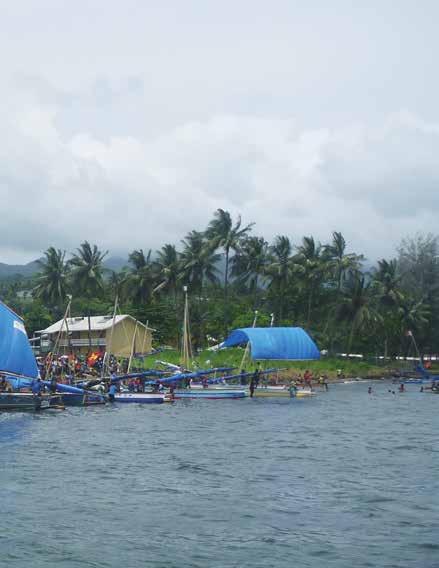

Youth and elders were evident in everything we observed, and the signs are very promising that this festival will be an important part of local culture into the future. Plans are already under way for the 2020 festival.
My next task was to deliver a copy of the plans of the epoi Ealami Etana to where it was built and documented in Waluma East Village No 3 on Fergusson Island, and hopefully meet the owner, Terry Ronal, again. With delays, the trip took three days, and on arrival we found the landing too rough to bring the boat in close, and virtually no one on shore to call out to for a canoe. One of the deckhands swam ashore to ask for Terry, but he was away in his garden. Eventually we decided to swim the laminated plans onshore to leave there with his mother and son. Despite not seeing Terry Ronal, it was gratifying to know that the museum has been able to return the plans for this epoi to the community where it was documented two years ago.
At the end of the week the Alotau waterfront came alive again with the National Kenu and Kundu Festival, a huge gathering of community, stalls, dancers in traditional costume with kundu drums, singing groups, war canoes and sailing canoes. On the Friday I was interviewed on camera by PNG TV identity John Eggins from EMTV and the PNG Tourism Promotional Authority, before heading down to the shoreline for the action. The war canoes led things off with a call from a conch shell, demonstrating their paddling skills then finishing off by heading toward each other in two lines at great speed.
The Huhu Bay War Canoe Festival is a major cultural event for the village communities on the shore of Milne Bay
01
Sailau – single outrigger canoes – stage a sailing demonstration on the Alotau waterfront.
02
Facsimile plans of the Massim canoes drawn by David Payne on display at the Massim Museum and Cultural Centre in Alotau.
The National Kenu and Kundu Festival is a huge gathering of community, stalls, dancers, drummers, singing groups, war canoes and sailing canoes

This demonstration was repeated the next morning, but then they formed up beside each other way out in the distance, offshore. This was the real spectacle – a re-creation of a canoe raid. This spectacular sight started quietly, then the wall of canoes on the horizon became larger and approached faster and faster. We began to hear their chant and the sound of paddles striking the hull on each stroke, all craft in unison, before we picked out the individual boats and the mass of paddlers now coming at great speed. Arriving at the beach, paddles became weapons as warriors leapt from their craft, where they were met by a challenge from on shore.
On the Saturday afternoon, smaller sailing canoes gave a sailing demonstration, before starting a race from the shore to the other side of the bay and back. These craft – isuabiabi from Suau Island and kebwakebwai from Basaliki and Dobu Islands – were types that I had not seen in 2017, so early next morning I met owners of the craft and was able to measure up an example of each to document and draw when back in Sydney.
The on-water activities were matched on land by an extraordinary display of dancing and drumming from groups in the region. It started as they arrived in decorated,
covered trucks, packed together but already drumming a beat on their kundu. Dressed in costume, they each had many turns at performing in the arena, then gave impromptu displays off to the side, posed for photos and caught up with friends.
A tepali was held on the Saturday before the official opening and speeches. The guests were high profile – the Prime Minister, Mr Marape, Finance Minister and local member Charles Abel, along with senior administrators. This festival is a big occasion. Before returning home there was one more meeting arranged, at the National Museum and Art Gallery in Port Moresby.
There I spent time with Military Curator Dr Andrew Connelly, looking at exhibits and discussing the collection before meeting Director Dr Andrew Moutu. The National Museum and Art Gallery houses an impressive collection of artefacts and research, and is a fine showcase of the diverse Papua New Guinea culture.
Flying back to Sydney provided a chance to wind down and reflect on what had been an action-packed, vibrant and satisfying 16 days in this challenging and ultimately irresistible country – progressing the work from 2017, renewing previous contacts, making new friends and supporting the community in Milne Bay.






















































































nationalgeographic.com.au/cosmos /natgeoau


Our Members and Foundation offices provide opportunities for you to get more involved in the museum, from supporting specific appeals to attending special events. The museum must raise more than 40 per cent of its running costs annually, and donations help to fund vital programs and exhibitions. All donors will receive an invitation to a special event to thank them for their generosity.
Thanks to our generous donors in 2017, the 1:48 scale model of SS Orontes was secured at auction. Now begins the painstaking restoration process to ensure the model is ready for display and to be enjoyed for generations to come.
This intricate model, measuring 4.2 metres long, was built in 1929 in the model workshop of the shipbuilders in England as part of the vessel’s commissioning. It is a fine example of the modelmaker’s craft in an age when ships were the largest and most technologically advanced machines in the world.
The model cost £856 pounds to build (equivalent to about $65,000 today) and was presented as a showpiece for the Orient Line Building in Sydney.
The conservation of this important model will start shortly and take up to 18 months to complete. A highlight of this process will be an X-ray to determine construction details and also confirm whether the modelmakers hid a note inside the model, as was common practice. You can be part of this important restoration project by completing the donation slip in this edition of Signals and returning it in the reply-paid envelope provided. Donors will be invited to a special white-glove tour and briefing to keep them informed of progress.
OVER THE FIRST QUARTER OF THIS YEAR, the museum has been able to pursue important programs, thanks to much-appreciated donations.
The replica of HMB Endeavour is ready to set sail with new essential fittings because of this support. Its new hammocks were funded by a generous donor, and new ropes and sail repairs were also funded by donations. To those who gave to this campaign, thank you. Your support will help inspire a nation as Endeavour travels around Australia.
The glamorous steam yacht Ena is back cruising Sydney Harbour. The museum’s new Ambassadors, Dr David and Mrs Jennie Sutherland, have contributed significantly to Ena ’s refit and the planned reconstruction of its elaborate 120-year-old boiler. One of the Foundation’s newest board members, David Mathlin, is also an Ena enthusiast and has contributed liberally to help return this Edwardian beauty to the museum’s fleet. Visitors to the museum can tour Ena daily and the vessel is also now available for private charter.
On 28 February the Australian National Maritime Museum Foundation hosted its first Annual Fundraising Gala. Its principal purpose was to generate important income for the museum. This wonderful event showcased the museum to 200 people, who enjoyed a performance by musicians from the Sydney Symphony Orchestra and a meal designed by award-winning chef Giovanni Pilu.
For more information on Foundation projects, please contact Foundation Manager Marisa Chilcott on 02 9298 3619.
For more information on upcoming events, please see pages 48–52 or phone Members Manager Oliver Isaacs on 02 9298 8349. We look forward to seeing you at the museum soon.
If you would like to donate, please go to www.sea.museum/donate
01
Some of the Members who attended the Anniversary Lunch last November, with Director Kevin Sumption PSM (second from left) and Members Manager Oliver Isaacs (far right). Image Andrew Frolows/ANMM
02
Endeavour ’s Master, John Dikkenberg, with new hammocks that generous donations enabled us to buy. Image Andrew Frolows/ANMM


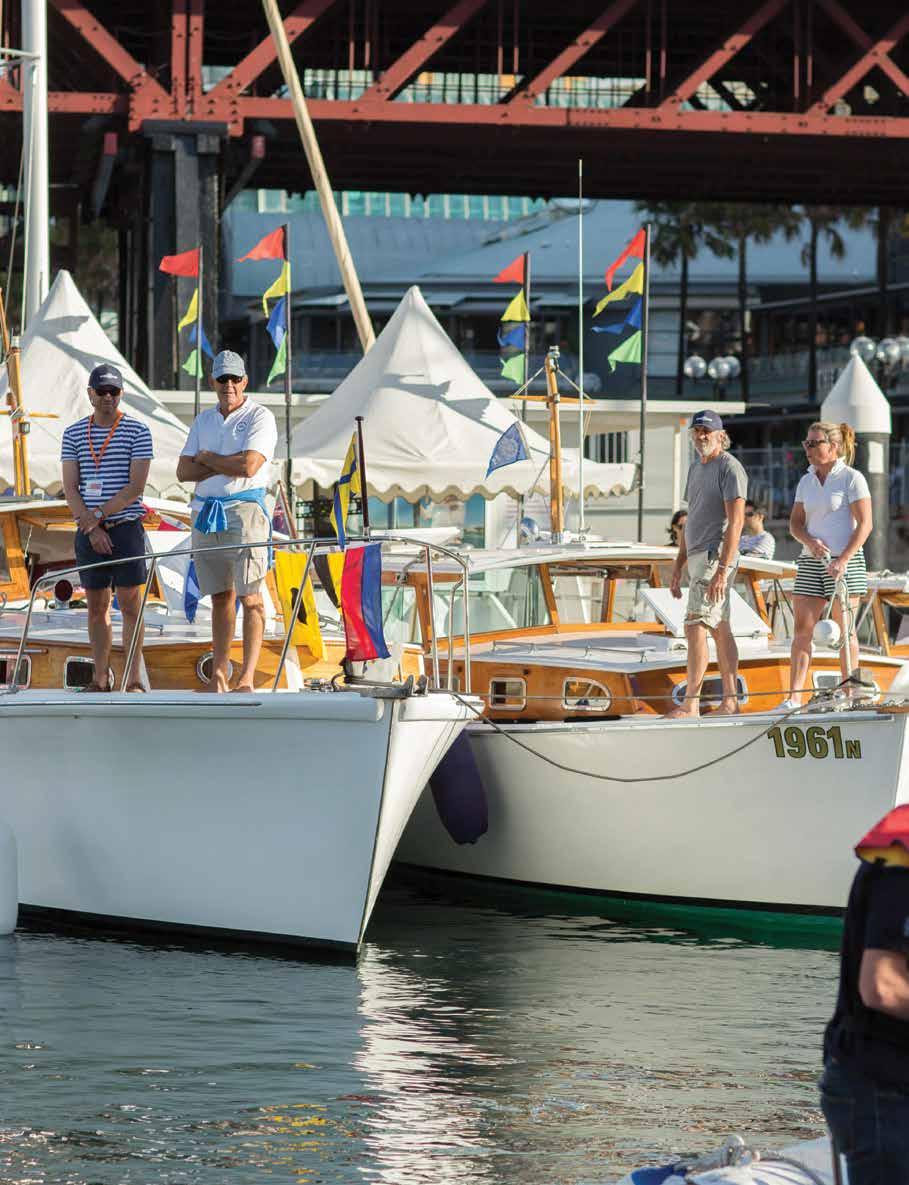
Behind-the-scenes tours will focus on items from the museum’s collection
Some of the fleet of immaculately restored former Halvorsen hire cruisers at the 2018 festival.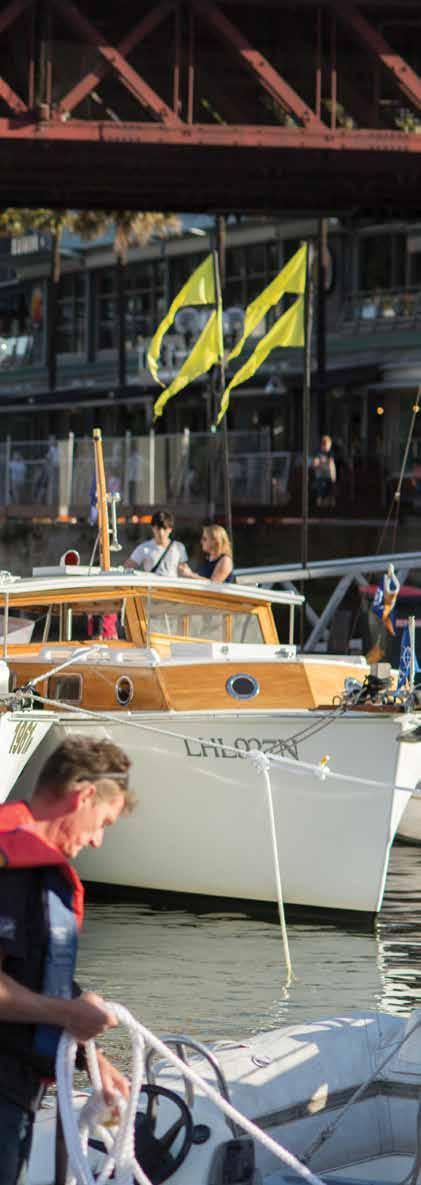
The 2020 Classic & Wooden Boat Festival is coming to the museum’s waterfront in May. It coincides with the early stages of the museum’s national program Encounters 2020, during which the replica HMB Endeavour will undertake a 14-month voyage around Australia alongside a travelling Indigenous art exhibition to mark 250 years since James Cook charted the east coast in 1770. David Payne and Alana Sharp provide a preview.
SINCE THE LAST CLASSIC & WOODEN BOAT FESTIVAL, the museum has continued to further develop this event. It will celebrate all classic and wooden boats, acknowledge traditional boatbuilding skills and showcase the passion of the dedicated craftspeople who make these unique and celebrated vessels.
More than 140 boats will join an array of stallholders at the museum from 1–3 May. The museum’s magnificent SY Ena will be one of the outstanding craft on show, along with the Sydney Heritage Fleet’s schooner Boomerang and the recently restored Southwinds, and a proud display of yachts that have contested the Sydney to Hobart Yacht Race. Also featured will be historic International 5.5, 6, 8 and 9 Metre class boats, a couple of Ranger class yachts, vintage motor craft and classic dinghies. The Halvorsen Club will showcase a huge range of this historic firm’s valuable motor cruisers and yachts, most of which are now collector’s items.
The festival program will include many other boats both afloat and on land around the museum, as well as a maritime marketplace where trades and market stalls of all types will bring out their wares for festival-goers to peruse and purchase. Further craft will be on display across the water in Cockle Bay.
Behind-the-scenes tours will focus on items from the museum’s collection, and visitors will be able to cruise on some of Sydney Heritage Fleet’s vessels, taking in the atmosphere of the festival and our beautiful harbour. The extremely popular swimwear parade will return, using the museum’s extraordinary range of ‘cossies’ from its education collection.
Throughout the day there will be music, entertainment and roving performers, workshops and trade displays, a shipwrights’ village, Kids’ Boat Shed and the very popular ‘Quick and Dirty’ Boatbuilding Challenge.
More than 140 boats and an array of stallholders will take part in the event
01
Boats of various sizes, on the shore and in the water, attracted more than 33,000 people to the 2018 festival.
02 The Quick and Dirty Boatbuilding Challenge tasks teams of children and adults to build a boat in four hours, then test its seaworthiness.
03 The popular swimwear parade focuses on the evolution of beach fashion.
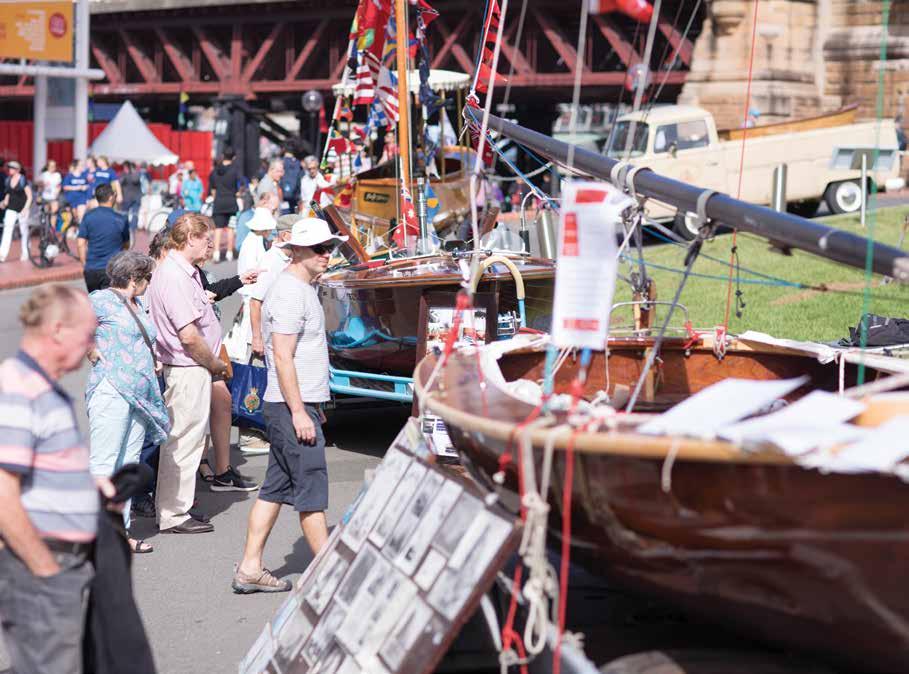
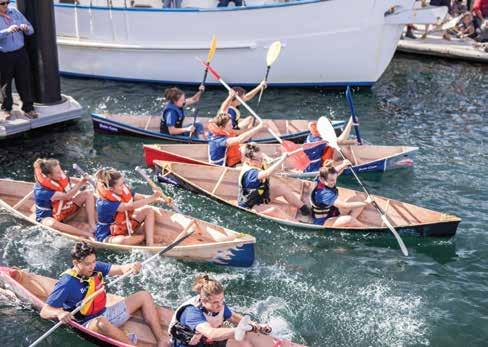
The extremely popular swimwear parade will return using the museum’s extraordinary range of ‘cossies’ from its education collection

Keep the first weekend of May free to come to the museum and feast your eyes on glorious boats of all shapes and sizes
A series of talks in the museum’s theatre promises to be a highlight, with panel sessions on diverse themes: ‘World Sailing Women’, featuring Wendy Tuck and Kay Cottee; ‘Rust to Ritz’, in which Simon Sadubin, Ian Smith and David Payne will talk about restoration projects; ‘Australia’s Sailing Legends’, with Adrienne Cahalan, Mike Fletcher and John Stanley; and ‘The Sydney to Hobart Yacht Race: History, Hazards & Heroes’, with veteran sailors focusing on the great yachts and individuals who have helped make this race one of the world’s great ocean classics. For more details about these talks, please see page 50.
Make sure to keep the first weekend of May free to come to the museum, feast your eyes on glorious boats of all shapes and sizes and talk to the owners and other enthusiasts. For more information visit our website at sea.museum/cwbf or sign up for our email updates at cwbf@sea.museum.
Star vessels
Yachts
Caprice of Huon
Southwinds
Fidelis
Acrospire IV
Kelpie
Maris
Boomerang (Sydney Heritage Fleet)
Britannia skiffs – the museum’s original and Ian Smith’s replica versions
Motor vessels
Dorothy T Goolara
Bennelong
Athena
SY Ena
Hammondcraft clinker ski boats
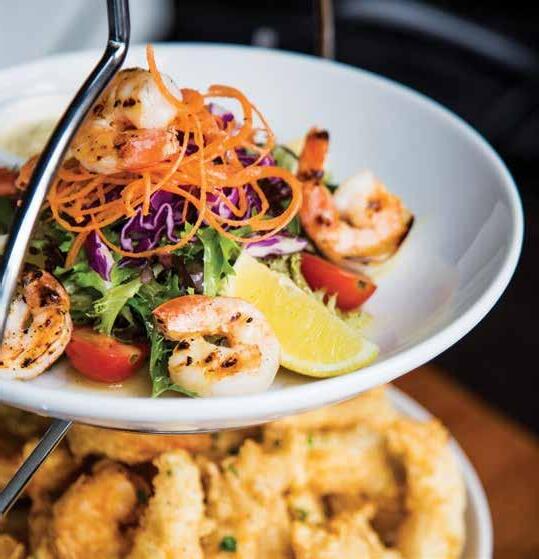
More than 140 boats and an array of stallholders will take part in the event
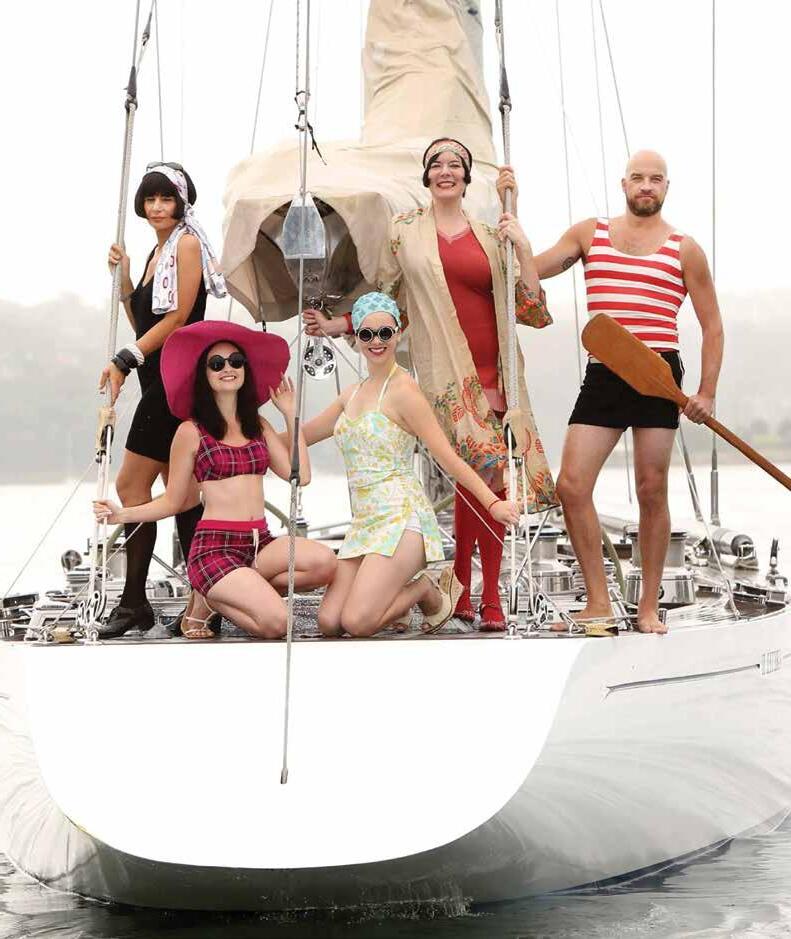



Wildlife Photographer of the Year returns to the museum, celebrating the very best nature photography and photojournalism. On display are the top 100 images chosen from almost 50,000 entries worldwide.

The winning images challenge us to consider both our place in the natural world and our responsibility to protect it
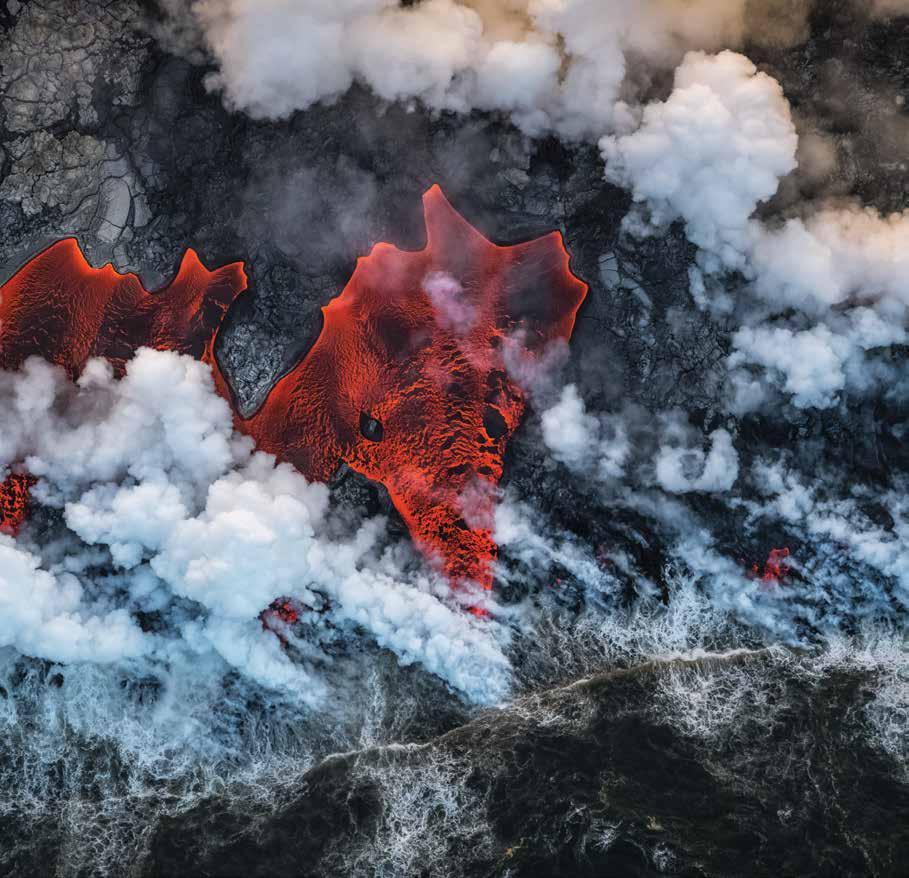
01
Sleeping like a Weddell by Ralf Schneider (Germany).
Hugging its flippers tight into its body, the Weddell seal closed its eyes and appeared to fall into a deep, contented sleep. Shooting from a boat, Ralph tightly framed the sleeping seal against the ice-covered background.
© Ralf Schneider/Wildlife Photographer of the Year
02
Circle of life by Alex Mustard (UK).
In the clear water of the Red Sea, a shoal of bigeye trevally circles 25 metres down at the edge of the reef. For the past 20 years Alex has travelled here, to Ras Mohammad – a national park at the tip of Egypt’s Sinai Peninsula – to photograph the summer-spawning aggregations of reef fish. © Alex Mustard/ Wildlife Photographer of the Year
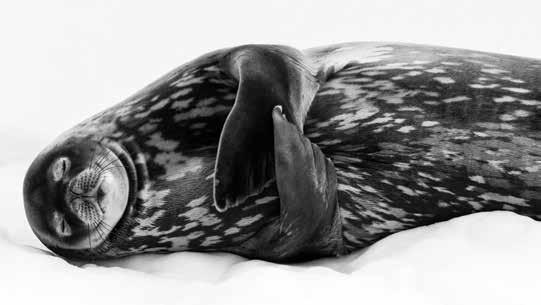
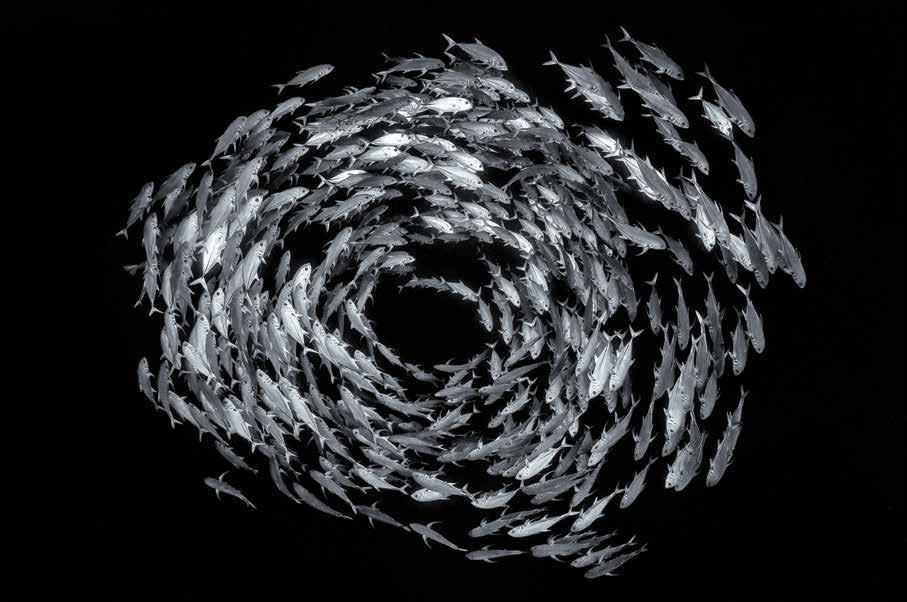
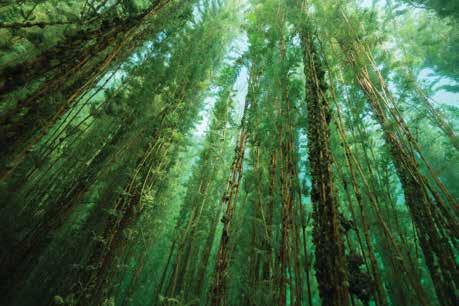

A SLEEPING SEAL, a zombie beetle and a tragic turtle are just some of the captivating and emotive images from the Wildlife Photographer of the Year competition, which is now in its 55th year.
The competition, developed and produced by the Natural History Museum, London, features the world’s best nature photography and photojournalism. The winning images showcase wildlife photography as an art form and challenge us to consider both our place in the natural world and our responsibility to protect it.
The origins of the Wildlife Photographer of the Year competition go back to 1965, when the three available categories attracted around 600 entries. Even then, it was the leading event of its kind for nature photographers. It grew in stature over the years and in 1984, the competition as it is known today was created.
The international judging panel comprises respected wildlife experts and nature photographers. Images are chosen for their artistic composition, technical innovation and truthful interpretation of the natural world.
Dr Tim Littlewood, Director of Science at the Natural History Museum and a member of the judging panel, says:
For more than 50 years this competition has attracted the world’s very best photographers, naturalists and young photographers, but there has never been a more important time for audiences all over the world to experience their work in our inspiring and impactful exhibition. Photography has a unique ability to spark conversation, debate and even action. We hope this year’s exhibition will empower people to think differently about our planet and our critical role in its future. Wildlife Photographer of the Year opens on 5 March. 03
Pondworld by Manuel Plaickner (Italy). To take this image, Manuel immersed himself and his camera in a large pond where hundreds of frogs had gathered.
© Manuel Plaickner/Wildlife Photographer of the Year
During the great age of Pacific voyaging, ‘scientific’ expeditions also had colonial goals and were backed by military power and strategy. From the earliest days, they were also resisted by Pacific peoples. By Dr Stephen Gapps .
IN EARLY SEPTEMBER 1770, when Lieutenant James Cook had sailed his ship HMB Endeavour from Australian shores and was passing Papua New Guinea en route to Timor and then Batavia, a strange event occurred. Along with naturalists Joseph Banks and Daniel Solander, and with only a few crew, he landed a small boat on what seemed to be a deserted beach, but did not feel safe to venture into the close, thick bush ‘in fear of an ambuscade’ (ambush).1
Officers on board Endeavour watched through telescopes as Cook and his men suddenly came under attack by New Guinea locals. Alarmingly, and to their surprise, they saw puffs of smoke that looked like the powder flash of flintlock muskets. According to Cook’s report, the men on Endeavour genuinely believed he was under attack by firearms: 2
… what appear’d most extraordinary to us was something they had which caused a flash or fire or [smoke], very much like the going off of a Pistol or sm’ll Gun … When 4 or 5 would let them off all at once [this] had all the appearances in the world of Volleys of Small Arms …
Cook thought these weapons might have been used in imitation of firearms, but could only guess at their use. It seems that the weapons were bamboo poles with burning tinder inside that could cloud the user in smoke and serve as a threat or challenge. Whatever the case, ‘small parties of natives’ advanced from the woods, causing Cook and his men to return to their ship. He ordered that they sail westward and leave the coast.
This was not the first, nor the last, time that European voyagers in the Pacific, such as Cook, were deterred by local people. In 1595, the Marquesas Islanders had repelled the Spanish navigator Alvaro de Mendana; in 1760, a four-day battle ensued between islanders and Europeans when Samuel Wallis, in the Dolphin, landed in Tahiti; and in 1789, William Bligh was forced from Tofua by a hostile local reception (see Signals 128). These commanders, like many European voyagers in the Pacific, did not choose their routes or landings, but were often bounced around islands and coasts according to military advantages or disadvantages.

Mort de Cook (Death of Cook), 1887. This handcoloured engraving is based on an original painting by
The military nature of Endeavour ’s voyage is often overlooked or downplayed
 John Webber, the official artist for Captain Cook’s third voyage of the Pacific. ANMM Collection 00002925
John Webber, the official artist for Captain Cook’s third voyage of the Pacific. ANMM Collection 00002925
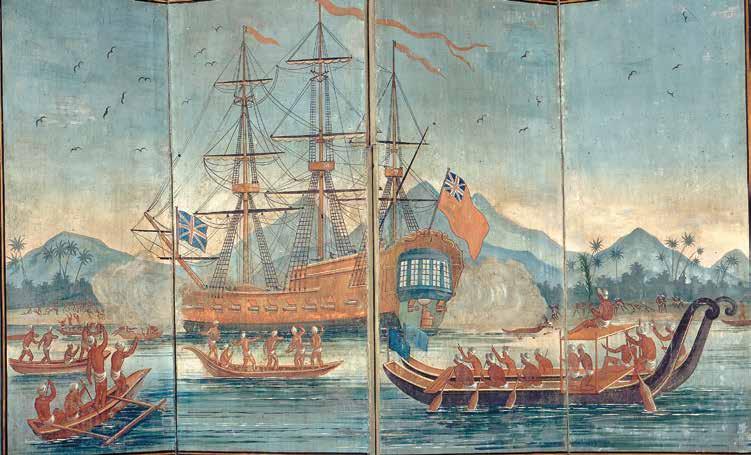
Imperial science and conquest
When Endeavour left New Guinea, both Cook and Banks noted that the crew’s morale improved. Banks put it down to nostalgia, but another factor may well have been the knowledge they were finally heading toward European colonies, and no longer needed to maintain a constant state of military alert.
During the New Guinea episode, Endeavour had only four cannon, having jettisoned six of them to lighten the ship’s load when it foundered on the Great Barrier Reef several weeks earlier. 3 Cannon such as those dumped overboard by Cook now make good museum objects and monuments in public parks. Inert and detached from their original purpose, they rarely tell the story of what they were designed for, or their critical role in the colonisation of Oceania. Often, like those on Endeavour, they were rarely, if ever, used – the power of artillery fire had been swiftly learned by Pacific peoples after Europeans first arrived in the 1500s, many years before Cook (see Signals 128).
There are few overarching military histories of the resistance warfare that occurred across the Pacific from the 1500s right through to conflicts such as Samoan resistance to German imperial rule in 1908. Long, inexorable and disparate warfare and conflicts are not the terrain of heroic or packageable histories. Military historians tend to focus on modern wars as ‘proper’ military history. Yet conflict across the Pacific was surprisingly interconnected over time and across vast regions, and even influenced military thinking back in London.
Before Endeavour left Plymouth in 1768, its complement of marines and arms, and even tactics when encountering Pacific peoples, were all refined by reports from other voyagers such as Wallis.4
The military nature of Endeavour ’s voyage – as part of an aggressive reconnaissance as well as a floating defence against indigenous resistance and counterattack – is often overlooked or downplayed, despite the many instances of conflict and the use of musket fire to teach lessons of British military superiority that underscored almost all of Cook’s Pacific encounters with indigenous peoples.
In the broader strategic sense, Cook’s voyages – like all scientific expeditions of the 18th and early 19th centuries – were also part of a European drive to conquer people and claim resources that would support the expansion of the British empire. During the great age of Pacific voyaging, expeditions always had several goals. Victory in the Seven Years War (1756–63) caused a surge in British imperial ambition, and Cook’s first voyage came soon after, at the height of the promotion of ‘imperial science’ as a critical part of both establishing an empire and managing the development and control of the state during the upheavals of industrialisation in Europe.
‘Scientific’ voyages were primarily a 19th-century development after the Napoleonic Wars, when science and spying had become fine arts under commanders such as Nicholas Baudin. 5 Even Cook, as was expected of any seagoing commander visiting distant stations, made military reconnaissance notes.
Conflict across the Pacific was surprisingly interconnected over time and across vast regions, and even influenced military thinking back in London
01
Captain Samuel Wallis attacked in the Dolphin by Otahitians (detail), artist unknown, c 1800. The painting on this folding screen was copied from an engraving in John Hawkesworth’s 1773 book of Pacific discoveries. ANMM Collection 00006125
02
Neptune raising Captain Cook up to Immortality, a Genius crowning him with a wreath of oak, and Fame introducing him to History, engraver J Nagle. Frontispiece to New System of Geography by the Reverend Thomas Bankes, publisher J Cooke, London, c 1790. ANMM Collection 00001398
In November 1768, when Endeavour provisioned at Rio de Janeiro, the local viceroy was suspicious of a voyage supposedly to observe the transit of Venus, and he considered that Cook was seeking to extend British influence in the Pacific. Cook duly noted down in his journal the state of local defences, and that it ‘would [only] require five or Six sail of the Line to insure Success’.6
Even though Cook felt insulted at being carefully watched and was annoyed by the viceroy’s scientific ignorance, the latter was indeed correct. After opening his supplementary instructions, or so-called ‘secret orders’, Cook headed off to find and claim for Great Britain the southern land that was thought to exist in the vast southern ocean.7
Every European ship that voyaged the Pacific was, in the first instance, a floating fortress and an independent command, able to send out small shore parties or to concentrate firepower as needed. And this was at the heart of all contact, all encounters, all attempts at communication with Pacific and other peoples. Make no mistake, though; restraint in British policy and conduct with indigenous peoples in the Pacific could be done securely from behind the barrel of a gun.
Cook has often been fêted as one of the few 18th-century voyaging commanders who was tolerant of indigenous people and cultures. But this must be tempered as a tactic; it was tolerance in pursuit of domination. The best military commander rarely has to resort to open conflict.
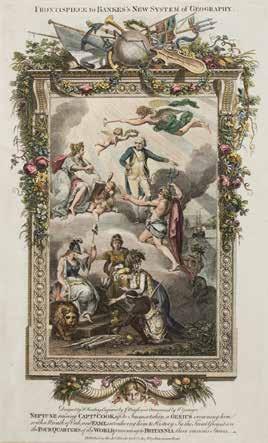
Cook’s exploration did not take place in uninhabited lands and seas, but among thriving voyaging cultures that were ultimately forced to submit to Europeans. It is important to remember the military factors in Cook’s and all other voyages in the Pacific and around Australia. They remind us of what underlined, if not defined, cross-cultural encounter moments. Addressing the fact that these expeditions were all of a military nature reminds us that European colonisation was resisted from its very first moments nearly 500 years ago.
References
1 J C Beaglehole (ed) 1955, The Journals of Captain James Cook on his Voyages of Discovery, Volume 1, Hakluyt Society, Cambridge University Press, p 409.
2 Ibid
3 The remaining cannon may now lie in Newport Harbor, Rhode Island –see Signals 125.
4 The secret orders note that Wallis described the Tahitians as ‘treacherous’. Beaglehole, op cit, ‘The Instructions’, page cclxxx.
5 See John Gascoigne, Science in the service of empire: Joseph Banks, the British state and the uses of science in the age of revolution, Cambridge University Press, Cambridge, UK, 1998.
6 Beaglehole, op cit, p 31.
7 The secret orders can be viewed in Under Southern Skies (the museum’s refurbished Navigators Gallery) from late April. They are also available online at the National Library of Australia: nla.gov.au/nla.obj-229102048/view
South Australian was one of the earliest vessels to ferry European settlers to the colony of South Australia
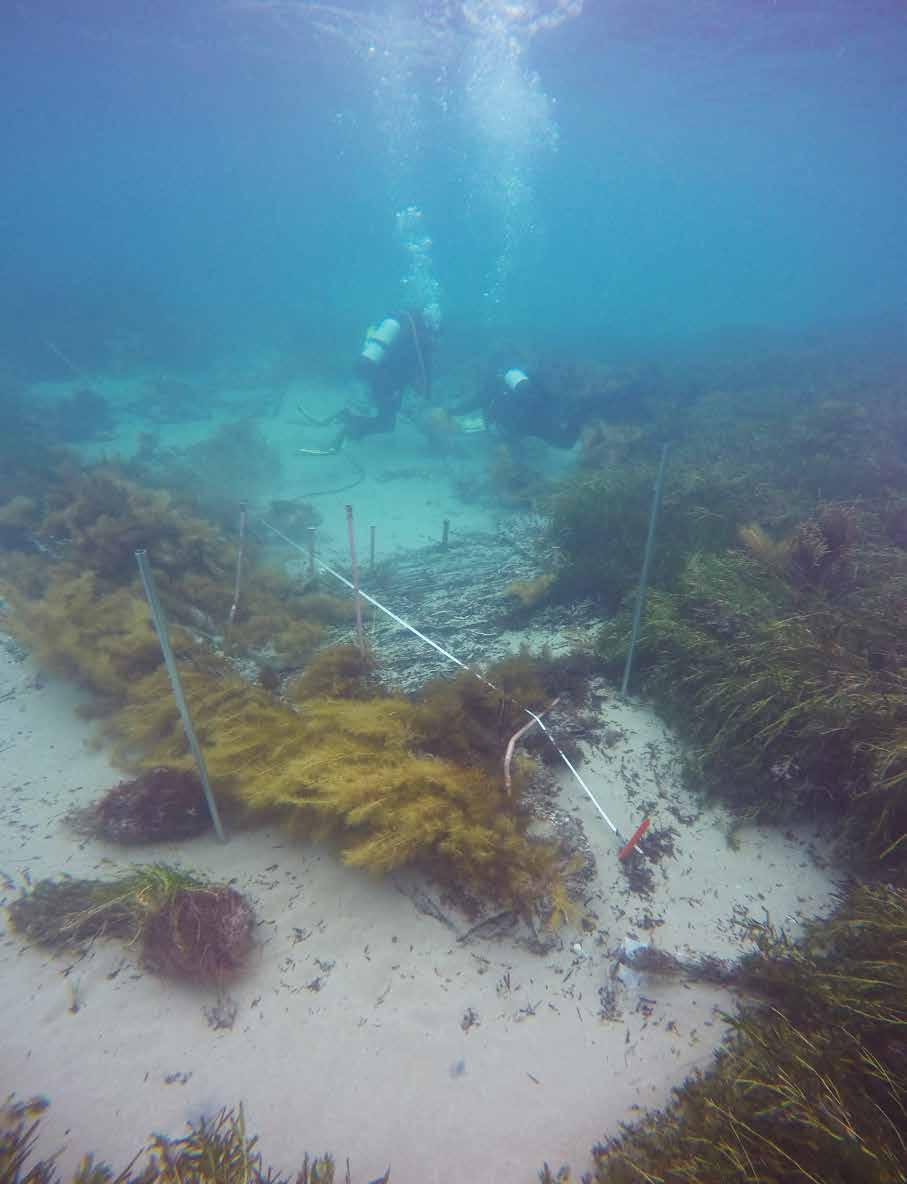
01
Silentworld Foundation maritime archaeologist Irini Malliaros and Flinders University Master of Maritime Archaeology student Tim Zapor document South Australian ’s bow section in June 2019. The vessel’s stem post and bow cant frames are visible in the foreground. Image James Hunter/ANMM
02
This early-19th-century ceramic mineral water bottle was one of the artefacts that helped confirm South Australian ’s identity. It was very likely manufactured in Germany, the world’s largest manufacturer of mineral water at the time. Image Irini Malliaros/Silentworld Foundation
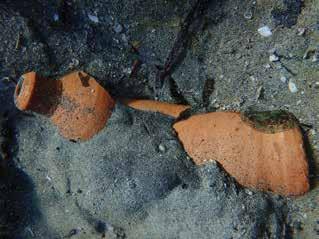
Nearly 200 years after its loss, the barque South Australian was relocated by a research consortium that included the museum’s maritime archaeology team. Dr James Hunter and Kieran Hosty share the story of South Australia’s oldest recorded European shipwreck, and the effort to find, document and preserve it.
SHORTLY AFTER 5 AM ON 8 DECEMBER 1837, Captain J B T MacFarlane peered into the grey dawn with a growing sense of dread. From the weather deck of the barque South Australian, he could just make out the lee shore of Rosetta Harbour, a short distance to the north and west. Located along the southern coast of the Fleurieu Peninsula in the fledgling colony of South Australia, Rosetta Harbour was the anchorage for three shore-based whaling stations and the watercraft that supplied and supported them. South Australian was one such vessel, and had been moored in the harbour for about a week as its crew prepared to load the whaling stations’ takings for the season. The harbour was suitable when seas and winds were calm, but completely open to the south and southeast, and susceptible to the worst weather the Southern Ocean could throw at it.
‘A very heavy gale with a tremendous sea’
MacFarlane now found his vessel at the mercy of a southeasterly gale that steadily increased in fury as the sun rose above the horizon. At 10.05, the chain to South Australian ’s starboard bower anchor parted; MacFarlane mustered all hands and ordered them to quickly deploy the barque’s sheet anchor –an action of absolute last resort. This steadied the barque, but the reprieve was brief: at 11 am, a severe squall screamed through the anchorage, followed by another at 2 pm that caused South Australian to ‘labour and pitch very heavy’ at its two remaining anchors.1 The wind and sea state were still increasing three hours later when both anchor cables parted from the strain. Now adrift, South Australian was pushed towards a thin strip of reef that divided Rosetta Harbour from east to west. The barque struck at 5.30 pm, and its rudder was wrenched away as it passed over the reef. Adrift once more, South Australian finally grounded and bilged in shallow water a short distance from shore.
Nearly 200 years later, in April 2018, we were part of a collaborative team comprising maritime archaeologists, museum specialists, students and volunteers from Silentworld Foundation, South Australian Maritime Museum, South Australian Department for Environment and Water, MaP Fund and Flinders University that successfully located South Australian. The discovery is of considerable importance, as the vessel is South Australia’s oldest known European shipwreck. It was also one of the earliest vessels to ferry European settlers to the colony of South Australia, and is currently the only example in the world of a purpose-built postal packet to have been archaeologically investigated.
Postal packet to processing platform
South Australian was launched as Marquess of Salisbury at Falmouth, England, in 1819. 2 Originally rigged as a ship, the 236-ton vessel was designated a Falmouth packet, a unique class designed to quickly carry mail between Great Britain and overseas ports within its far-flung empire. Its owner and master, Thomas Baldock, was a former naval officer who had served with distinction in North America during the War of 1812. In 1824, Marquess of Salisbury was purchased by the Royal Navy, renamed HMS Swallow and commissioned as a naval packet. Baldock was reappointed to the Royal Navy the same year and given command of Swallow, then embarked upon a number of transatlantic voyages to North and South America and the Caribbean. While under the command of Baldock’s successor Lt Smyth Griffith in 1834, Swallow was dismasted in Cuban waters during a hurricane and underwent significant repairs in Havana. Two years later, it was decommissioned and sold to the South Australian Company (SAC), a British mercantile enterprise founded in 1835 to establish a colony of free European settlers in what is now South Australia.
After the SAC acquired Swallow in September 1836, it was re-rigged as a barque and renamed South Australian. The hull was adapted to transport migrants, although the SAC’s ultimate intention was to use the vessel for whaling upon its arrival in the colony. South Australian departed Plymouth in December 1836 under the command of Captain Alexander Allen. Aboard was a contingent of primarily British and German emigrants, including David McLaren (the SAC’s second commercial manager), John and Samuel Germein (credited as the founders of Germein Town, South Australia) and ship’s surgeon Dr William H Leigh. The passengers were mostly skilled labourers. Also aboard were breeding stock including bulls, heifers, pigs and cashmere goats. South Australian arrived at Kingscote on Kangaroo Island on 22 April 1837, where its passengers and cargo were discharged.
In May, South Australian left Kangaroo Island with whaling equipment and provisions for shore-based whaling stations at Rosetta Harbour. While there, Captain Allen was ordered to refit it as an offshore whale processing platform, or ‘cutting-in’ vessel. South Australian completed one last round-trip voyage to Kangaroo Island in November 1837. Now under the command of Captain MacFarlane, it arrived back at Rosetta Harbour at the end of the month and the crew prepared the whaling station’s produce for shipment aboard Solway, another SAC vessel.
During the wrecking event on 8 December, South Australian grounded in front of the Fountain Inn, the only structure then present on Rosetta Harbour’s shoreline that still stands today. Aboard were David McLaren, John Hindmarsh Jr (son of South Australia’s first governor, Rear-Admiral Sir John Hindmarsh) and Sir John Jeffcott (South Australia’s first chief justice). The wreck was extensively salvaged over subsequent weeks, although South Australian ’s logbook notes that the lower hold was flooded and could not be accessed. In an ironic twist, Solway finally arrived at Rosetta Harbour two weeks later than expected, but was lost on 21 December 1837, under circumstances almost identical to those of South Australian.
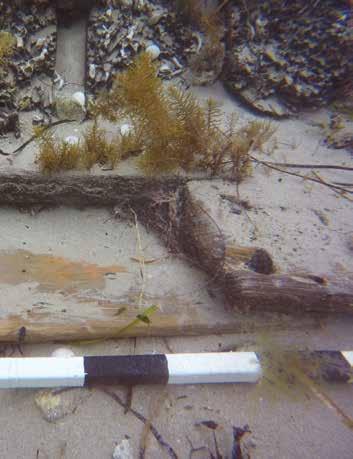
In subsequent years, South Australian broke up and eventually disappeared, its exact location lost to memory. Historic charts and sketch maps created shortly after the wrecking event, however, provided a relatively clear indication of where the loss occurred. This information, as well as anecdotal evidence from local residents and the results of remote-sensing surveys conducted in the 1990s by maritime archaeologists affiliated with South Australia’s then-Department of Environment and Heritage, enabled our team to establish a refined search area for the wreck in early 2018.
The survey area was split into 12 grids, each 10 metres square. Due to inclement weather during the first three days of fieldwork, our efforts initially concentrated on inshore reef flats. A metal detector survey was undertaken to search for debris that could help pinpoint the shipwreck’s location. On the first day, several artefacts of interest were identified, including iron fasteners, copper sheathing and hull timber fragments – the latter of which featured adhering copper-alloy sheathing and/ or fasteners. On 19 April, with weather improving, the team undertook a magnetometer survey seaward of the reef edge. We located a number of large magnetic anomalies, one of which was tentatively identified as iron standing rigging.
Early the next morning, the shout of ‘pink tubes!’ could be heard across the waters of Rosetta Harbour when a team member located a series of copper-alloy bolts poking above the sand and seagrass in shallows directly offshore from the Fountain Inn. During subsequent dives, we recorded additional hull features and small finds that – when taken in conjunction with the site’s geographic location – confirmed its identity as South Australian.
01
Double planking in the recentlyexposed midships section was probably used to repair and reinforce South Australian ’s ageing exterior hull. Note the higher degree of preservation exhibited by the planks when compared to the worm-eaten frames just above them that have been uncovered for much longer. Image Kieran Hosty/ ANMM
02
From left: Maddy Chadrasekaran (Flinders University maritime archaeology student), Rick Bullers (maritime archaeologist, SA Department for Environment and Water) and Tim Zapor conduct a metal detector sweep within shallows just inshore of South Australian ’s wreck site. Image Irini Malliaros/Silentworld Foundation
Historic charts and sketch maps created shortly after the wrecking event provided a relatively clear indication of where the loss occurred
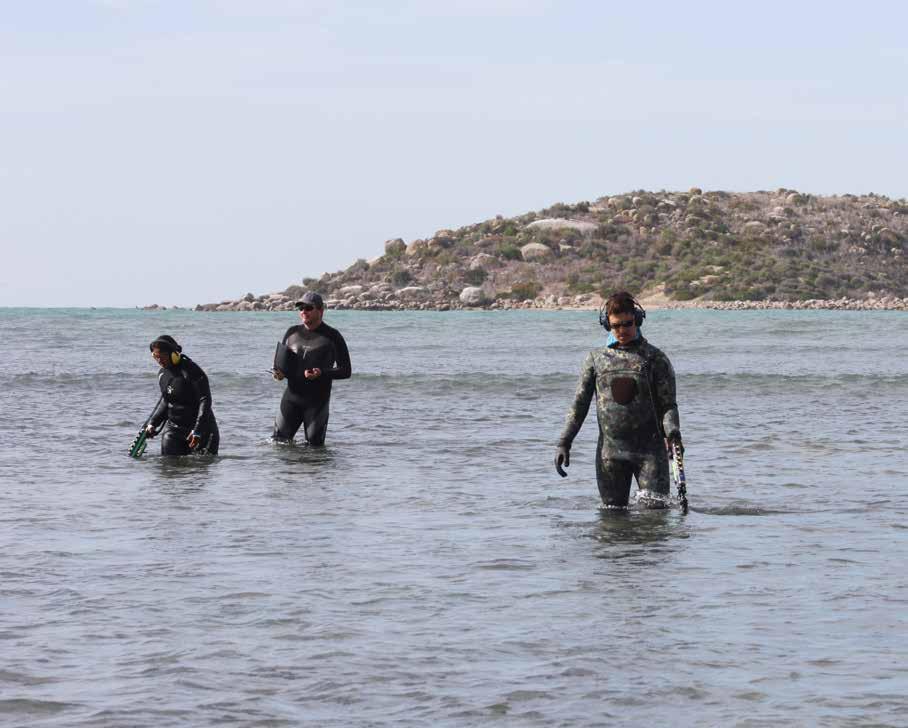
01
Irini Malliaros removes a timber sample from one of South Australian ’s ceiling planks. Some of the ‘pink tubes’ (copper-alloy bolts) that led to the shipwreck’s discovery are visible in the foreground. Image Tim Zapor
02
James Hunter (left) and Kieran Hosty use baseline-offset mapping to record the hull structure in South Australian ’s bow. Image Tim Zapor

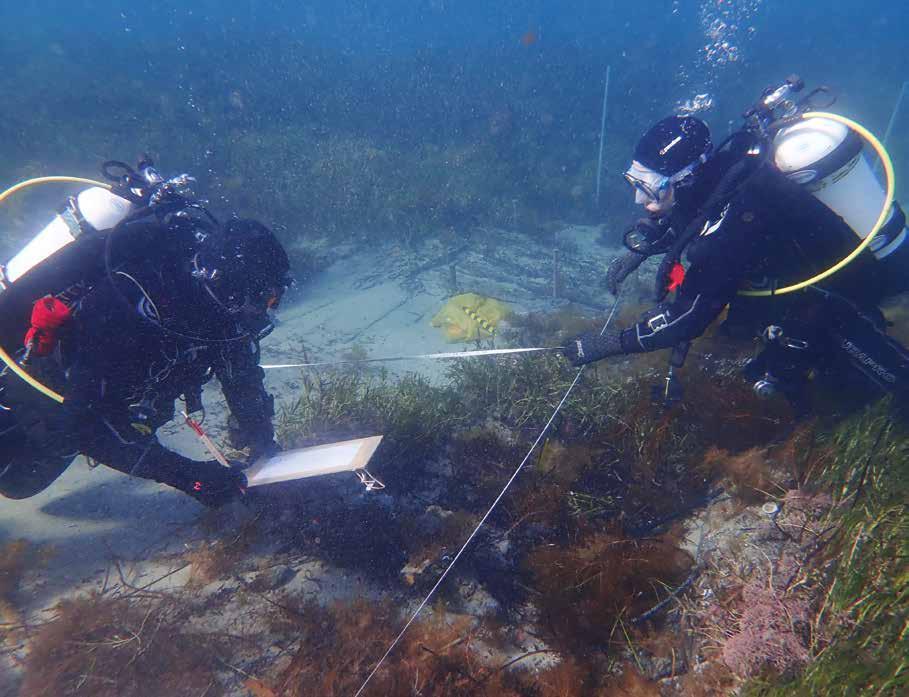
The wreck site has until very recently been protected by a covering of sediment and seagrass, which for some reason is now eroding away
Despite the shipwreck’s exposed position, most – if not all –of its lower port hull survives intact, while the starboard side is less well preserved. Articulated hull components include the keel and keelson, floors and futtocks (the frames, or ‘ribs’, of the ship), bow cant frames, hull (external) planking, ceiling (internal) planking, remnants of the foremast step and portions of the stem assembly. The remarkable state of preservation indicates that the site has up until very recently been protected by a covering of sediment and seagrass, which for some reason is now eroding away.
The arrangement of the bow cant frames suggests a vessel with relatively fine lines. This reinforces the site’s identity as South Australian, given that Falmouth packets were typically designed for speed. The lower portion of the hull is doubleplanked and covered in copper-alloy sheathing, indicating that the vessel operated in tropical waters and underwent extensive refit and repair to prolong its use. Species identification of timber samples recovered from the wreck revealed the vessel was constructed mainly from white oak (Quercus robur); however, other samples yielded unusual or unexpected results. For example, the exterior layer of the double hull planking was Swiss pine (Pinus cembra), while some treenails were teak (Tectona grandis). Both species are atypical for early19th-century British-built ships (which were almost exclusively constructed of white oak) and were probably used in later repairs to South Australian ’s ageing hull.
A range of artefacts was observed, including intact glass bottles, glass and ceramic fragments, bricks, wooden barrel staves, gunflints and various copper–alloy and iron fastenings. The bottles and decorated ceramics all date to the early 19th century, and the bricks and barrel components could comprise whaling supplies that were stowed in the vessel’s lower hold and could not be salvaged. Taken together, the date range and types of artefacts in the assemblage all support the wreck’s identity as South Australian.
In the wake of South Australian ’s discovery, follow-up surveys and site inspections were carried out in May and July 2018, and again in June 2019. These visits revealed that sediment has steadily eroded from the site and uncovered extensive hull structure in the bow and midships areas. This has been beneficial in documenting the site, but has also exposed the wreck’s fragile timbers and artefacts to damage and destruction from natural processes, including marine borers, wave action and sediment scour. Previously buried portions of the port hull have progressively become more visible since April 2018, and a large seagrass-covered sediment mound that still protects much of the stern was observed to be eroding in June 2019.
The speed and extent to which these areas have been uncovered has alarmed our team and underscored the need for additional investigation of the wreck and the development of strategies to aid South Australian ’s future management and protection. The team hosted a community meeting in Victor Harbor in December 2019 to announce our findings and gauge community support for conservation management options. These range from completely covering the site in sandbags to partial or complete archaeological excavation. Community consultation is ongoing, and we plan to revisit the site later this year to continue our investigations.
1 Logbook of the Barque South Australian (27 October – 21 December 1837), Entry for Friday, 8 December 1837. Royal Geographical Society of South Australia, MS 95c.
2 Although officially named Marquess of Salisbury, the vessel is listed in some archival sources – including Lloyd’s Register of Shipping – as Marquis of Salisbury. The variation in spelling is likely a common transcription error in which the French ‘Marquis’ was used in place of the English ‘Marquess’. Marquess of Salisbury was named for the 7th Earl of Salisbury, James Cecil, who was bestowed the title 1st Marquess of Salisbury in 1789. Cecil served as Joint Postmaster General from 1816 to 1823 and oversaw the Falmouth packet service during his tenure.
Further reading
Bullers, Rick, 2018, ‘South Australian news: Search and discovery of South Australian ’, AIMA Newsletter, Vol 37 No 2, pp 12–14.
Bullers, Rick, Malliaros, Irini and Hunter, James, 2018, ‘The barque South Australian: Discovery and documentation of South Australia’s oldest known shipwreck’, AIMA Newsletter, Vol 37 No 2, pp 15–19.
Heritage South Australia, DEW, 2018, Historic Shipwreck South Australian (1819-1837): Conservation Management Plan. Government of South Australia, Department for Environment and Water, Adelaide.
Hunter, James, ‘Barque South Australian ’, SA History Hub, History Trust of South Australia (sahistoryhub.com.au/things/barque-south-australian). Accessed 12 February 2020.
Parsons, Ronald, 1981, Shipwrecks in South Australia, 1836–75. Ronald Parsons, Adelaide.
Pawlyn, Tony, 2003, The Falmouth Packets 1689–1851. Truran, Truro (Cornwall).
Commerson’s cabin boy, ‘Jean’, was actually a woman named Jeanne Baret
The first known image of Jeanne Baret, from 1816. Although her disguise is unlikely to have looked like this (especially with a revolutionary cap), the foliage signifies her dedication to botany.
From Navigazioni di Cook del grande oceano e intorno al globo, Volume 2, 1816, Sonzogono e Comp, Milano. Reproduced courtesy State Library of NSW FL3740703
‘She will be the first woman that ever made it’
Jeanne Baret was a talented and ambitious young woman who escaped a life of rural poverty in the mid-18th century and, disguised as a man, set out on a risky journey of botanical discovery. In doing so she became the first woman known to circumnavigate the globe, writes Myffanwy Bryant .
IN SEPTEMBER 2019, 77-year-old British woman Jeanne Socrates became the oldest person to circumnavigate the world alone, non-stop and unassisted. It was an enormous achievement in the history of sailing. She attributed her success to the fact that she had ‘persevered and overcome so many problems on the way around’.1 Another Jeanne, 250 years earlier, might well have laughed wryly at this understatement. In her own way she had also circumnavigated the world and overcome various trials, although in her case it had taken nine long years to get home.
In 1767, Europe was in the midst of the Enlightenment. European powers had a mania for exploration and were scrambling for new territories and trading partners. With scientific aspirations and wide political support, King Louis XV of France agreed to an expensive round-the-world expedition headed by Louis de Bougainville. This ambitious journey – the first of its kind for France – was as much a display of power and influence as a practical expedition of discovery. The ships assigned for the trip were the frigate Boudeuse and the slower supply ship Etoile. The Etoile carried a mixed bag of officers and crew under the leadership of the experienced and level-headed Captain François de la Giraudais.
Philibert Commerson was awarded the role of expedition botanist directly by the king, and was directed to ‘make all the observations and relative discoveries on the coasts and even in the interior of the various countries’.2 Such an ambitious undertaking allowed Commerson his own cabin to house the extensive equipment and resources that would be required. He was also permitted to bring a personal assistant. Commerson was known for being particularly zealous in his collecting, often at a high physical cost to himself. His intensity was also reflected in a difficult personality. He was described as ‘waspish’, with little tolerance for those who did not support his endeavours. Ambitious, judgmental and single-minded, he was not the ideal candidate for a two-year journey at sea. It would be difficult to imagine a more hostile environment than below the decks of an 18th-century naval ship, where hardened men lived by their own rules to survive in cramped and confronting conditions for years on end. So at Rochefort in western France in February 1767, when Commerson and his servant boarded the Etoile, their trepidation must have been considerable. Neither had been on a ship before and neither could have anticipated the conditions they were walking into. This was perhaps more so for Commerson’s cabin boy, ‘Jean’, who was actually a woman named Jeanne Baret.
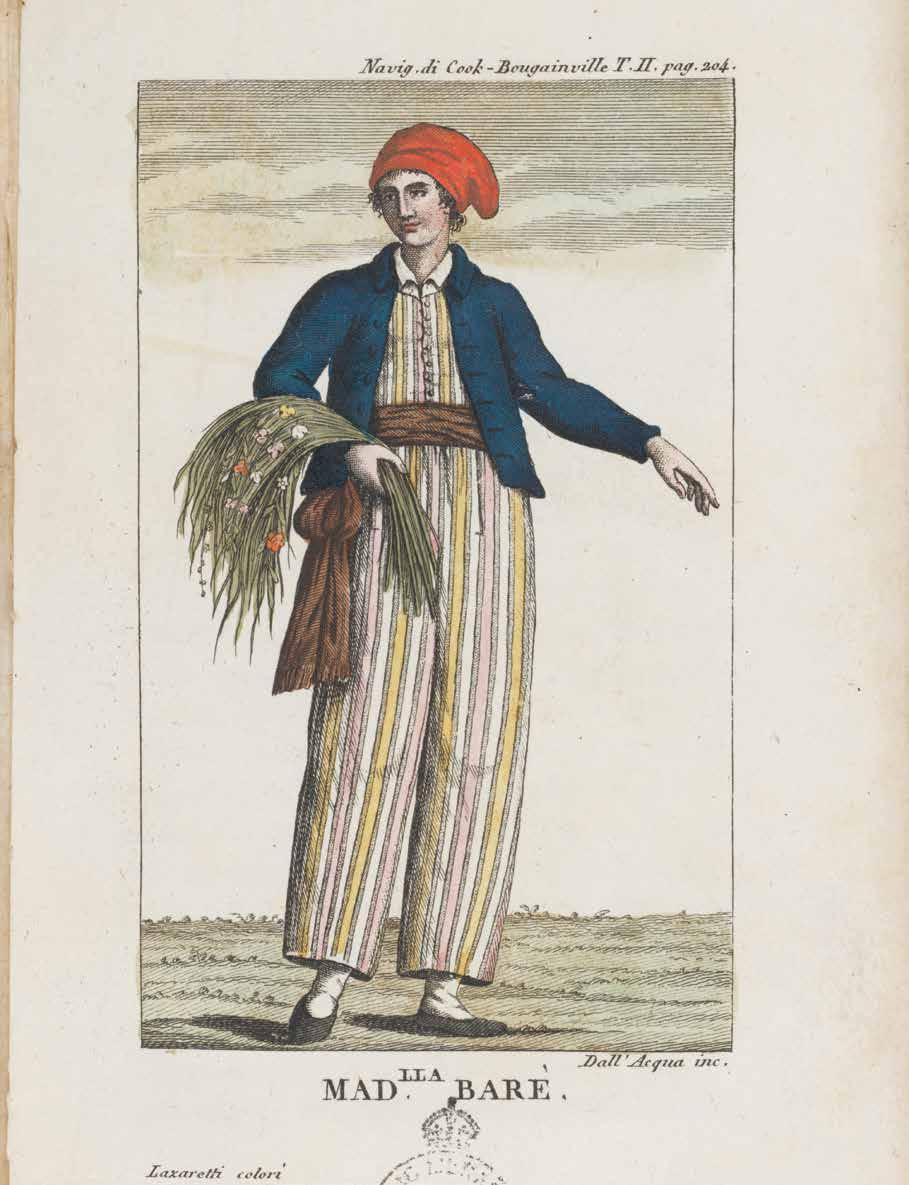
With scientific aspirations and wide political support, King Louis XV of France agreed to an expensive roundthe-world expedition

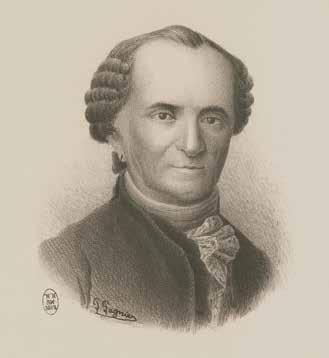
01 Portrait of Louis de Bougainville by Louis Boilly. Bougainville was a highly acclaimed naval and military commander who also showed sensitivity and respect for Jeanne, and ensured she was not forgotten later in life. National Library of Australia nla.obj-296177599
02 Philibert Commerson by P Pagnier, 19th century. Image © Muséum National d’Histoire Naturelle, Paris
Jeanne had been born in rural Poil, in central France. Although poor, she was clearly intelligent and determined enough to make her way out of her tiny village to the nearby town of Toulon-aux-Arroux, a world away from where a woman in her circumstances could have expected to end up at that time. Here she became housekeeper for Commerson and began to assist him in his botanical work. Over time, with Commerson’s physical ailments restricting him more and more, Jeanne seems to have become indispensable. When Commerson moved to Paris to further his career, Jeanne accompanied him.
Much has been made of Jeanne’s devotion to Commerson and she is often referred to primarily as his lover. But while she was in a relationship with Commerson, theirs was not an adolescent romance – they were 27 and 40 respectively – nor did Commerson’s personality suit the ideal of a romantic hero. This narrow view also reduces Jeanne’s role in Commerson’s life to an accessory and certainly undermines her own individual achievements. For it is clear that both were ambitious, and over time their partnership grew into one of dependency and collaboration. They never married, although they had a son together whom they adopted out, and their story was much more complex than that of a master and a housekeeper restrained by class conventions.
We can only speculate on what happened when Commerson was awarded his coveted role on Bougainville’s expedition, and it is easy in hindsight to attribute reasons for the risks the pair took. Did Jeanne ask to accompany Commerson out of loyalty, or because of her own intellectual pursuits or a desire for new experiences? Or did Commerson ask Jeanne to come, realising that he was unlikely to achieve his scientific goals without her assistance? While a male apprentice might have provided professional support, Commerson’s persistent ill health now required a personal carer also, and to reveal this might have jeopardised his prized royal appointment. In Jeanne, he had the best of both roles. Their decision probably combined all of these reasons, both knowing this opportunity was too important to turn down.
Jeanne was certainly not the first male impersonator in the 18th century. Some, such as soldier Hannah Snell or pirate Mary Read, both British, were celebrated through ballads, books and stage shows. There were probably other women whose true identity was never revealed. Of those who were exposed and told their stories, there were accepted reasons – mainly romantic or patriotic – that explained their unconventional actions. Mostly, they were thought to have assumed a disguise to follow a lover – with the assumption that they would later live happily ever after – or to fight for their country. Whatever narrative was spun, these wayward women would always return safely home and resume a traditional female life. Part of the appeal of such stories for the public was how the women managed to keep their disguise amid groups of men. For Jeanne, heading into open oceans for years, it was of particular concern.
From the outset, life on the crowded 104-foot (32-metre) Etoile was difficult. Commerson was sick for weeks and a persistent leg ulcer confined him largely to the cabin. Although this might have supplied a plausible reason for ‘Jean’ to be constantly by his side, including sleeping in his cabin, suspicion grew quickly on board at the devotion the cabin boy showed his master. When the Etoile reached Rio de Janeiro in June, the suspicions about Jeanne appear to have become more solid, with one source suggesting that de la Giraudais was informed of the deceit happening under his nose. 3 When the expedition left in November, however, Jeanne and Commerson remained aboard, accompanied by a bulging collection of specimens foraged ashore.
Bad weather dogged the onward journey and unresolved tensions continued to fester. Commerson equated shipboard life to living like a mouse in a trap, where ‘nothing can be done and one can only gnaw at the bars’.4 When the exhausted expedition reached Tahiti in April 1768, the ruse was finally exposed –not by the Etoile crew, but by the Tahitians. Bougainville records that they took one look at Jeanne and knew she was a woman. His journal entry on the event is brief but very telling, and records the lies Jeanne told in an attempt to mitigate the deception:5
For some time there was a report in both ships, that the servant of M de Commerçon, named Baret, was a woman. His shape, voice, beardless chin, and scrupulous attention of not changing his linen or making the natural discharges in the presence of anyone, besides several other signs, had given rise to, and kept up this suspicion. But how was it possible to discover the woman in the indefatigable Baret, who was already an expert botanist, had followed his master in all his botanical walks, amidst the snows and frozen mountains of the Strait of Magellan, and had even on such troublesome excursions carried provisions, arms, and herbals, with so much courage and strength, that the naturalist had called him his beast of burden? A scene which passed at Tahiti changed this suspicion in to certainty. M de Commerçon went on shore to botanise there; Baret had hardly set his feet on shore with the herbal under his arm, when the men of Tahiti surrounded him, cried out, It is a woman, and wanted to give her the honours customary on the isle. The Chevalier de Bournand, who was upon guard on shore, was obliged to come to her assistance, and escort her to the boat. After that period it was difficult to prevent the sailors from alarming her modesty. When I came on board the Etoile , Baret, with her face bathed in tears, owned to me that she was a woman; she said that she had deceived her master in Rochefort, by offering to serve him in men’s clothes at the very moment he was embarking; that she had already before served a Geneva gentleman at Paris, in quality of a valet; that being born in Burgundy, and become an orphan, the loss of a law-suit had brought her to a distressed situation, and inspired her with the resolution to disguise her sex; that she well knew when she embarked that we were going round the world, and that such a voyage had raised her curiosity. She will be the first woman that ever made it, and I must do her the justice to affirm that she has always behaved on board with the most scrupulous modesty. She is neither ugly nor handsome, and is no more than twenty-six or twenty-seven years of age. It must be owned, that if the two ships had been wrecked on any desert isle in the ocean, Baret’s fate would have been a very singular one.
Despite Bougainville’s obvious admiration for Jeanne, and Commerson’s insistence that he had also been deceived by her disguise, the captain knew the situation must be resolved, both for Jeanne’s safety and French naval regulations at the time. While Bougainville clearly could not abandon Jeanne in Tahiti, neither could he return to France with her still on board after years at sea. And so Jeanne remained on Etoile, sequestered from the disgruntled men, enduring the ordeal as the months wore on. And wear on they did. The expedition became fraught with difficulties and was now a voyage of endurance rather than discovery. Food and water shortages exacerbated the sickness that ravaged the ship. After resorting to eating the ship’s rats, Bougainville at last ordered the ship’s dog to be served up to his starving officers. Adverse weather reduced the voyage to a sluggish crawl until at last the two ships limped into the colonies of the Dutch East Indies, and deliverance.
During their time at Mauritius, Jeanne and Commerson dedicated themselves to studying the flora of the region, collecting and recording more than 1,000 species
Solanum baretiae Tepe. Image courtesy Natural History Museum, London. Collection number BM001115161
While the most pressing concerns of the expedition had now been resolved, others lingered. It is likely that Bougainville realised that the scientific and exploration potential of the voyage was exhausted, as disappointing as that must have been. He set a course for the French settlement at Mauritius and home. And of course, there was still Jeanne. Bougainville had not forced her ashore in Batavia (present-day Jakarta, Indonesia) and perhaps he had always intended to leave her in Mauritius. He does not mention her again in his journal, but certainly when the expedition left Mauritius five weeks later, Commerson and Jeanne were left behind in Port Louis with the French governor, Pierre Poivre.
This arrangement did not raise as many questions as it could have, as Poivre himself was an avid botanist and had established an impressive botanical garden outside of Port Louis, which remains to this day. He enthusiastically engaged Commerson to study the surrounds, including Madagascar, and of course Commerson’s loyal servant remained with him. And so, after 22 months of hellish shipboard life, Jeanne found herself back on land and in relative safety. There is no record to indicate whether she shed her male disguise, but we do know she remained with Commerson on Mauritius until he died in March 1773. During their shared time there, the couple dedicated themselves to studying the flora of the region, collecting and recording more than 1,000 species, despite Commerson’s persistent ill health and dwindling finances.
With the death of Commerson, Jeanne was left to fend for herself. As had been the case on Etoile, Commerson had made few friends on the island, and dispatches back to Paris referred to him as being an ‘ill-natured man, capable of the blackest ingratitude’.6 Without money, status or social support, Jeanne survived; court records show she opened a tavern in Port Louis and in 1774 was married to Pierre Duberna(t).
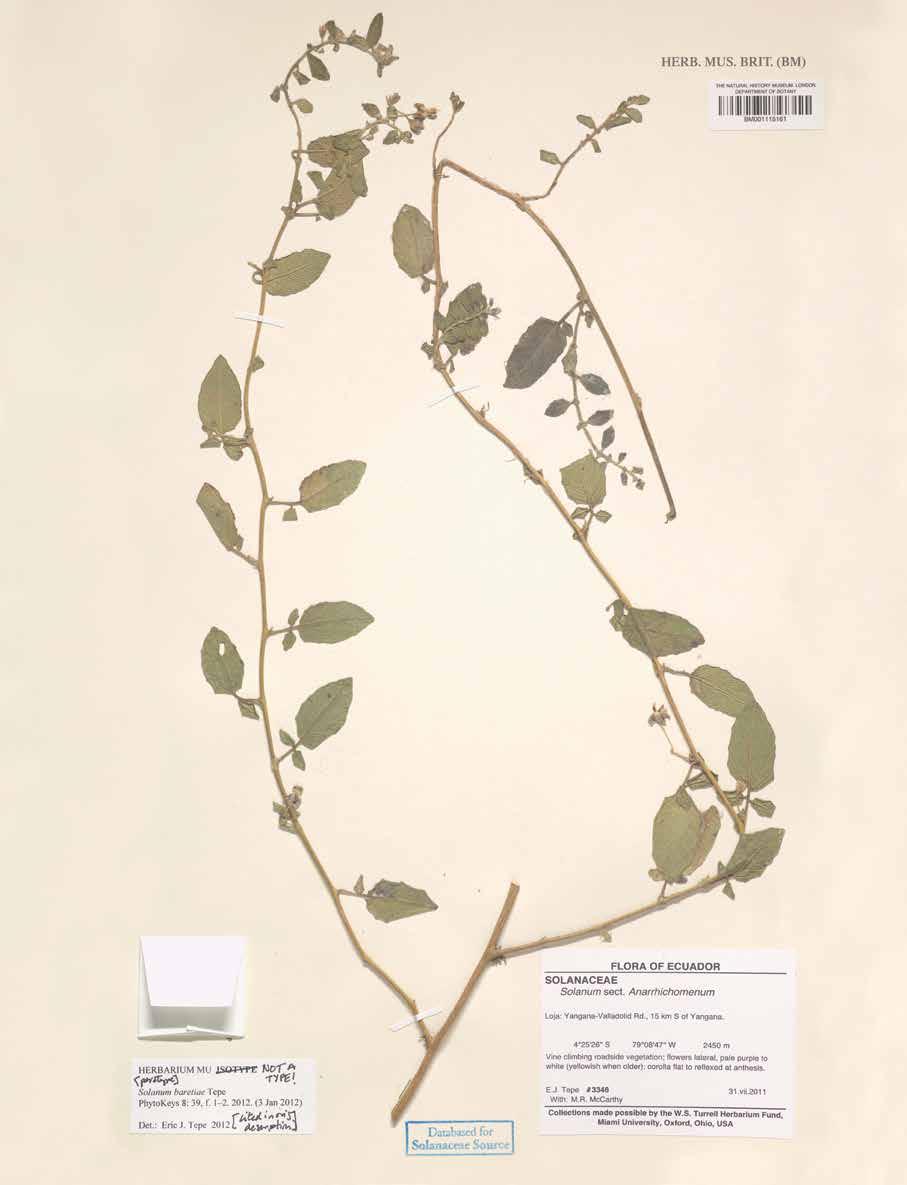
Jeanne eventually received a pension from the French navy for her courage and exemplary behaviour on the voyage
On her eventual return to France with her husband the following year, no publications appeared revealing salacious details. There were no theatre tours, ballads or public appearances. Nor were there any botanical publications authored by her or any discoveries attributed to her. Jeanne, true to the quiet fortitude she had always displayed, claimed some money that Commerson had left her in his will and settled into a rural life. But she had not yet been completely forgotten. Ten years after her return to France, Jeanne Baret was paid by the French navy. Despite having broken French naval code by joining the journey in disguise, Jeanne received a pension for her courage and exemplary behaviour on the voyage. It would seem that Bougainville, still an admirer of the very qualities he had observed a decade earlier, was now officially able to recognise Jeanne’s extraordinary achievement.
And so Jeanne passes quietly into history, largely unheralded and voiceless in a story where the voice most needed is hers. The novelty of Jeanne’s disguise, and the drama of her exposure and subsequent tribulations, should not overshadow the significance of her uncredited scientific achievements. Although the objectives of the Enlightenment directed much of her life, they were not intended for women of her class, of whom very little was expected. Jeanne’s ability to successfully overcome the restrictions of her origins, to embrace the mental and physical challenges of early botany, to constantly care for Commerson while in restrictive disguise and personal danger, is nothing short of extraordinary. And by making it back to France, she became the first woman known to have achieved a circumnavigation, of which Bougainville was well aware.
It was most likely Jeanne Baret who, in 1767, collected the popular bougainvillea plant that adorns so many Australian gardens today –yet no plant was officially named for her until 2012, when Solanum baretiae, a species of nightshade, was finally given the honour.
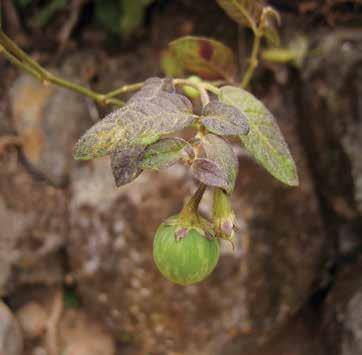
Commerson, despite his many faults, did try to name a species for Jeanne. They collected the plant that Commerson wanted to call Baretia in 1771 at Bourbon (now Réunion), but a decade later its name was changed to Quivisia
Despite this, Commerson’s sentiments at the time still hold true: 7
This plant is dedicated to the valiant young woman who, assuming the dress and temperament of a man, had the drive and audacity to travel throughout the world ... inspired by some divinity, she frustrated the schemes of men and beasts, risking on many occasions both her life and honour. We are indebted to her heroism for so many plants that have never before been collected, for so many herbaria carefully put together, so many collections of insects and shells, that it would be an injustice on my part, as it would be for any other naturalist, if I did not pay her the greatest tribute by dedicating this plant to her.
References
1 Aamna Mohdin, ‘British woman, 77, becomes oldest person to sail around the world alone’, The Guardian, 10 September 2019.
2 John Dunmore, Monsieur Baret, Heritage Press, Auckland (2002), page 35.
3 John Dunmore, The Pacific Journal of Louis-Antoine Bougainville 1767–1768 , Hakluyt Society, London (2003), page 228.
4 Dunmore, Monsieur Baret, page 55.
5 Bougainville, Louis, A Voyage around the World ..., John Nourse, London (1772), page 300.
6 Dunmore, Monsieur Baret, page 179.
7 Jeannine Monnier et al, Philibert Commerson, Association SaintGuinefort, Chatillon-sur-Chalaronne, 1993, page 98.
Myffanwy Bryant is a curatorial assistant at the museum.
Solanum baretiae, a species of nightshade named by Eric Tepe in 2012 in recognition of Jeanne Baret. Image courtesy Eric Tepe from the University of British ColumbiaMake a difference now and for generations to come.

Circle members
The Australian National Maritime Museum Foundation is the fundraising arm of the museum and holds funds to acquire major objects, conserve our collection and provide support for the museum and its programs.
Support our appeals in Signals
Whether small or large, every donation is greatly appreciated and makes a difference to the museum achieving our goals.
If you are planning to leave a gift to the museum in your will, we would appreciate knowing of your intention. We would welcome the opportunity to thank you and acknowledge your support by including you in our Benefactors’ Program. You will receive invitations to VIP events and tours and also be listed as a benefactor on the museum’s Honour Board. sea.museum/bequests
The museum seeks the support of maritime enthusiasts dedicated to supporting us to expand our collections and restore and conserve important artefacts. Donors who pledge $1000 each year for three years can join the Captain’s Circle and become VIP donors of the museum. These donors are acknowledged for their support and invited to our special events and we take you behind the scenes for money can’t buy experiences. sea.museum/captainscircle
Ambassadors
Ambassador status is given to those who have contributed more than $100,000 to the museum. These significant donors have helped acquire important works or supported historic vessels to ensure they are enjoyed for generations to come. Ambassadors are recognised on our Honour Board.
Here are some projects currently seeking support:
OBJECTS
The Souter Murals
Restoration work
DISCOVERY
The search for the Endeavour Sample analysis
EDUCATION
Underwater Museum
Program development
MIGRATION STORIES
Faces of Australia 2020
Exhibition development
INDIGENOUS
Alick Tipoti retrospectiveSpiritual Patterns
Purchase of artworks
For more information go to sea.museum/donate
Or contact Foundation Manager, Marisa Chilcott (02) 9298 3619
marisa.chilcott@sea.museum
Captain’s enjoyed a private tour of HMAS Hobart and were escorted by Lieutenant Dylan Woodland RAN.The museum acquires Sea Shepherd Australia’s Delta boat
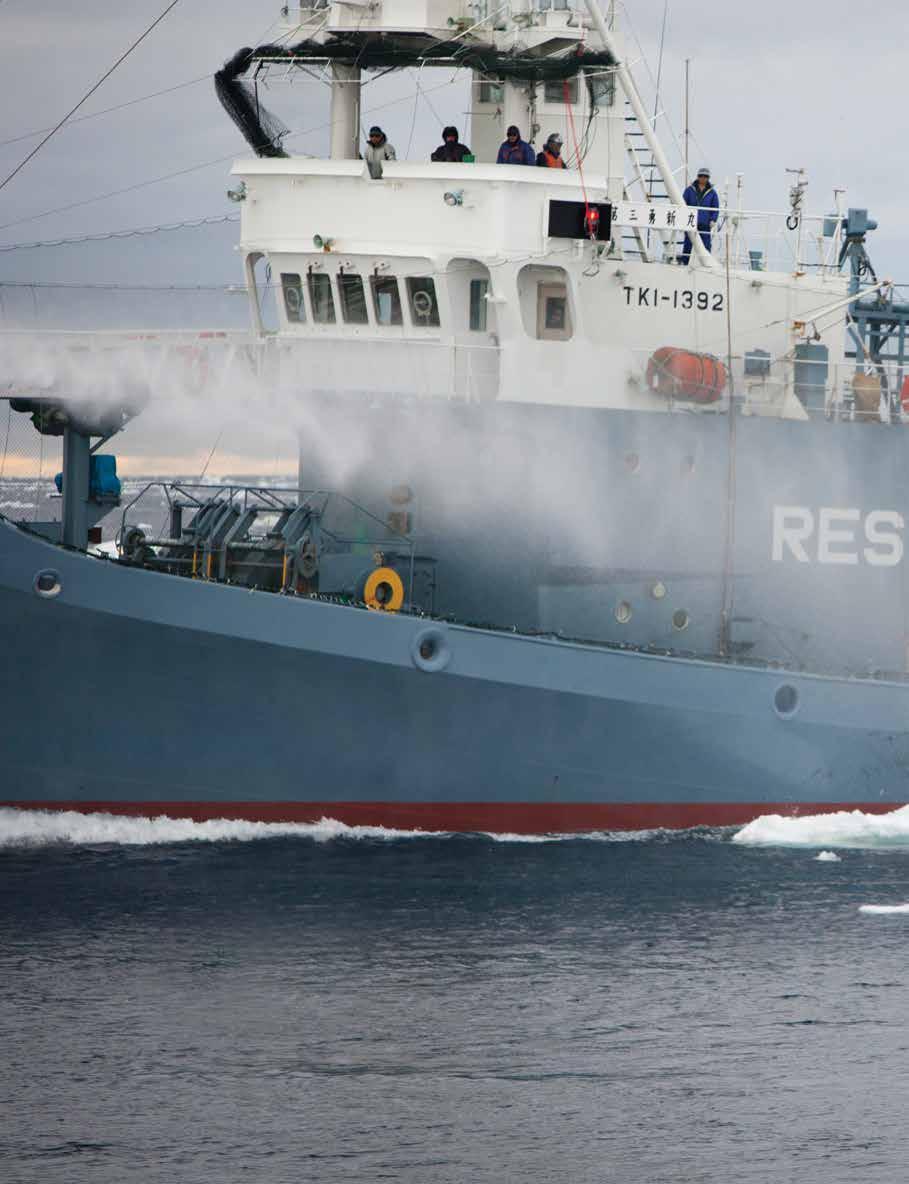
The Australian National Maritime Museum aims to acknowledge more than one perspective on our national maritime story. Curator Emily Jateff argues that ‘contentious histories’ like that of Sea Shepherd deserve a place alongside more mainstream narratives, and conservator Nick Flood outlines the behind-the-scenes work required to add a Sea Shepherd boat to the museum’s collection.
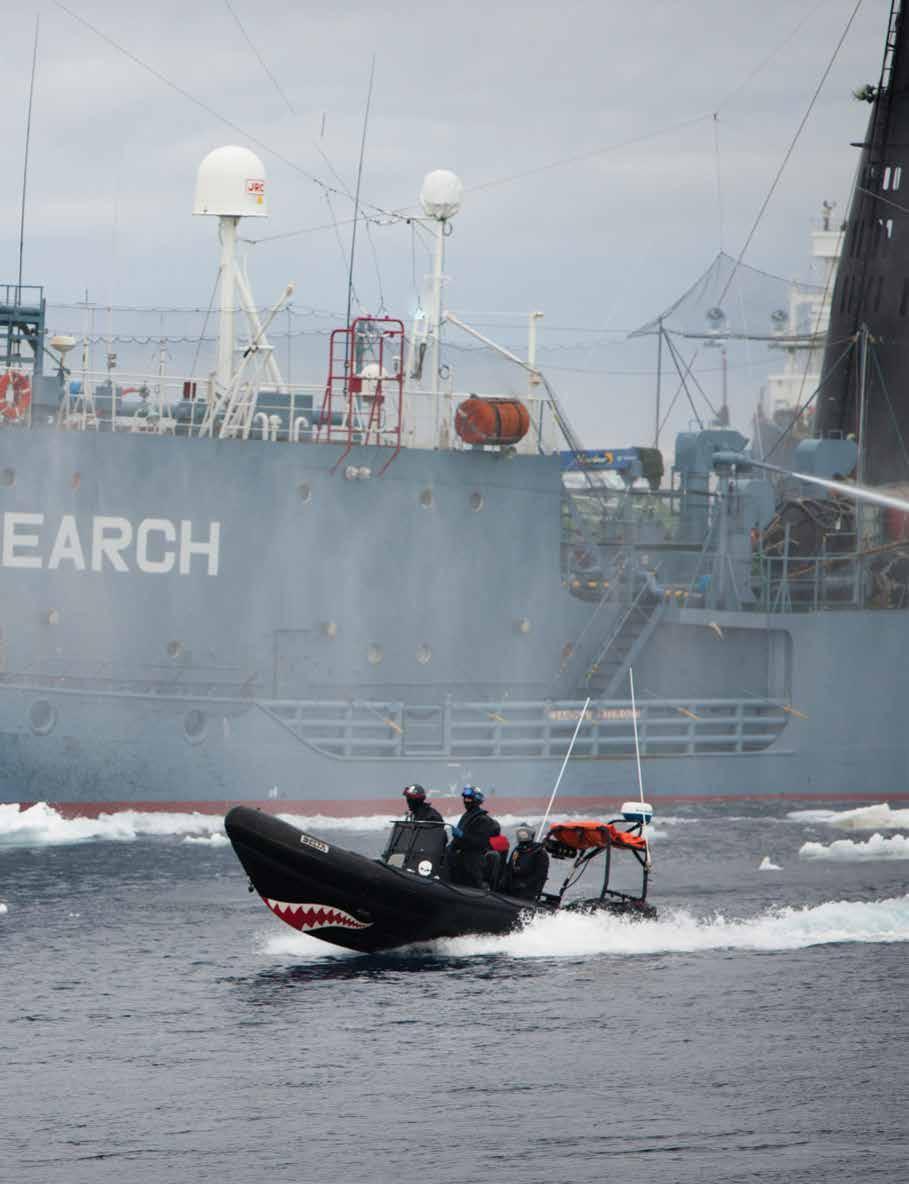
Sea Shepherd’s current mission is ‘to safeguard the biodiversity of our delicately balanced oceanic ecosystems and ensure their survival for future generations’
01
Tenders on board Steve Irwin during Operation Musashi, Sea Shepherd’s fifth Antarctic whale defence campaign. The Steve Irwin chased the Japanese whaling fleet for 3,200 miles, severely disrupting the hunt and saving more than 300 whales. Image © Sea Shepherd Australia
02 The small boat Humber in front of Steve Irwin during Sea Shepherd’s 10th Antarctic whale defence campaign, ‘Operation Relentless’. Image Eliza Muirhead/ © Sea Shepherd Australia
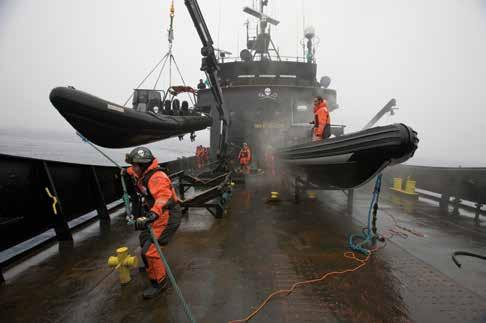
IN 2019, THE MUSEUM ACQUIRED Sea Shepherd Australia’s Delta rigid hull inflatable boat (RIB) for the National Maritime Collection, following the decommissioning of Sea Shepherd Australia’s flagship MY Steve Irwin. The Delta RIB is a black rubber and fibreglass ‘stealth boat’ with hand-painted shark jaws below the waterline on the bow.
The Delta RIB was acquired by Sea Shepherd Australia in 2006 as part of the ship’s complement of FPV Westra, an ex-Scottish Fisheries Protection Agency vessel rechristened MY Robert Hunter on arrival and changed to Steve Irwin in 2007. The Delta was used to conduct marine biological and ecological research, documentation and ‘non-violent direct action’ against whaling, shark finning and illegal by-catch fishing vessels via various campaigns in Australian and international waters from 2006 to 2018. From 2008 to 2015, MY Steve Irwin and its tenders, including the Delta, featured in seven seasons of the Animal Planet show Whale Wars. Alistair Allen, captain of Sea Shepherd’s MY Sam Simeon, says:1
The Delta is a very special boat in Sea Shepherd history ... It is the symbol, the fighter jet, the top gun. It was instrumental in Whale Wars , those little boats cutting in front of big ships. It went through everything. It has had an engine blow up, it has washed ashore, it has been beached in Antarctica and it has battled on. It is like Sea Shepherd, it keeps going.
In the early 1980s, the International Whaling Commission (IWC) called for a non-binding moratorium on commercial whaling from the 1985–86 season. This effectively limited the capture and killing of whales for commercial purposes, with special provisions for scientific research and localised and culturally significant subsistence whaling. In 1994, the IWC declared all areas below 40 degrees south latitude as the Southern Ocean Whale Sanctuary. The sanctuary drops to 55 degrees latitude in some areas of the Indian Ocean and to 60 degrees near the tip of South America and into the South Pacific.
Sea Shepherd began its operations in the Southern Ocean Whale Sanctuary with the specific directive to make commercial whaling financially non-viable. From 2005 to 2017, annual Southern Ocean operations departed from Hobart, Tasmania, and engaged each year with whaling vessels from the Japanese Institute for Cetacean Research (ICR). Sea Shepherd claims that during this period, they saved 6,000 whales.
The ICR conducted annual whaling operations in the Southern Ocean from 1987 to 2018 via the Japanese Whale Research Program, under Special Permit in the Antarctic (JARPA I and II), with the resultant whale meat sold to the Asian market in line with Article III.2 of the International Convention for the Regulation of Whaling. Sea Shepherd’s contention was that the ICR disguised commercial whaling for economic profit as scientific research. Author Jun Morikawa states that Sea Shepherd’s activities actually increased Japan’s resolve to continue whaling. 2
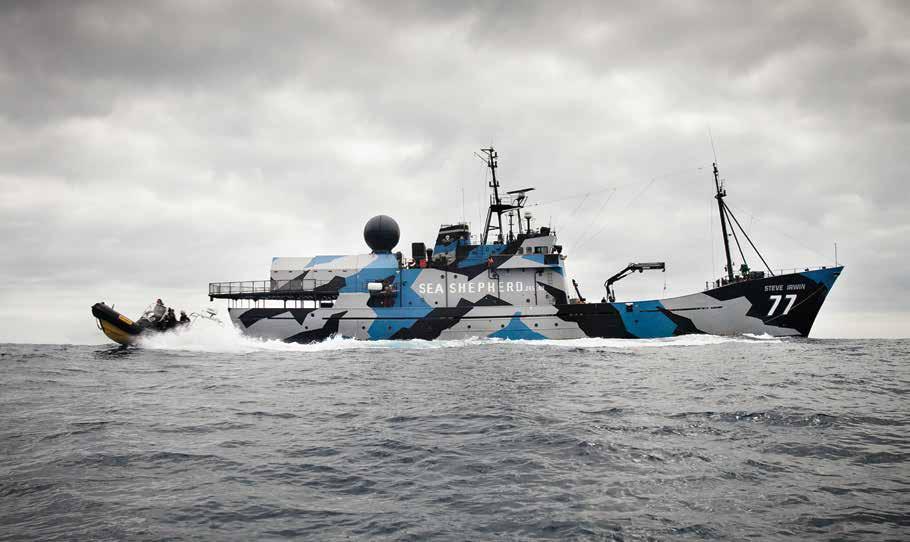
In 2010, Australia and New Zealand took the government of Japan to the International Court of Justice for conducting commercial whaling under the guise of scientific research. The court ruled against Japan on 31 March 2014 and refused to grant further scientific research permits to the ICR. A series of claims and counterclaims related to the Antarctic Treaty and its waters ensued, but the ICR continued to hunt for whale within the Southern Sanctuary. In 2017, Sea Shepherd suspended anti-whaling activities, stating that they could not compete with the ICR’s modern surveillance tactics. The ICR also concluded Southern Ocean whaling operations in 2018, ending its formal association with the International Whaling Commission and stating its intent to resume commercial whaling within its own waters from July 2019.
The Delta RIB featured in the 2008 Sea Shepherd campaign Operation Migaloo (‘white fella’), which was named after an Aussie icon – an albino male humpback whale first spotted along the eastern coast of Australia in 1991. On 15 January 2008, Steve Irwin located the ICR vessel Yushin Maru 2, tried to entangle its propellers and threw containers of butyric acid onto the decks. The Delta approached the vessel to try to deliver a letter stating that the Japanese were ‘whaling illegally’. Yushin Maru 2 detained Sea Shepherd members Benjamin Potts and Giles Lane for two days, then turned them over to the Australian Customs vessel MY Oceanic Viking. The Australian government tasked Oceanic Viking with filming the Japanese whaling fleet and used the footage as evidence in the International Court of Justice case. The footage was released to the public in 2017. This incident was widely covered in national and international media.
Over the next few years, Sea Shepherd deployed its Australian fleet to the Southern Ocean in a series of campaigns that raised questions about whether ‘non-violent direct action’ was an accurate description of their field methods.
Later in 2008, when it threw methylcellulose powder and butyric acid at Nisshin Maru, the Australian government condemned its actions. In Operation Mushashi (2008–09), there was a collision with Yushin Maru 2. The Australian Federal Police seized Sea Shepherd’s footage and logs upon its return to Hobart. In 2010, Sea Shepherd’s experimental vessel Ady Gil was struck by Shonan Maru 2 and sunk, with an arbitrator ruling in 2015 that the Sea Shepherd Conservation Society intentionally and wrongfully scuttled the vessel to raise sympathy for the cause. By this time, Sea Shepherd had garnered a reputation for hazardous high-seas behaviour:3
The best way to stop the Sea Shepherd activities, which even Greenpeace says are dangerous, is for the Abbott Government to ban the entry of its vessels into Australian ports.
Sea Shepherd Australia’s organisational directive has distanced itself from the ‘non-violent direct action’ of the past. The current mission of the Australian arm of Sea Shepherd is ‘to safeguard the biodiversity of our delicately balanced oceanic ecosystems and ensure their survival for future generations’.4
The Sea Shepherd Australia collection allows us to explore issues such as technology, conservation, marine law and sustainability
01
The Great Australian Bight Alliance was formed in 2016 to prevent deep-sea drilling within the Great Australian Bight. This flag is from the first voyage of MY Steve Irwin to the bight in 2016. ANMM Collection
02
For three days in 2012, the Sea Shepherd ship Steve Irwin led the Japanese harpoon vessel Yushin Maru No 3 deeper into the pack ice of the northeast part of the Ross Sea. Photographer unknown. Image © Sea Shepherd Australia
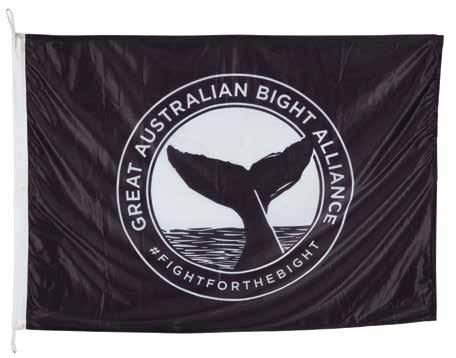
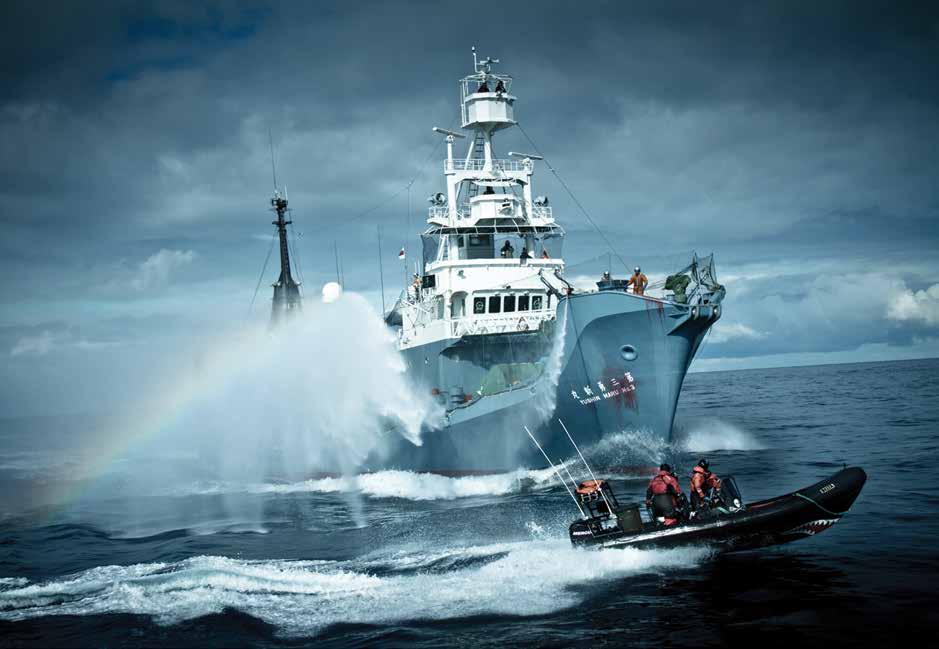
Captain Alistair Allen has been with Sea Shepherd for almost a decade. While travelling in Spain at 19 years of age, he walked around a corner in Barcelona and saw the Steve Irwin. He started on the ‘Steve’ as a deckhand and came back for the 2013 campaign, Operation Relentless, which was also his first time driving the Delta. In 2014, Allen took part in his first operation targeting illegal fishing – which marked an organisational switch to combating these infractions instead of whaling. Allen had many hours on the Delta off the Australian coast and in Antarctic waters, ‘just in that little boat in the middle of nowhere, hundreds of miles from shore’. He speaks of the RIB with affection and respect, and refers to specific operations and tactics that will be included in a subsequent blog on the Australian National Maritime Museum’s website. It is Allen’s belief that this is what Sea Shepherd has been working towards all along: ‘In early years they were fighting with the government, whereas now they are working with governments’. 5
Sea Shepherd now has an agreement with the government of Liberia to assist the repression of illegal fishing in their exclusive economic zone (EEZ). Thirty-three thousand Liberians rely on fishing to survive. Since 2017, Sea Shepherd has used their vessels’ capability to reach the extent of the Liberian EEZ, leading to the arrest of 15 illegal fishing vessels. Alistair Allen reports that the government is regaining control of its waters and local fishers are reporting less negative impact: ‘The country is able to return to their normal ways of living’.6
The Australian National Maritime Museum has also acquired three flags, from more recent Sea Shepherd Australia campaigns, for the National Maritime Collection. Operation Reef Defence is the campaign to stop the development of the Adani Carmichael coal mine in Queensland. In 2018, Steve Irwin travelled up the east coast of Australia and stopped at various ports along the way, connecting with audiences, selling merchandise and providing tours of the vessel and information about its campaigns.
Operation Jeedara (2016 and 2018) is a joint campaign with the Great Australian Bight Alliance to raise awareness of the unique biodiversity of the Great Australian Bight through documentary film, and thereby hamper plans for oil and gas exploration in the area. Sea Shepherd claimed early success in 2017, after Chevron and BP pulled their request for exploration permits. The oil company Equinor is now inching closer to receiving approval from the National Offshore Petroleum Safety and Environmental Management Authority (NOPEMA) to conduct oil and gas exploration activities in the area. Sea Shepherd’s Operation Jeedara campaign continues.
A fundamental part of the Australian National Maritime Museum’s role is to document and preserve Australia’s maritime heritage. When we think about making acquisitions, we are looking not just at how we can use that object now, but how future generations of historians, curators and visitors might interpret the object and understand its place in our collective national history.
Our focus today is on Australia’s relationship with the seas, oceans and rivers, in a broad sense. This includes issues such as technology, conservation, marine law and sustainability –all issues which the Sea Shepherd Australia collection allows us to explore through a compelling and dramatic series of human stories. These stories also reflect the changing attitude towards whales and whaling in Australia’s political and social history –where we have shifted from a nation with a substantial whaling industry to one that leads the world in opposing whaling and advocating this position on a global stage.
More than 250,000 people – or 1 per cent of the Australian population – follow Sea Shepherd Australia’s social media. Its retired flagship, MY Steve Irwin, is now open to the public at its new home at Williamstown Dockyard in Victoria.
Regardless of whether you consider Sea Shepherd to be pirates, pugilists or prophets, there is no question that their actions to minimise commercial whaling in the Southern Ocean are significant to contemporary Australian maritime history and that their current campaigns speak to concerns that resonate with a significant portion of our society. That is the purpose of national collections: to house and preserve objects that hold meaning for a nation and its peoples past and present.
References
1 Interview with Alistair Allen, captain of MY Sam Simeon, April 2019.
2 Jun Morikawa, 2000, Whaling in Japan: Power, Politics and Diplomacy, Oxford University Press.
3 Anthony Bergin, ‘Sea Shepherd should be banned from our ports’, ABC News online 7 February 2014, abc.net.au/news/2014-02-07/berginsea-shepherd-should-be-banned-from-our-ports/5243302
4 Sea Shepherd Australia, 2020, www.seashepherd.org.au
5 Interview with Alistair Allen, April 2019.
6 Ibid
Emily Jateff is the museum’s Curator of Ocean Science and Technology.
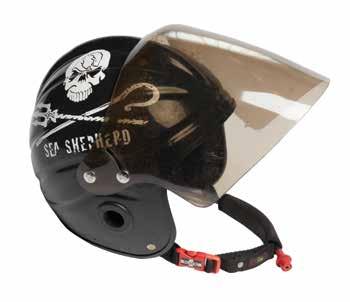
When a new object arrives at the museum, a flurry of work goes on behind the scenes to record its details and to preserve it, preventing any further deterioration. This work is the duty of the museum’s conservation team. The Delta RIB entered the museum’s collection after a hard life at sea. Although it was rebuilt from the waterline up in 2014, the shell had had years of service in harsh salt water. Before display, conservators took a closer look at the vessel, revealing evidence of the wear and tear it endured. They documented and photographed its condition, noting several deterioration issues. The adhesive joints between the boat’s inflatable buoyancy tubes were beginning to fail, but remarkably the tubes remained airtight. Unsurprisingly, there was minor to moderate corrosion of some metal components. Several hazards were found, which if left unchecked could have affected the safety of the object and the health of people around it, such as a lead-acid battery inside the centre console. This was documented, photographed and removed for recycling. If left in place, the battery would deteriorate, causing damage to the boat and exposing museum staff to dangerous chemicals. Motor oil, another hazardous substance, was left behind by the removed outboard engines and found around the transom. The oil was removed with absorbent towels and its residue cleaned off with a suitable detergent.
No longer hazardous, the RIB still needed some additional work before it was suitable for public display. Dirt and debris were removed and every nook and cranny thoroughly cleaned. During this exhaustive task, a whole peanut was found in a dark recess of the vessel – evidence of the MY Steve Irwin crew’s vegan diet?
A custom-made cradle was engineered to support the boat in its new home on dry land. The cradle is designed to bear the weight of the RIB in storage and on display. Now that the RIB is part of the museum’s collection it will receive regular checks to ensure its long-term stability (especially the adhesive joints and corroded metal components). The Delta RIB is now documented, safe and ready to meet the public. Nick Flood is a member of the museum’s conservation team.

Now that the RIB is part of the museum’s collection it will receive regular checks to ensure its long-term stability
01
Gecko MK11 marine safety helmet, used during Sea Shepherd’s anti-whaling operations in the Southern Ocean from 2007 to 2013. ANMM Collection 00055521
02
The cleaned and conserved Delta RIB ready for display. ANMM Collection 00055371
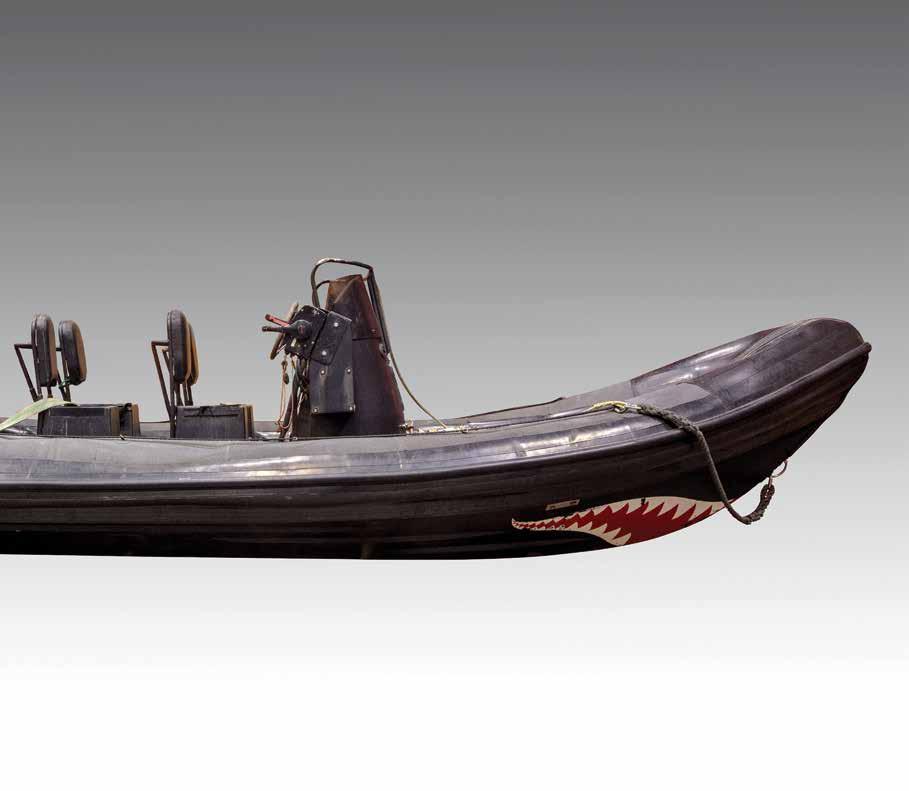

Australian fisheries are internationally recognised as among the most sustainable in the world. Our fisheries management is rigorous and scientifically based, and now seafood industry leaders are improving the visibility of this science for consumers, writes Kelly Seagrave .
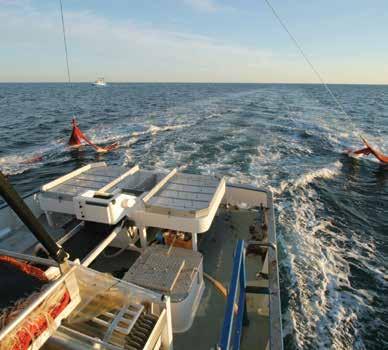
The museum’s Yots Café is catered by Laissez-faire Catering, which uses seafood defined as sustainable by the Status of Australian Fish Stocks report produced by the Fisheries Research and Development Corporation. This is the most comprehensive report on Australia’s fish stocks. Laissez-faire Catering focuses on the holistic life cycle of seafood and sources wild fish where possible, taking into consideration where the fish is caught and the amount they, as part of the food industry, source.
They obtain their seafood supplies from Cummins Seafood, an operator that’s been in the business for over 20 years. They understand what they are getting, where it’s from and how it was raised or harvested. When available and sustainable, they source oysters from the south and north coasts of New South Wales. They buy whole fish and use every part possible to reduce waste. Caring in this way about how seafood is produced ultimately results in a better taste for the consumer.
SYDNEY FISH MARKET, in collaboration with research partners led by the University of Technology Sydney, is utilising blockchain technology to develop a Fish Provenance and Quality Tracking System. The system will enable transparency along the supply chain and real-time tracking and provide information on provenance and quality. This will encourage consumer confidence and add value to Australia’s seafood industry.
The project applies the Internet of Things, artificial intelligence, image processing and electronic-nose technologies (see definitions at end of article) to develop a system that captures and verifies real-time information tracking the origins and quality of fish catches. Blockchain and smart contracts are used to ensure that the tracking data are trustworthy.
The scope of the project includes the development of a Fisherman App and on-board camera system that will capture the time and location of the catch and upload this information to the blockchain. With time, pattern recognition technologies will be able to identify the species and size of the fish once caught. In a world first, information collected from image processing and electronic-nose technology will be combined with temperature history of the fish along the supply chain to provide a comprehensive quality assessment. The freshness of fish is currently assessed through observing key indicators such as eyes, scales and fins, in which colour usually has a high relevance to quality. Using these indicators as focal points to develop image-processing technologies and combining them with advances in electronic-nose technologies will enable objective quality assessments of seafood.
New and existing digital technologies will transform the way the seafood industry does business
The electronic-nose (‘e-nose’) technology is a component of the project that aims to provide a consistent, objective tool to assess fish freshness by analysing naturally occurring trace gases that indicate how fresh the fish is.
The final outcome of the project will be the development of a consumer app that will allow traders and consumers to confidently verify information, including the catch time and location, temperature control and freshness of their seafood purchase.
Sydney Fish Market and its collaborators have commenced early trials of the various technologies, with positive results. It is hoped that the technology will be available to consumers in the near future.
To support the Fish Provenance and Quality Tracking System, Sydney Fish Market has also partnered with the Food Agility Cooperative Research Centre (CRC), which brings together 54 participants from food, technology and research sectors to lead the digital revolution in food production and supply.
Sydney Fish Market is working closely with the Food Agility CRC on projects that will harness new and existing digital technologies to transform the way the industry does business. These include finding methods to improve product quality and sustainability, drive efficiency in logistics and wholesale methods and create new experiences for consumers and tourists.
The Food Agility CRC already has projects under way in the aquaculture, wheat and viticulture industries, working with partners to help Australian agri-food industries be more globally competitive and sustainable.
Blockchain is a distributed ledger technology (DLT) that allows data to be stored globally on thousands of servers, while letting anyone on the network see everyone else’s entries in near-real time.
The Internet of Things is the interconnection, via the Internet, of computing devices embedded in everyday objects, enabling them to send and receive data.
Electronic-nose (e-nose) technologies assess fish freshness by analysing naturally occurring trace gases from harvested fish.
Smart contracts are contracts that are converted to computer code, stored and replicated on the system and supervised by the network of computers that run the blockchain. They help to exchange money, property, shares, or anything of value in a transparent, conflict-free way while avoiding the services of an intermediary, such as a lawyer.
Read more at foodagility.com/posts/from-digital-fish-to-high-tech-viticulturefood-agility-celebrates-official-launch-announces-new-research-director
Kelly Seagrave is the Marketing Executive at Sydney Fish Market.
Ocean Talk
Signals from the Ocean
6.30–8.30 pm Thursday 5 March
With photographer Michael Aw and coral biologist Dr Emma Camp
Harbour cruise
Naval Heritage Discovery Cruise
10 am–1 pm Sunday 8 March
A chance to explore Chowder Bay, Garden Island and Cockatoo Island
Ocean Talk
Cook – Man or Myth?
6.30–8.30 pm Thursday 2 April
Professor John Maynard and author Peter FitzSimons discuss this topical figure
One-day workshop
Claymation Creations
10 am–4 pm Wednesday 15 or 22 April
Kids aged 8 to 14 can learn to produce their own stop-motion creations
Family activity
Shipshape sleepover
Bookings and enquiries
Booking form on reverse of mailing address sheet. Please note that booking is essential unless otherwise stated. Book online at sea.museum/whats-on or phone 02 9298 3646 (unless otherwise indicated) or email members@sea.museum before sending form with payment. Minimum numbers may be required for an event to go ahead. All details are correct at time of publication but subject to change. Members are advised to check our website for updated and new event information.
4 pm Saturday 18 to 8 am Sunday 19 April
Experience the museum and tall ship James Craig as never before!
Two-day workshop
Rock the boat – music video workshop
10 am–4 pm Monday 20 and Tuesday 21 April
Kids aged 8 to 14 can learn to produce their own music videos
Classic & Wooden Boat Festival Talk
Rust to Ritz
12.30–2 pm Saturday 2 May
A panel talk about the joys and trials of boat restoration
Classic & Wooden Boat Festival Talk
World Sailing Women
2.30 pm–4 pm Saturday 2 May
Kay Cottee, Wendy Tuck and Daina Fletcher talk about famed female sailors
Classic & Wooden Boat Festival Talk
Australia’s Sailing Legends
11 am–12.30 pm Sunday 3 May
Come and hear speakers Mike Fletcher and Adrienne Cahalan
Classic & Wooden Boat Festival Talk
The Sydney to Hobart Yacht Race: History, Hazards & Heroes
1–2.30 pm Sunday 3 May
Veteran sailors discuss the challenges and history relating to the Sydney to Hobart Yacht Race
Harbour cruise
Goat Island Cultural Cruise
10 am–1 pm Sunday 16 May
Explore Sydney Harbour through Indigenous eyes on board Tribal Warrior’s vessel Mari Nawi (Big Canoe)
Dates for your diary
Saturday 27 June
Harbour cruise: Tall Ship Whale & Sail
Thursday 2 July
Ocean Talk: Defying Empire
Thursday 6 August
Ocean Talk: Perspectives of Paradise Lost
Saturday 22 August
Harbour cruise: Navigation by the Stars
Ocean Talk
Recovering Refugee Narratives
6.30–8.30 pm Thursday 4 June
Panel discussion on using various media and artforms to preserve refugee stories
Ocean Talk
Cook – Man or Myth?
6.30–8.30 pm Thursday 2 April
Considered one of the greatest navigators, cartographers and explorers of all time, James Cook looms large in the annals of history as the first European to chart the east coast of Australia, aboard HMB Endeavour Both celebrated and criticised, Cook remains a topical figure in Australia. His arrival has become the symbol of European invasion and occupation of the continent, particularly for First Nations people.
But who was the real James Cook?
Join Professor John Maynard and Peter FitzSimons as they reveal the man behind the myth, examining Cook’s impact both in the past and today.
Member/concession $30, general $40. Includes light refreshments and entry to the exhibition Cook and the Pacific
Ocean Talk
Recovering Refugee Narratives
6.30–8.30 pm Thursday 4 June
How are refugee memories expressed through the arts and remembered within diasporas? Four fascinating speakers –Joseph Toltz, Annette Janic, My Le Thi and Ali Mousawi – present insights into their individual stories and how they have recovered refugee narratives through music, theatre, writing, visual arts, filmmaking and photography.
Member/concession $30, general $40. Includes light refreshments and entry to the exhibition The Face of Australia
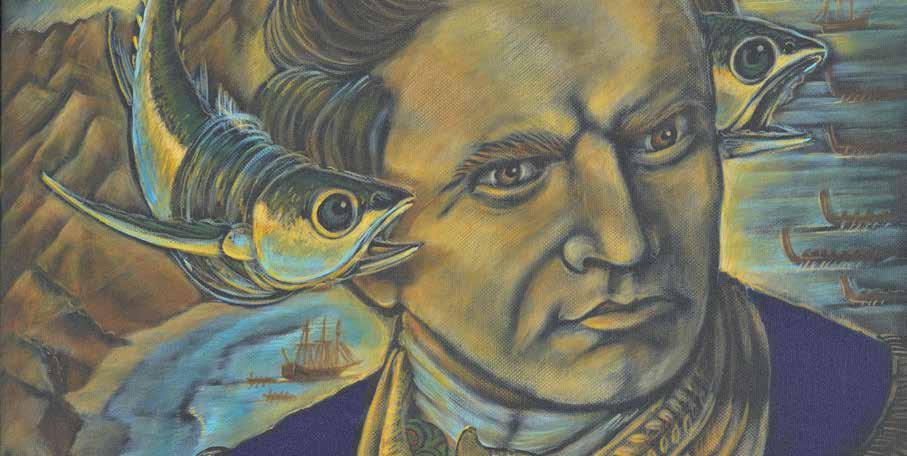
Classic & Wooden Boat Festival Talk Rust to Ritz
12.30–2 pm Saturday 2 May
A panel talk that discusses the love, sweat, tears and joys involved in boat restoration. With presenters David Payne, Curator of Historic Vessels at the Australian National Maritime Museum; Simon Sadubin of Sydney Wooden Boats; and boatbuilder, educator and author Ian Smith.
Classic & Wooden Boat Festival Talk Australia’s Sailing Legends
11 am–12.30 pm Sunday 3 May
The Australian Sailing Hall of Fame, managed by the Australian National Maritime Museum and Australian Sailing, is now in its fourth year and includes 16 honourees, both individuals or teams. Host Daina Fletcher, the museum’s Senior Curator, will introduce you to some of Australia’s blue ribbon sailors: coach Mike Fletcher AM , navigator Adrienne Cahalan OAM , and John ‘Steamer’ Stanley, who will speak about Mark Foy (1865–1950), who changed the face of sailing in Australia.
Harbour cruise Naval heritage discovery cruise
10 am–1 pm Sunday 8 March
The museum’s Curator of RAN Maritime Archaeology, Dr James Hunter, will guide you on a historical journey around our harbour. Visit the torpedo station and heritage buildings at Chowder Bay, then Garden Island’s heritage centre and museum, rocks inscribed with historical European graffiti, 1880s buildings, HMAS Parramatta and HMAS Kuttabul. Your final stop will be the former naval shipyard, dry docks and naval buildings on Cockatoo Island.
Member/concession $65, general $85, family $270 (2 adults, 2 children).
Includes morning tea Cockatoo Island. Image Katacarix/Shutterstock
Classic & Wooden Boat Festival Talk World Sailing Women
2.30 pm–4 pm Saturday 2 May
Presented by Kay Cottee, the first woman to circumnavigate the world single-handed, non-stop and unassisted; Wendy Tuck, who has sailed in 11 Sydney to Hobart races and was the first female skipper to win a round-the-world yacht race; and Daina Fletcher, Senior Curator at the Australian National Maritime Museum.
Kay Cottee uses her foot to steer her yacht Blackmores First Lady across the Pacific Ocean. ANMM Collection
Classic & Wooden Boat Festival Talk
The Sydney to Hobart Yacht Race: History, Hazards & Heroes
1–2.30 pm Sunday 3 May 2020
Join veteran sailors David Salter, Sir James Hardy, Sean Langman, Vanessa Dudley, John Stanley and Dave Kellet for this lively discussion about the challenges and history related to the Sydney to Hobart Yacht Race. There will be a particular focus on the great yachts and individuals who have helped make it one of the world’s great ocean classics.
Admission to the Classic & Wooden Boat Festival talks is free, but tickets must be booked online at sea.museum/cwbf-talks
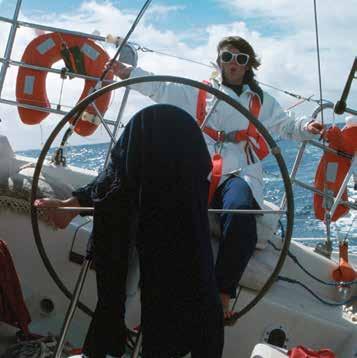
Harbour cruise Goat Island cultural cruise
10 am–1 pm Saturday 16 May
Explore Sydney Harbour through Indigenous eyes on board Tribal Warrior’s vessel Mari Nawi (Big Canoe). On Goat Island (Me-Mel), you’ll learn about traditional fishing methods and food-gathering techniques and enjoy a vibrant Aboriginal cultural performance. During the cruise, Mari Nawi ’s Aboriginal crew will share fascinating stories of Sydney Harbour’s Gadigal, Guringai, Wangal, Gammeraigal and Wallumedegal people.
Member/concession $45, general $55, child (4–15 years) $37, family (2 adults, 2 children) $184. Includes tea and coffee
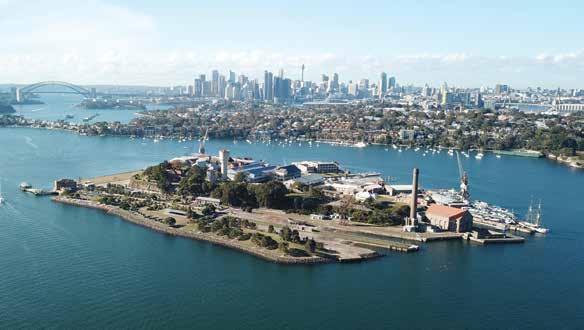
Go wild at the Maritime Museum these school holidays with exhibitions, vessels, hands-on workshops, themed creative activities and more. It’s fun for the whole family!
There’s an adventure to be had every day, including art-making, experiments and dress-ups in Kids on Deck, exploring touchable objects and artefacts at the Cabinet of Curiosities, experimenting with science activities at our Ocean Lab, relaxing with a 3D film screening, exploring exhibitions with a kids’ activity trail and more.
Visit sea.museum/schoolholidays for full program.
Ocean Lab
13–25 April
Drop in to our new discovery space – our ocean container laboratory – to explore what lies beneath the surface of the harbour. Join in plankton discovery and illustration workshops, help create a spectacular collaborative mural inspired by local creatures, see films captured by our underwater drones and learn more about the biodiversity of our Sydney Harbour environment. Ages 4–14 and adults. Included in any paid admission. Members free. For full program see sea.museum/schoolholidays
10.30 am–4 pm (drop in anytime) daily during school holidays
Play, create and discover at Kids on Deck with art-making, interactive games and dress-ups! Be inspired by the brilliant biology of underwater creatures. Craft your own creative creature puppets, print a wild-patterned tote bag, play with science experiments or sculpt a cardboard camera. Included in any paid admission. Members free McDougall Photography for ANMM

Cabinet of Curiosities touch trolley Ocean Commotion
11 am–12 noon and 2–3 pm daily during school holidays
Explore wonderful and curious scientific objects and creature specimens in this hands-on discovery device in our galleries. Free with entry. No bookings required
Family activity
Shipshape sleepover
4 pm Saturday 18 to 8 am Sunday 19 April
Experience the museum and tall ship James Craig as never before when you sleep over! Put your seamanship skills to the test on board the ship, then explore the museum’s galleries and Sea Monsters exhibition after dark with a character-guided tour. Enjoy a movie under the stars on board James Craig then settle into your hammock. Delicious dinner, dessert and breakfast are provided. Ages 4 to adult. Read our FAQs for more information at sea.museum/sleepover
Members $130, general $145. Family prices to be advised; check our website
McDougall Photography for ANMM
One-day workshop
Claymation Creations
10 am–4 pm Wednesday 15 or 22 April
Discover how to produce your own stopmotion and clay animations inspired by our exhibitions now showing. Create your own animation to share and have your work featured on the museum’s YouTube channel. Members $65, general $75. Online bookings essential at sea.museum/youth

Two-day workshop
Rock the boat – music video workshop
10 am–4 pm Monday 20 and Tuesday 21 April
Create and star in your own imaginative music video inspired by our vessels and exhibitions. Learn clever techniques in music production, directing and choreography. Have your finished work featured in a special event screening for family and friends. For ages 8–14.
Members/earlybird special $140, general $165. Online bookings essential at sea.museum/youth
programs
term time Mini Mariners
10–10.45 and 11–11.45 am every Tuesday during term time and one Saturday each month
Explore the galleries and sing and dance in interactive tours with costumed guides. Enjoy creative free play, craft, games, dress-ups and story time in our themed activity area. For ages 2–5 and carers.
March – Pirates Ahoy
April – Alphabet Animals
May – Tick Tock Twinkle
June – Pirates Ahoy
Child $10, adult $8, Members free (includes Activities Ticket). Booked playgroups welcome. Online bookings essential at sea.museum/whats-on
Access program
Sensory-friendly Sundays
8.30 am–11.30 am
Sunday 19 April, 24 May, 21 June
Enjoy a comfortable environment for kids and adults with a variety of sensory differences. On Sensory-friendly Sundays in autumn, our destroyer HMAS Vampire, new exhibitions and activity areas will be open early for a quieter experience and modified to suit people on the autism spectrum and with a range of differing abilities. Our trained staff and volunteers will be on hand to facilitate creative activities.
Members and children under 4 free, child 4+ or adult $12. The April session also includes entry to the Sea Monsters exhibition. Minimum height 90 cm for entry to Action Stations and vessels. Bookings encouraged at sea.museum/whats-on/events
Family events
Kids on Deck Sundays
11 am–3 pm every Sunday during school term
Play, create and discover at Kids on Deck with art making, interactive games and dress-ups!
Sundays in Term 1 – Mesozoic Monsters Sundays in Term 2 – Go Wild
Entry included in any paid admission. Members free.
Classic and Wooden Boat Festival
Kids’ boatshed and family fun
10 am–4 pm 2 and 3 May
There’s boatloads of fun to be had at the Kids’ Boatshed this festival weekend. And it’s all free!
Craft a model sailing vessel and race it, decorate a sailor hat or print your own calico bag and enjoy dress-ups and interactive aqua-play games inspired by all the beautiful boats on our shores.
There’s also a jam-packed program of live entertainment, cruises, maritime demonstrations, and more.
Find out more at sea.museum/cwbf
events
Activity trails
Available every day
Explore our exhibitions with creative kids’ activity trails.
Free with entry
Stay up to date with the full program of family events and activities by subscribing to our monthly newsletter at sea.museum/kids
For carers with children 0–18 months
Seaside Strollers tours and play
Join an educator-led tour and enjoy adultfriendly conversations in new exhibitions, catered treats from Yots Café, and baby play time in a specially designed sensory space. Strollers, front packs, baby-slings and breastfeeding welcome.
12.30–2 pm Monday 16 March
Tour: Wildlife Photographer of the Year
Play: Sensory Jungle theme
10.30 am–12 noon or 12.30–2 pm
Monday 6 April
Tour: Sea Monsters
Play: Under the Sea theme
12.30–2 pm Tuesday 12 May
Tour: HERE: Kupe to Cook
Play: Starlight theme
10.30 am–12 noon or 12.30–2 pm
Monday 15 June
Tour: Defying Empire
Play: Colour and shape theme
Adult $20, Member adult $15, babies free. Includes light refreshments and exhibition entry. Bookings essential at sea.museum/ strollers
Can’t make a session? You can now book a Stroller Tour on demand for your group for $230 per group (maximum 15 adults per group). Includes morning or afternoon tea and exhibition entry. Enquire about your preferred date online at sea.museum/ strollers

You receive:
FREE entry to
• Questacon, The National Science Museum and Technology Centre Canberra
• Immigration Museum and Melbourne Museum
• Queensland Maritime Museum
25% discount on entry to the South Australian Maritime Museum
Free entry to Auckland Art Gallery; 15% discount on museum entry and harbour sailing at New Zealand Maritime Museum
And at the Australian National Maritime Museum: Free Signals magazine
Exclusive access to the Members Lounge
10% discount in the Retail store and Yots café
Discounts for Ocean Talks, events and cruises
A gift membership lets you access the museum 364 days of the year!
sea.museum/whats-on/events
More than 1,000 years ago, the celebrated Oceanic navigator Kupe sailed to Aotearoa New Zealand and acquired an anchor stone from Porirua Harbour in Wellington. This stone, a treasure of the Ngai Toa people now in the care of Pātaka Art + Museum, provides a conceptual anchor point for conversations around Oceanic exploration and ideas of discovery in HERE: Kupe to Cook.
IN ENGLISH, THE WORD ‘HERE’ is a marker of location, denoting a time or place. In te reo Māori, ‘here’ refers to the act of binding, or being bound to a place, object or obligation. Ideas of location and connectedness sit at the heart of this exhibition, exploring the ways people have anchored themselves to Pacific lands.
Artworks by 20 leading Aotearoa–New Zealand contemporary artists investigate the long and varied histories of South Pacific voyaging. Māori sculptors Wi Taepa and Tawhai Rickard have created sculptural interpretations of Kupe’s anchor stone and an imagined version of Cook’s Resolution. Paintings inspired by Tongan Ngatu barkcloth by Glen Wolfgramm and Robyn White celebrate connections between Oceanic communities, while photographs by Samoan artists Yuki Kihara and Greg Semu question the strength of those connections.
Produced by Pātaka Art + Museum in association with the National Library of New Zealand This exhibition is part of the Encounters 2020 Program.
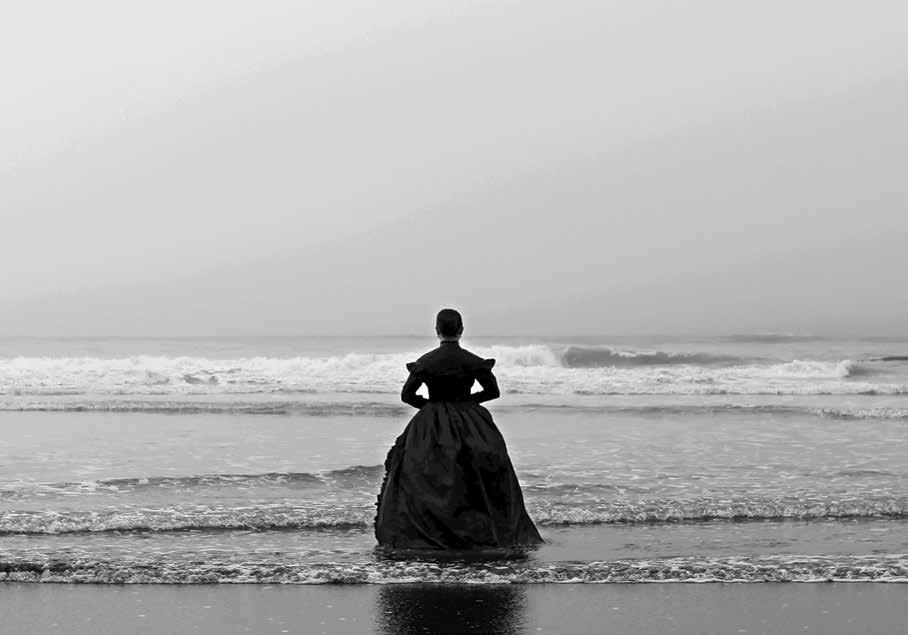 Takitimu Landing Site, Waimarama, Yuki Kihara, 2017. Courtesy of the artist and Milford Galleries, Dunedin, NZ
Takitimu Landing Site, Waimarama, Yuki Kihara, 2017. Courtesy of the artist and Milford Galleries, Dunedin, NZ
From
This world-renowned exhibition features 100 awe-inspiring images, from fascinating animal behaviour to breathtaking landscapes. Wildlife Photographer of the Year is the most prestigious photographic event of its kind, providing a global platform that has showcased the natural world’s most astonishing and challenging sights for more than 50 years. Wildlife Photographer of the Year is developed and produced by the Natural History Museum, London.
Until 27 April
An exhibition combining real fossils, gigantic replicas, multimedia and hands-on experiences to reveal ancient monsters of the deep. Find out how three main types of ancient reptiles – ichthyosaurs, plesiosaurs and mosasaurs – left the land to rule the seas. In the oceans, they developed into awesome, enormous predators that make today’s great white sharks seem almost friendly!
Cast of a five-metre Shonisaurus ichthyosaur skull. ANMM image
Now showing
Darling Harbour is called Gomora in the Sydney Aboriginal language and is part of the traditional lands (bamal, or earth) and waters (badu) of the Gadigal people.
Bamal-Badu is a digital art installation that acknowledges the long history of the place where the museum is located and honours and respects the Aboriginal people who lived and continue to live around Sydney Harbour.
Bamal Badu is a collaboration with Aboriginal digital artist Brett Leavy of Virtual Songlines.
Scene from Bamal-Badu. Image Brett Leavy/ ANMM
Until 1 April
Elysium Arctic follows a team of worldrenowned explorers, photographers and scientists into the icy regions of the High Arctic. Led by acclaimed wildlife photographer Michael Aw, the Elysium team produced a series of artworks showcasing the extreme beauty of the polar north at a time when climate change is threatening its very existence. Elysium Arctic is located outside Wharf 7.
Opens late April
Planets and stars unite the long history of all navigators around Australia – from the observation of the transit of Venus, to the importance of the night sky in Torres Strait Islander navigation and voyaging.
As part of the ongoing rejuvenation of the museum, our newest permanent exhibition, Under Southern Skies , opens in April.
Included are new acquisitions and collection objects from Indigenous Australian and Pacific navigation, as well as a selection of important new material associated with James Cook and other European navigators.
This exhibition is part of the Encounters 2020 program.
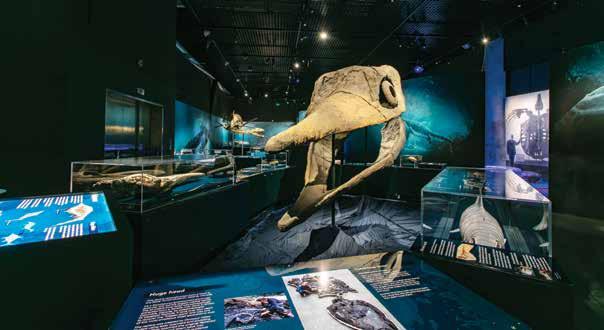
22 May–18 October
Through the works of 30 contemporary Aboriginal and Torres Strait Islander artists, this exhibition explores the ongoing resilience of Australia’s First Peoples since first contact, and reflects on the 50th anniversary of the 1967 referendum that recognised them as Australians. From the National Gallery of Australia
This project has been assisted by the Australian Government’s Visions of Australia program and by the National Collecting Institutions Touring and Outreach Program. This exhibition is part of the Encounters 2020 program.

Special 3D film screenings
11 am, 2 and 3 pm daily
Currently screening:
Sea Monsters 3D – A Prehistoric Adventure uses ultra-realistic computer animation to transport you back to the Late Cretaceous period, when the oceans were dominated by giant marine reptiles. Showing until April. More films are planned – please check our website for details.
Alan Villiers & the Sons of Sindbad
Kuwait National Assembly
Until 31 March
This travelling photographic exhibition is the Australian National Maritime Museum’s first foray into the Middle East. It showcases 50 photographs from the late 1930s, when Australian journalist, novelist, sailor and adventurer Alan Villiers travelled to Arabia to photograph, film and write about what he believed were the last days of merchant sailing ships. Villiers captured age-old Arabian sailing traditions, the great skills of the sailors and the hardships they endured, and views of Kuwait City before the discovery of oil changed the face of Kuwait forever.
The box that changed the world
Western Australian Maritime Museum, Fremantle, WA
Until 14 April
Museum and Art Gallery of the Northern Territory, Darwin, NT 2 May–27 July
Dedicated entirely to the history and impact of the humble shipping container, this exhibition goes beyond the corrugated steel to reveal the fascinating story of this revolutionary maritime invention. Housed entirely within specially modified 20-foot containers, it explores the economic, geographic, technical, environmental, social and cultural history and impact of containerisation.
Australian Sailing Hall of Fame 2019
Wharf 7 foyer
Now showing
Featuring the stories of the latest Sailing Hall of Fame honourees, who have produced some of Australia’s greatest sporting moments in the America’s Cup, the Olympics, blue-water racing and world sailing. Iconic and archetypal, these are stories of excitement, national excellence and even Australian obsession – a dazzling moment of team victory in the America’s Cup, the romanticism and adventure of lone sailors on the world’s oceans and the daring of the crews of heavily canvassed skiffs.
The Home Front banner exhibition
Various dates and venues in the USA
In 2018, high school students from Australia, the USA and Japan researched various topics relating to life on the home front during World War II, including censorship, rationing, air raids, the changing role of women, loss and hardship, and internment camps. Alongside these were aspects of everyday life such as fashion, music, education and politics. Students constructed an engaging and informative exhibition by interviewing witnesses and survivors and delving into fascinating primary sources. Together the banners give an enlightening perspective on the home front across three nations at war. The banners have already travelled in Australia and Japan and in 2020 they will go to museums in the USA.
The War and Peace in the Pacific 75 Learning Program is supported by the USA Bicentennial Gift Fund.
Submerged banner display
Various dates and venues in Australia
The Australian Maritime Museums Council (AMMC) and the Australian National Maritime Museum partnered to develop the graphic panel display Submerged: Stories of Australia’s shipwrecks. Content was developed by AMMC members at maritime heritage organisations across the country, and merged into a nationally touring display by the museum.
This display is supported by Visions of Australia.
Homefront panel display
Various dates and venues in Australia
Banner display developed and written by students from schools in Australia, the USA and Japan. The exhibition will tour schools who have registered with our War and Peace in the Pacific 75 program, which is supported by the USA Bicentennial Gift Fund.
Banner and panel displays
There is no cost to host the majority of travelling graphic panel displays. For bookings and enquiries, please contact touringexhibitions@sea.museum
Various dates and venues in Australia
Since the First Fleet, 10 million people have settled in this country and made Australia home. With them have come 270 languages to join the estimated 250 Australian Indigenous languages and more than 600 dialects. Discover the different words to represent unique Indigenous watercraft specific to particular areas all around the country.
of the carriers: Battle of the Coral Sea panel display
Various dates and venues in Australia and the USA
Fought between combined United States and Australian naval and air forces and the Imperial Japanese Navy, this was the world’s first sea battle between aircraft carriers. Literally ‘fought in the air’, it was also the first naval battle in which opposing ships neither saw nor fired on each other. This exhibition is part of the War and Peace in the Pacific 75 program.
Created by the Australian National Maritime Museum’s USA Programs supported by the USA Bicentennial Gift Fund
Various dates and venues in Australia
2020 marks 250 years since James Cook charted the east coast of Australia aboard HMB Endeavour. This scientific voyage of 1770 set the scene for subsequent waves of migration that have shaped modern Australia. For the First Peoples of Australia, custodians of the continent for more than 60,000 years, Cook’s voyage was the most consequential encounter with early Western explorers, as it heralded a fundamental change to their way of life.
The anniversary offers a unique opportunity for all Australians to reflect on, discuss and re-evaluate the lasting impact this pivotal event has had on us all – in particular, the repercussions on Aboriginal and Torres Strait Islander communities. For them, it led to the invasion and loss of their country, but it has also shown the resilience of their culture and prompted a movement for their rights and recognition as the traditional owners of Australia’s lands and waters.
Encounters 2020 will examine the significance and enduring legacy of this historic event from the dual perspectives of both the ship and the shore.
Through a curated series of exhibitions, localised events, educational outreach initiatives and voyages around the country by the replica HMB Endeavour, Encounters 2020 will encourage community engagement and discussion about our past and our future. For more details, please see pages 58–59.
Various dates and venues in Australia and the USA
On the night of 28 February–1 March 1942, HMAS Perth and USS Houston fought bravely and defiantly against overwhelming odds – outnumbered and outgunned by a large advancing Japanese naval force – as they approached Sunda Strait. Both ships sank that dreadful night in the Battle of Sunda Strait. This exhibition is part of the War and Peace in the Pacific 75 program.
Created by the Australian National Maritime Museum’s USA Programs supported by the USA Bicentennial Gift Fund
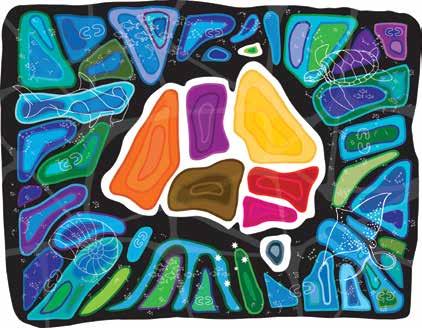
Encounters 2020 is a nationwide program that looks at dual perspectives of the 1770 encounter between Europeans and Australia’s First Peoples.
A key component is a voyage around the continent by the Endeavour replica and an accompanying art exhibition called Looking Back Looking Forward
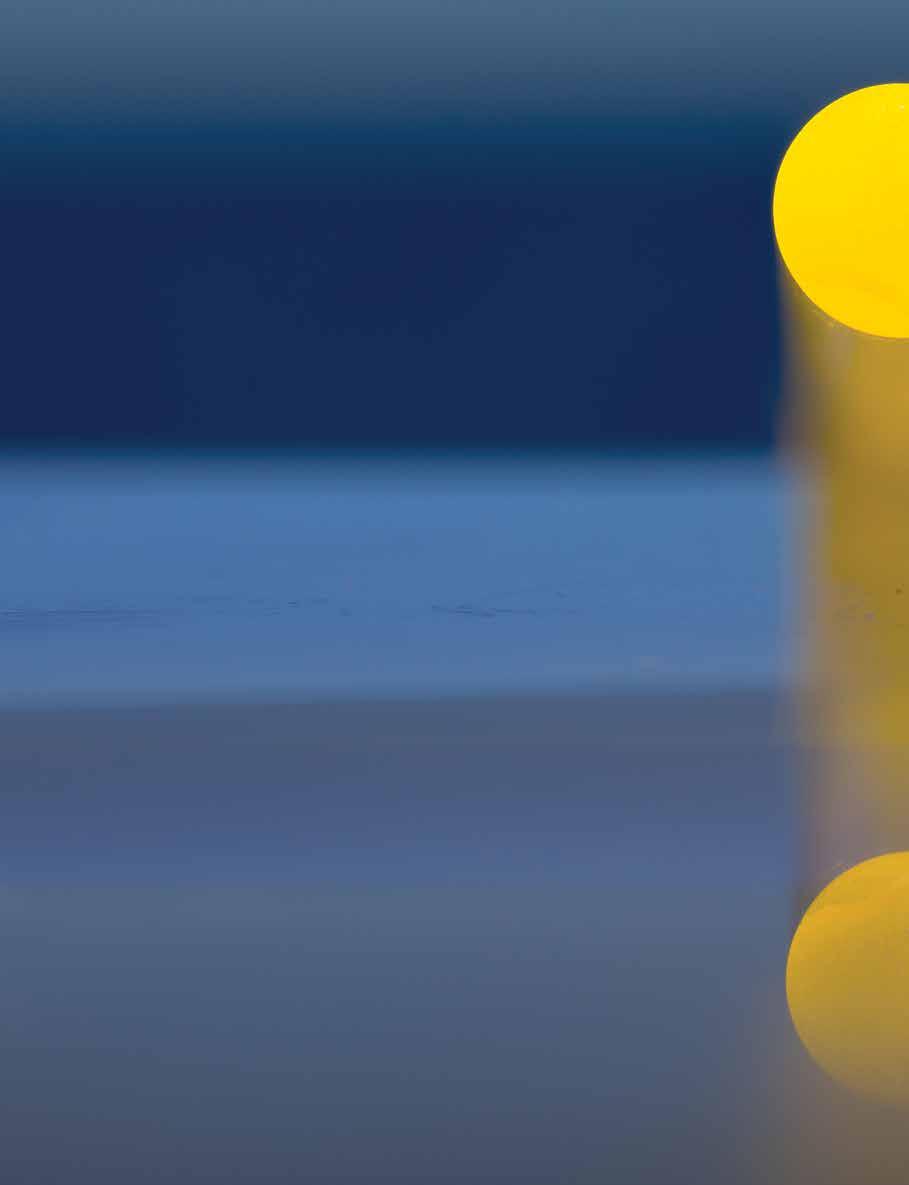
Voyaging
HMB Endeavour replica voyaging: April 2020–May 2021
The ship will travel to 38 locations around Australia. Opportunities exist to join the working crew on an Endeavour voyage leg. sea.museum/sailendeavour
Exhibitions
Looking Back Looking Forward: April 2020–May 2021
Showcases contemporary works from the museum’s collection by Aboriginal, Torres Strait Islander and nonIndigenous artists that focus on moments of encounters.
sea.museum/looking-back-looking-forward
Defying Empire: May–October 2020
Explores the ongoing resilience of Australia’s Indigenous people since first contact. From the National Gallery of Australia.
sea.museum/defying-empire
Under Southern Skies: from late 2020
An exhibition about navigators and voyagers in Australia and the Pacific.
sea.museum/under-southern-skies
HERE: Kupe to Cook: March–August 2020
Artworks by 20 leading Aotearoa–New Zealand and Australian contemporary artists who investigate the long and varied histories of South Pacific voyaging. sea.museum/kupe-to-cook
Paradise Lost – Daniel Solander’s Legacy August–November 2020
A touring exhibition that commemorates the legacy of Endeavour botanist Daniel Solander and the first encounter between Sweden and the Pacific Region. sea.museum/paradise-lost
Seascapes: December 2020–February 2021
French artist Paul Rousteau’s abstracted landscapes of optical illusions, chromatic aberrations and meteorological mirages were created aboard the HMB Endeavour replica on a voyage from Sydney to Noumea in 2019. sea.museum/seascapes
Cook and the Pacific : April–August 2020
A travelling multimedia display of maps, manuscripts, rare books, oil paintings and watercolours by voyage artists. From the National Library of Australia. sea.museum/cook-and-the-pacific
Film
Looky Looky Here Comes Cooky : on NITV, 5–12 July 2020
A cheeky and acerbic new songline for 21st-century Australia that tells of connection to country, resistance and survival.
sea.museum/here-comes-cooky
Endeavour Stories: from March
Four six-minute video documentaries exploring stories relating to HMB Endeavour and Cook’s first voyage.
sea.museum/endeavour-stories

Digital
Cook’s Voyages – Views from the shore: from February 2020
An online game aimed at upper-primary school students that allows players to take on the role of an 18th-century explorer in the Pacific Ocean.
sea.museum/cooks-voyages
Researching Australian submarine canyons aboard RV Falkor
The world’s seas are one of the last frontiers of science and exploration, and a source of vital information about climate and ocean ecosystems. Curator Emily Jateff profiles the Schmidt Ocean Institute and its Research Vessel Falkor, which recently visited Sydney ahead of a year-long circumnavigation of Australia.

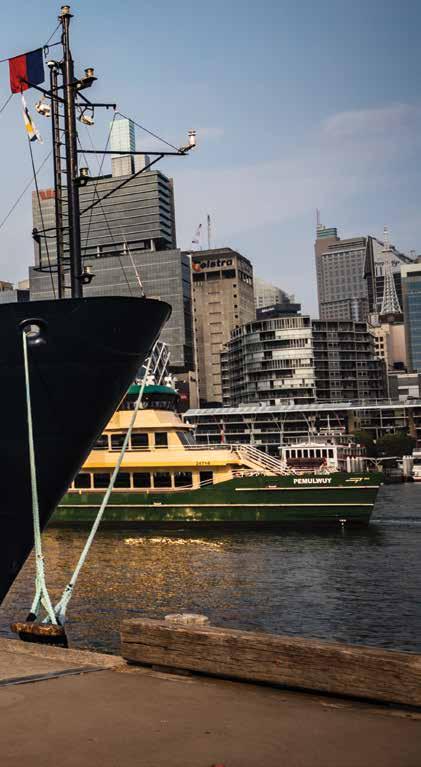
RV Falkor is a mammoth manifestation of how crucial scientific endeavour is in understanding oceans and inspiring action
MUSEUM STAFF ENJOYED A NEW VIEW from their windows in January, seeing not the usual glare from the skyscrapers opposite, or worse, the #sydneysmoke that had blanketed the city for months, but the midnight-blue starboard side of Schmidt Ocean Institute research vessel Falkor. Rising more than 24 metres into the air, the ship was a visual sea change, a mammoth manifestation of how crucial scientific endeavour is in understanding oceans and inspiring action.
The Schmidt Ocean Institute (SOI), an American not-for-profit organisation started by Eric and Wendy Schmidt to advance marine research, uses its 82-metre research ship Falkor to conduct sea-going expeditions. As with the CSIRO’s RV Investigator, berths and access to equipment on the ship are free for approved scientific research projects. The SOI difference is that Falkor is the only philanthropically funded year-round seagoing research vessel in the world.
RV Falkor arrived in Sydney in the early hours of 6 January 2020. After a bit of settling in, it opened its gangway to media and museum members and then hosted two full days of sold-out public tours. Altogether, more than 900 people toured Falkor On the evening of the 7th, the museum co-hosted an event to launch the 2020 Australian expedition and hear first-hand from the scientists leading research on board.
On the 10th, Falkor departed for the first leg of its year-long circumnavigation of Australia, during which it will conduct seven science expeditions using its state-of-the-art deep-water remotely operated vehicle (ROV) SuBastian, which is rated to 4,500 metres. Australian marine researchers currently have limited access to deep-water robotic technologies; much of this technology in Australia is available only for commercial oil and gas work – not for scientific research or to understand the implications of the ocean to life on land.
SuBastian is an underwater robot, sometimes known as a remote-controlled submarine, controlled by pilots on a ship. The ROV is connected to the ship by a cable, called an umbilical, that contains lines running communications and power to the vehicle. ROVs can vary in size, ranging from a shoe box to a large van depending on the type of mission each needs to accomplish.
All of the dives will be live-streamed from underwater to the internet in high-resolution video and can be watched in real time
01
ROV SuBastian collects a sample in the Perth Canyon to better understand the deep corals and species interactions in the canyon. This expedition was completed in 2015 and an updated mission will embark at the end of January as part of a broader 2020 Australia campaign. Image Schmdit Ocean Institute
02
ROV SuBastian ready for deployment from the A frame on the stern of RV Falkor. Image Shelton DiPress/ Schmidt Ocean Institute

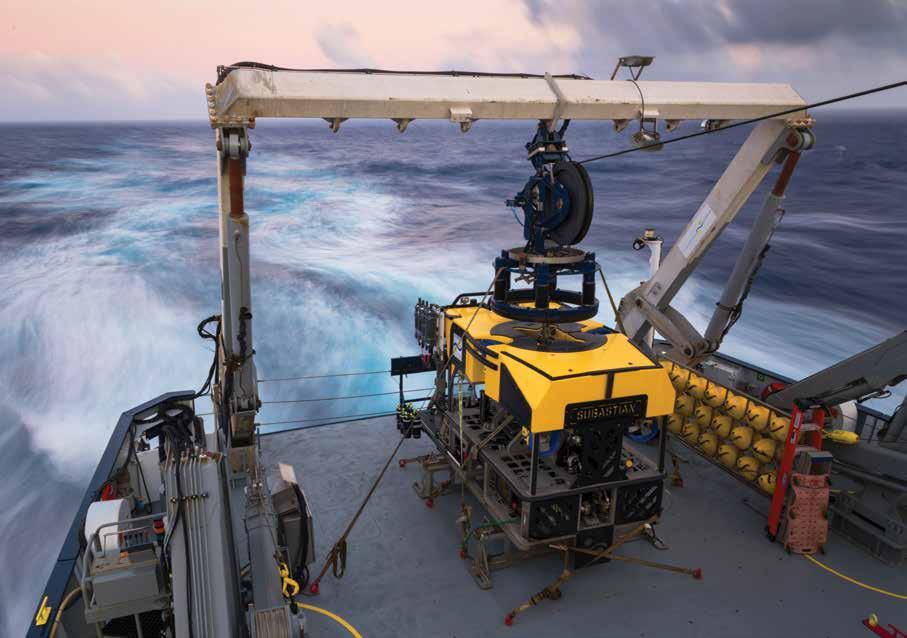
ROV SuBastian is 2.7 x 1.8 x 1.8 metres – about the same size as a subcompact car. In air it weighs 3,200 kilograms, and although this seems like a lot, most of the weight is flotation and will become positively buoyant or neutral weight in the water. The ROV is equipped with five powerful thrusters (just like propellers) that move the vehicle; one thruster moves it sideways, two move it forward and back, and another two are used for vertical movement. The person operating an ROV is called a pilot. This is because they can technically ‘fly’ the vehicle in all three dimensions. SuBastian requires at least three to four people to manage it offshore, including two ROV pilots to fly it.
With ROV SuBastian, Australian scientists will collect information about corals that may hold the answers to the global impact of a warming ocean. SOI undertakes this research in partnership with the Australian Institute of Marine Science, the Western Australian Museum, the University of Western Australia, the Institute of Polar Sciences, Geoscience Australia, the University of Sydney, Australian Centre for Field Robotics and the Woods Hole Oceanographic Institution.
Over the course of 2020, their research will range from studying the causes of coral bleaching to how microplastics affect the ocean’s ecosystem, the biodiversity of Cape Range, seamounts of the Great Barrier Reef and the depths of Bremer and Perth canyons. Deep-water coral reefs are underwater communities teeming with life. Home to millions of species, these rich habitats are threatened by disease, pollution from sewage and agricultural run-off, over-fishing and global warming. Some deep-water corals are older than redwood forests, and because changes in the corals’ skeletons act as archives that record changes in ocean temperature and chemistry over long periods of time, they serve as living museums.
The research that will be conducted and samples collected by SuBastian will uncover centuries-long records of conditions, especially the rapid environmental changes over the past few decades – namely ocean warming and ocean acidification. Teams of scientists also expect to find a range of species, among them corals, sponges, sea stars and large fish, including sharks, with the possibility of discovering new species, especially during deeper dives.
The Schmidts have a great love for Australia. This isn’t Falkor ’s first visit to our shores, and doubtless it won’t be the last.
‘RV Falkor ’s first visit to Australia was in 2015 when we completed incredible work in the Perth Canyon showcasing underwater worlds that had never been seen before,’ says Eric King, Director of Operations for Schmidt Ocean Institute.
SOI co-founder Wendy Schmidt adds:
Most people don’t think about the bottom of the ocean. When you look at a map, the ocean is portrayed as flat blue with very few features. However, this couldn’t be further from what the ocean floor looks like. Picture huge mountains and canyons, exotic hydrothermal vent forests and unique conditions that mimic other planets. There are still so many things we do not know about the topography or the ecosystems that cover the largest part of our earth.
With less than 15 per cent of the ocean floor mapped, the unexplored depths of the ocean – home to potentially countless unidentified species of animals and organisms – may hold answers to environmental issues like global warming and even the cures for disease.
As you may have guessed, the Schmidts also love the movie The Neverending Story Falkor is named for its mythical flying creature, and SuBastian for his rider, the movie’s hero. Falkor also has a work boat named Atreyu and a safe boat named Auryn
All of the dives will be live-streamed from underwater to the internet in high-resolution video and can be watched in real time. Viewers can watch as the scientists make discoveries and ask them questions. These dives started at the beginning of February and can be viewed on the Schmidt Ocean Institute Facebook page, YouTube channel and website. Plans are afoot to live-stream selected dives to the museum, so check our social media pages for an opportunity to see the deep ocean through the eyes of an underwater robot.
While in Sydney, RV Falkor was berthed near the museum’s replica HMB Endeavour. Visitors had the unique opportunity to explore and understand the similarities and differences between ocean-going science in the 21st and 18th centuries. Together, these ships offer a wonderful perspective of how maritime science has shaped our modern world. Two hundred and fifty years ago, the original HMB Endeavour set out on a scientific voyage around parts of Australia and New Zealand. To carry on this tradition, the museum will also provide free berths to scientific researchers aboard the replica Endeavour as it circumnavigates Australia this year and next. Perhaps these two scientific research ships will meet again …
The staff of the Australian National Maritime Museum wishes the Schmidt Ocean Institute and the crew and science teams on board Falkor all the best for their 2020 expedition as they journey out to expand our knowledge of the ocean depths. In the words of the ship’s namesake: ‘Never give up and good luck will find you.’
Emily Jateff is the museum’s Curator of Ocean Science and Technology.

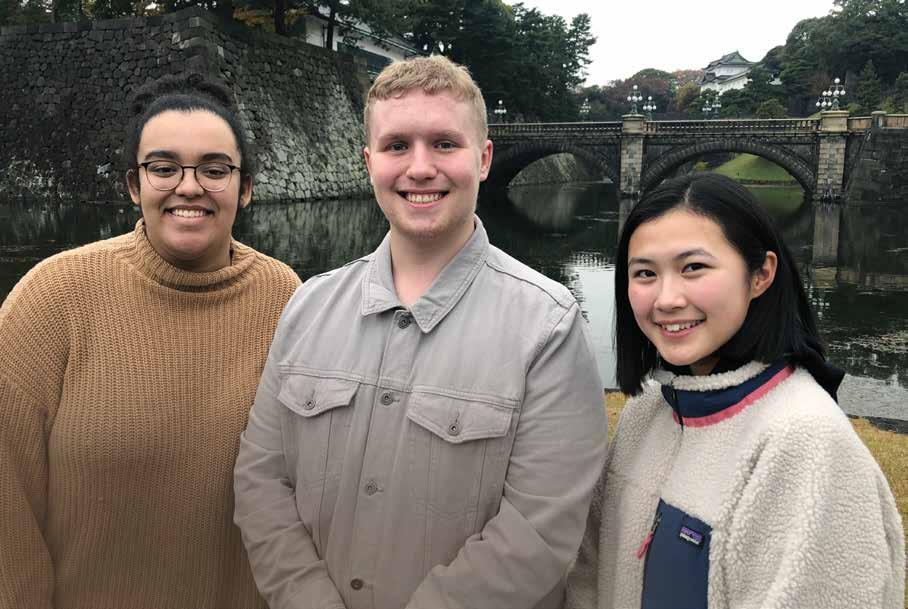
The museum’s ground-breaking five-year War and Peace in the Pacific 75 international learning program commemorates the 75th anniversary of World War II and promotes peace and reconciliation across the Pacific. Jeff Fletcher profiles the latest iteration, which culminated in student ambassadors from three continents meeting in Japan.
01
The three youth ambassadors: Charlie Conrad-Montgomery (USA), Zack Lynch (Australia) and Rio Wada (Japan) at the Imperial Palace, Tokyo.
Image David Foley
02
Deputy director of the Hiroshima Peace Memorial Museum, Katsunobu Hamaoka, with a quilt made and donated by the students participating in the education program.
Image David Foley

The students made heartfelt speeches on their understanding of past conflicts, yet also established a profound connection to a hopeful and peaceful future
I was born on the 6th of August 2001, exactly 56 years after the first atomic bomb was dropped by an aircraft flying at 9,470 metres directly above us at 8.15 in the morning. I was born at exactly 11.28 am in the morning. I always have thought about what it was like here at 11.28 am that day, what would we see if we were here that fateful morning, what would we be feeling, what could we do?
When this unique opportunity came to me ... and I do think that it personally came to me for a reason ... I have to say that I had mixed emotions. First I am so thankful for the support of the Australian National Maritime Museum and this wonderful program that allows us to heal old wounds, all the while gently guiding us down the path of reconciliation between then and now, the young, the elder, the aware and the unaware.
THESE WORDS ARE FROM A SPEECH by Japanese high school student Rio Wada, at a Youth Friendship Ceremony in Hiroshima on 13 December 2019. Rio was the 2019 Japanese Youth Ambassador in the museum’s War and Peace in the Pacific 75 International Learning Program. Joining Rio on stage were her fellow Youth Ambassadors: Zack Lynch, representing Australia, and Charlie Conrad-Montgomery, representing the USA. They each made heartfelt speeches on their understanding of past conflicts, yet also established a profound connection to a hopeful and peaceful future. That is why they were there.
Students from local high schools, a cohort of visiting American students, an Australian teacher, a deputy director of the Hiroshima Peace Memorial Museum and a former Japanese Youth Ambassador rounded out the presentations. Students then swapped hand-written messages of hope with people they didn’t know. The talks covered serious ground, but the overriding sentiment of this informal conclusion to a formal ceremony was one of friendship and a non-scripted enthusiasm to share culture and discover more about each other. Language proved no barrier to fervour and the energetic engagement of youth gave the friendship ceremony a tangible context. Mission accomplished.
2019 was the third iteration of this spirited five-year program, which brings together high school students from Australia, the USA and Japan to research different aspects of World War II’s Pacific conflict. They conduct first-hand research and uncover little-known stories to create free educational resources. One Youth Ambassador from each country attends a week of diplomatic and cultural engagements, visiting historical sites, meeting survivors and working with local schools in a different country each year. The qualities we look for in our Youth Ambassadors are leadership, having something to say, cultural interest and a sense of adventure – a spark that will grow and illuminate as the program unfolds. Destination 2019 was Japan. This year’s theme was Secrets & Spies, and we asked schools to construct their stories through digital media projects. Schools researched the technology of secret weapons, spies and espionage, secret missions, POW camp secrets, government cover-ups, code-breaking and personal stories of courage, sacrifice and reconciliation.
Schools read each other’s blog posts and joined international video conferences, including a digital showcase launch event co-hosted by the students and streamed live from the museum’s theatre. The final products included podcasts, films, website, dramatisations of events, interviews, schematics and broadcasts.
The project encourages active investigation, empathy and contestability to push the boundaries of current perspectives and it is, importantly, student-led. Consequently, they develop quite a personal connection to the stories and are understandably proud of their products. That is where learning starts. ‘Throughout this research project we will be able to gain valuable new insights on topics we never thought of pondering about before,’ noted a group from Amaroo School, Canberra, on their blog.
‘There will always be problems in the world, but there are also always solutions.’Charlie Conrad-Montgomery, USA Youth Ambassador
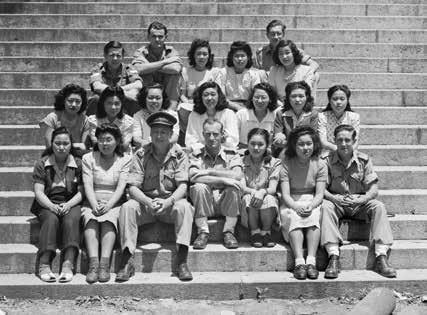

Australia
Amaroo School, Canberra, ACT
St Raphael’s College, Cowra, NSW
St Scholastica’s College, Sydney, NSW
Erskine Park High School, Sydney, NSW*
St Mark’s Anglican Community School, Perth, WA
Pembroke School, Adelaide, SA*
USA
Academy of the Canyons, Santa Clarita, CA
Simon Kenton High School, Independence, KY
Station Camp High School, Gallatin, TN*
Japan
Osaka Meisei Gakuen, Osaka, Osaka*
Sendai Shirayuri Gakuen, Sendai, Miyagi*
Schools visited in Japan
Hiroshima International School, Hiroshima
Jogakuin High School, Hiroshima
Jumonji High School, Tokyo
National College of Technology, Kure
* also took part in the programs in Japan
From there, making a connection to World War II that is relevant to their own lives surprises them, and they tend to embrace it.
Two schools from the USA investigated a former ‘secret city’ in Tennessee called Oak Ridge. One team visited the nuclear reactor there and asked about its role in World War II, as Oak Ridge was instrumental in developing the atomic bombs dropped on Japan in 1945. Going back to Rio’s words, different perspectives on those events raise discussion and thought, relating both to the people involved and to current issues such as nuclear disarmament.
Jump forward several months and the same students are in Sendai, Japan, talking to an 85-year-old survivor of the American air raids of 1945. Just quietly, she announces to our teenagers that, although she has spoken of her experiences before, this is the first time she has talked to an American about the war, and how healing that was for her, even now. A few days later, they met a woman who, in August 1945, was eight years old and living in Hiroshima. The emphasis was on peace and how we can move forward, and she told the students they weren’t leaders of tomorrow, they were leaders of today. ‘You have leaders’ faces,’ she said, ‘and we are passing the baton of peace to your generation … Knowing is the first step in preventing a war.’ The significance of both moments was palpable.
In a Voice of America radio broadcast on 11 November 1951, Eleanor Roosevelt said, ‘It isn’t enough to talk about peace. One must believe in it. And it isn’t enough to believe in it. One must work at it.’ That is exactly what we all did during our time in Japan – sometimes consciously, sometimes organically and occasionally serendipitously. Of course, there were challenges, but there was a pervading sense of continual learning that made it a very happy and supportive time.
We visited four cities – Tokyo and Sendai, which were bombed in 1945; Hiroshima, the site of the first atomic bomb; and Kure, where Australian occupying forces set up headquarters in 1946. Joining the team were a special student film envoy, teacher chaperones, a group of enterprising students from Tennessee who paid their own way, translators, a Japanese student exchange representative plus staff from the museum and Education NSW.
Working with local high schools provided many special moments and encouraged the sharing of different outlooks. In Tokyo, we visited Jumonji High School, which was bombed in 1945, and examined material from their archives, before sharing lunch with present-day students. In Hiroshima, students from Jogakuin High School guided us through the Peace Park, explaining the city’s commitment to fostering peace. They gave informed and challenging presentations at the Youth Friendship Ceremony, as did the students from the Hiroshima International School, who ran a special workshop to make origami cranes as peace symbols. Hanging paper cranes in the Peace Park and ringing the United Nations Peace Bell together were significant experiences. At Sendai Shirayuri High School, we took part in a traditional tea ceremony and a Japanese calligraphy class. In a special Q&A forum, Ms Ikuko Nozawa, a 93-year-old former student and air-raid survivor, held us spellbound with her eloquence and passion for youth to understand the importance of peace. And, in something of a culture shock for the Australians and Americans, they discovered that in many Japanese schools, students and staff clean the entire school each afternoon!
In Kure, the effervescent students from the National College of Technology used their English skills to put together an amazing tour program that included a World War II bunker, history and maritime museums, a meeting with the mayor and their favourite places to eat. A lovely moment was recreating a photo from 1946 showing Australian occupying forces and Japanese communications operators on the steps of the naval base. There is a poignant sense of rebuilding evident in that photo, which captured the essence of why we were there so many years later.
A key component of this program is to promote youth advocacy and give students a chance to develop and refine their leadership skills. We gave them key responsibilities at formal events and created opportunities to meet with high-ranking officials. These included members of the Japanese Maritime Self Defence Force (JMSDF) in Kure, who kindly worked with the Kure students on the visit to the naval base then gave us an exciting tour of their vessel Osumi, including lunch in the mess hall.
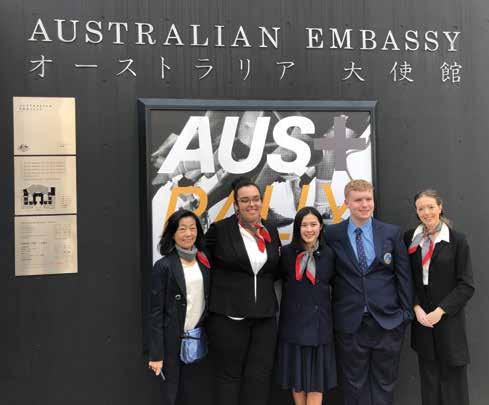
Morning tea at the Australian Embassy in Tokyo was an exciting event and reminded the students that those already working internationally are interested in what they have to say.
The Australian Ambassador to Japan, His Excellency the Hon Richard Court AC , and Embassy staff talked enthusiastically with the students on their participation in the program, future plans and how their three nations work cooperatively on many levels in today’s world.
At the Commonwealth War Graves Cemetery in Yokahama, the Youth Ambassadors held a wreath-laying ceremony with the Australian Defence Attaché to Japan, Col Simon Monterola. Australian Youth Ambassador Zach Lynch’s speech covered the relationship between honouring those who fell and the world we have today:
The soldiers who lost their lives continue to protect us in their own way, even from beyond the grave, because remembering the fallen allows us to honour them and use lessons that their sacrifice has taught us to help keep those who are alive safe from the threats that caused us to lose those soldiers in the first place.
At the United Nations Institute for Training and Research (UNITAR), just across from the Hiroshima Peace Park, we attended an inspiring session on the agency’s role in peacebuilding and training, and learned about the ‘Hiroshima Peace Trees’, which flowered again even after the devastation caused by the atomic bomb. People around the world plant seeds from the trees in their own countries as symbols of peace. We intend for our schools to participate in this program in 2020.
Members of the group outside the Australian Embassy in Tokyo: Miki Cook from Global Reach, student Ambassadors Charlie Conrad-Montgomery (USA), Zack Lynch (Australia) and Rio Wada (Japan) and translator Anna Parker. Image David Foley
At the Youth Friendship Ceremony, Mr Katsunobu Hamaoka, the Deputy Director of the Hiroshima Peace Memorial Museum, challenged us to make the most of opportunities and keep learning once we return home: ‘In this museum we have prepared a menu that will enable everybody to return to their home towns and countries and continue to learn, so please take advantage of it.’ The Youth Ambassadors presented a quilt, which students from our project decorated with symbols of harmony and their nation to symbolise coming together in friendship. A second, similar quilt sits in the museum’s Education Collection.
I have often wondered how this program seems to open doors to difficult and indeed painful territory in a way that supports and motivates people to share their experiences. I think the answer is twofold: firstly, it is about discussing past conflicts in the context of the preciousness of peace, and secondly, youth are at the forefront, which gives hope for the future.
Education officers work on a fascinating range of projects. Just a few times in a career, if you are lucky, a program comes along that changes everything. This is one of those moments.
In 2020 students will explore ‘Peace, Revelation and Reconciliation’, produce works of art and meet in San Francisco. For more information on the War and Peace in the Pacific 75 program, please see our website: sea.museum/ wapip75.
War and Peace in the Pacific 75 is supported by the USA Bicentennial Gift Fund.
Jeff Fletcher is the museum’s Senior Education Officer USA Programs.
Inaugural Gala Dinner
Business Donors
Australian Brandenburg
Bally
BridgeClimb
Burke Marine
Café Sydney Cerrone
Coffin Bay Clams
Cruising Yacht Club of Australia
Cypress Lakes Golf & Country Club
De’Longhi Fish Tales
Foundation Theatres Four Pillars
Hamilton Island Enterprises Limited
International Convention Centre Sydney
Laissez-Faire
Opera Australia
Ovolo Hotels
Pearls of Australia
Port Authority of NSW
Ralph Kerle’s Art
Royal Australian Navy
Rugby Australia
Scenic World
Seiko Australia Pty Ltd
Sydney by Sail
Sydney Fish Market
Sydney Harbour Federation Trust
Sydney Heritage Fleet
Sydney Institute of Marine Science
Sydney Seaplanes
Sydney Theatre Company
Tyrrell’s Wines
Virgin Australia
Zip Heaters (Aust) Pty Ltd
Individuals donors
Robert Albert AO Colin Fassnidge
Giovanni Pilu
Twelve men, seven nationalities, three rafts, six months and one epic 14,000-kilometre trans-Pacific voyage. Curator Kim Tao interviews Luis Guevara from the 1973 Las Balsas expedition, which completed a record-breaking crossing of the Pacific Ocean from Ecuador to Australia on three balsa-wood rafts.
LUIS ANIBAL GUEVARA WAS BORN IN 1949 in the Ecuadorian capital of Quito, situated 2,850 metres above sea level and far from the Pacific Ocean. He was the eldest of six siblings; his father was a politician and his mother a dressmaker and talented cook who instilled in him a passion for travel and learning something new every day. In 1966 Luis was a cadet in the Ecuadorian Navy when he crossed paths with the Spanish explorer Vital Alsar. It was a meeting that would change the course of Luis’ life.
Vital Alsar had been inspired by the story of the legendary Kon-Tiki expedition in 1947, when Norwegian adventurer Thor Heyerdahl and his five crew sailed a primitive balsa-wood raft from Peru to the Tuamotu Islands in French Polynesia. Alsar aspired to double the 8,000-kilometre distance covered by Kon-Tiki in 101 days. Luis Guevara recalls: I met Vital Alsar the day he was collected from the sea after a failed expedition close to the Galápagos Islands [some 900 kilometres west of mainland Ecuador]. Those days no one would believe it was possible for a balsa raft to navigate the ocean or keep afloat after several months on the Pacific. I asked him to consider me for the next expedition.
One of the Las Balsas rafts at sea, with the other two rafts in the background, 1973. Photograph by John Carnemolla. All images reproduced courtesy Ballina Naval & Maritime Museum
Luis’ opportunity would come in 1973. Three years earlier, Alsar and his three crew had successfully sailed a balsa-wood raft 13,800 kilometres from the Ecuadorian port of Guayaquil to Mooloolaba on Queensland’s Sunshine Coast. This expedition, known as La Balsa (‘The Raft’), took 160 days and, at the time, was the world’s longest recorded raft voyage. Many attributed it to sheer luck, however, prompting Alsar to launch a new expedition in three rafts called Las Balsas (‘The Rafts’), to prove that the ancient civilisations of South America could have navigated fleets of balsa rafts to trade or migrate across the Pacific and settle in Polynesia.
For Las Balsas, Alsar recruited an international crew of 11 men. Two had participated in the 1970 La Balsa expedition – Marc Modena from France and Gabriel Salas from Chile. The others were Hugo Becerra, also from Chile; Jorge Ramirez from Mexico; Fernand Robichaud, Greg Holden and Gaston Collin from Canada; Tom McCormick, Tom Ward and Mike Fitzgibbons from the United States; and Luis Guevara from Ecuador.
In 1973, 24-year-old Luis left the Ecuadorian Navy and joined Las Balsas as a navigator. He says:
My navigation skills were not only learnt in the Salinas Naval Academy, but I also went to the Franciscan Order to look at some old manuscripts and learn the art of guiding a raft without rudder across the Pacific. I also felt I needed to prove for myself that my ancestors could use these rafts for long voyages before Cristóbal Colón [Christopher Columbus] discovered the Americas.
All 12 Las Balsas sailors were involved in building the three rafts Guayaquil, Mooloolaba and Aztlán, which were based on designs used by the indigenous South Americans before the arrival of Spanish explorers and conquistadors in the 15th and 16th centuries. Measuring 14 metres long and 5.5 metres wide, each raft was constructed from nine balsa-wood logs and had a thatched cabin to provide shelter for the crew. Luis remembers:
We all went to the jungle at the Hacienda la Clementina and cut the balsa trees in full moon [when sap rises and fills pores, helping to prevent waterlogging] to avoid them being too heavy and sinking during the trip. We also cut bamboo and caña de Guayaquil [a native bamboo]. Then we took the materials to Guayaquil and built the rafts alongside the Guayas River.
‘Those days no one would believe it was possible for a balsa raft to navigate the ocean or keep afloat after several months on the Pacific’
Registrations now open!
Honour your family’s migration heritage by including an inscription on the Welcome Wall. The next panel will be unveiled on Sunday 24 May. Inscriptions must be finalised by Thursday 9 April to appear on this panel. For details go to sea.museum/welcome-wall
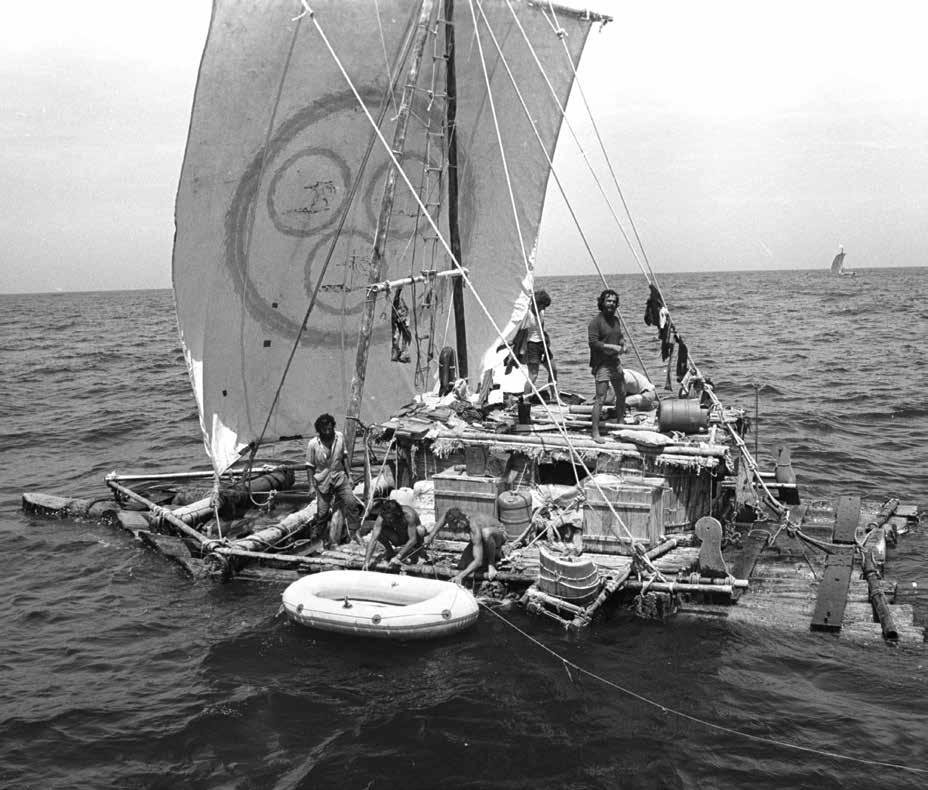
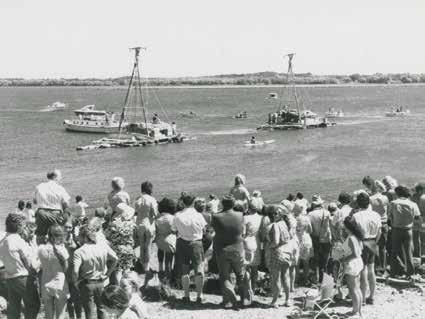
On 21 November 1973, after 178 days at sea, Las Balsas arrived at Ballina in the Northern Rivers region of New South Wales
01
Crowds watch as two of the Las Balsas rafts make their way up the Richmond River to Ballina, New South Wales, 1973.
Photograph by David Harrison
02
The 12 sailors from the Las Balsas expedition in front of the Suntori Motel and Restaurant in Ballina, New South Wales, 1973. Luis Guevara is fourth from left.
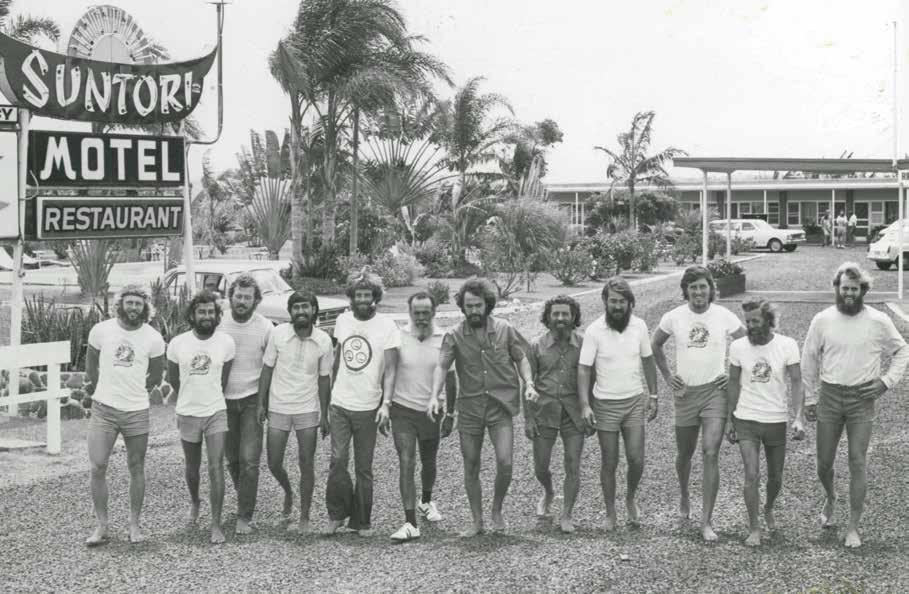
Luis notes:
It was all done by hand, carved and joined together with manila ropes. The most important part was to cut, by hand, the spaces required for the guaras – long pieces of hardwood used like a centreboard in different positions of the raft, to create stability and used instead of a rudder. If you lifted the guaras from starboard, the raft moved to port, and vice versa. This was different from the design of Kon-Tiki [now displayed at the Kon-Tiki Museum in Oslo, Norway], and it became quite a skill to move them just enough up or down, in order to navigate in a set direction.
Ahead of their departure in May 1973, the crew packed enough water supplies to last several weeks, after which they would rely on rainwater collected in buckets. In terms of food, Luis explains:
Most food was prepared in the same way as the old tribes from the coastal areas of Ecuador. Eggs were immersed in calcium sulphate to keep them good for four months. Sausages were prepared and immersed in pork lard to keep them for a long period of time. There were lots of grains, dried and fresh; potatoes; lots of different kinds of flour, made mostly from quinoa, corn and red beans; and also a bit of tequila from the Mexican Ambassador. The bulk of their protein would come from freshly caught fish, such as tuna and dorado (mahi-mahi).
Luis took two pairs of jeans, two sweaters, half a dozen pairs of underwear, a diving suit and three Ecuadorian hats (Panama hats). He also carried a supply of his mother’s home-made chocolate, a photograph of his family, a banner from the Ecuadorian Navy and his passport (which he would subsequently lose during the voyage). The night before departure, Luis says:
I was requested to meet the highest-ranking officers from the port of Guayaquil. They were kind and proper, but literally told me that if I did not succeed for our history, then don’t bother to return. That is how important our expedition was to acknowledge the techniques of the indigenous people in the pre-Columbian era. I knew we will make history.
On 27 May 1973, thousands of people lined the Guayas River in Guayaquil to farewell Las Balsas. Luis recalls, ‘I was so happy to finally leave Ecuador as the preparations took about three months. We all knew that the expedition would not be any shorter than six months.’
Their route across the Pacific passed the Galápagos Islands, Society Islands, Cook Islands, Tonga and New Caledonia:
After the Galápagos, there were tropical storms coming from the south, which were quite strong. The whole crew had to work day and night for many days without end to keep the raft going. A raft is a totally different craft to navigate compared to a sailing vessel. It is heavy, lacks control and you are only one foot [30 centimetres] above water at all times, so you are wet most of the time. A storm near Rarotonga [in the Cook Islands] lasted for 10 days and created problems trying to keep the rafts close enough together. One time, my raft became separated from the other two rafts for a period of eight days. However, I knew we will find them further west and kept our bearing 270 degrees west for several days until we saw them as a dot on the horizon and reunited with them.
On 21 November 1973, after 178 days at sea, Las Balsas arrived at Ballina in the Northern Rivers region of New South Wales. The expedition had travelled 14,000 kilometres across the Pacific Ocean from Ecuador to Australia, eclipsing the previous record set by La Balsa in 1970. The rafts Mooloolaba and Aztlán landed safely at Ballina, but as Luis explains, ‘We [on Guayaquil ] were the last ones to finish the expedition as our raft was involved in a serious storm just in front of Ballina and broke down. We were collected by the Royal Australian Navy ship [HMAS Labuan].’ 1
Luis continues:
We had a great reception on arrival and I later had the pleasure of meeting [then Prime Minister] Gough Whitlam and several of his ministers when we went to [Parliament House in] Canberra. We had the opportunity to exchange stories of our past way of life on the rafts with the ministers and of the new enormous continent we had landed on. We did not know the magnitude of differences between those worlds.
While Luis had never intended to migrate to Australia, he states: Ecuador had a military junta and I was not very happy to return. I never accepted the decoration offered to me by the Ecuadorian government. The Australian government was very supportive for us to stay and I gladly accepted their offer to stay in Australia. Now reflecting on this after many years, this was my best decision.
Luis found a job as a tradesman with Civil and Civic in Sydney, before enrolling to study at the University of New South Wales. He became a biomedical engineer, researching knee replacements and cochlear implants. He also became the first Honorary Australian Consul for the Republic of Ecuador.
Luis is married to New Zealand-born Maryanne Barnard and has two children, Elyse and Jean Paul. Elyse, also a keen sailor, studied medical sciences and works in medical research.
Jean Paul joined the Royal Australian Navy and served in Iraq, before moving to the USA to study international relations. He met his partner Fran in the Galápagos and they now have a daughter named Isabela.
Luis Guevara, a self-proclaimed ‘proud Aussie’, was registered on the Welcome Wall by his wife, Maryanne. Asked to reflect on his role in Las Balsas, the longest recorded raft voyage in history, Luis says, ‘Modern navigation is so completely different to the old timeless navigation used by the pre-Columbian sailors. It is important to acknowledge the link between navigation and migration, and that the two come hand in hand, even these days’.
1 Left to drift, Guayaquil ended up in Newcastle (nearly 600 kilometres south) and was later burned as scrap. Aztlán and Mooloolaba were moored on the Richmond River; the former was secured, while the latter eventually broke apart. Today a composite of these two rafts remains on display at the Ballina Naval & Maritime Museum on the north coast of New South Wales.
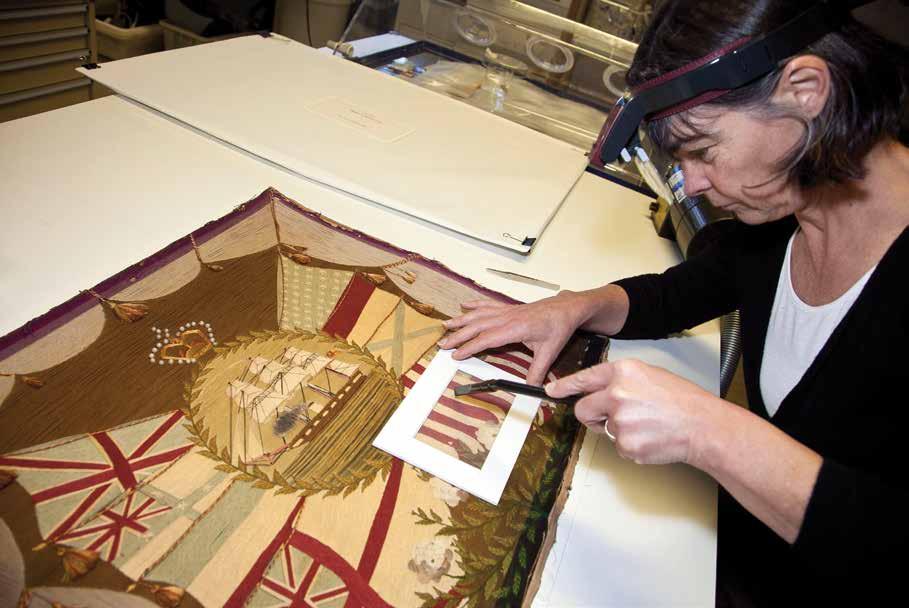
Late last year, at a ceremony in Melbourne, three members of the museum’s conservation team were recognised by the Australian conservation profession. Nick Flood looks at the outstanding contributions that Sue Frost, Jan Russell and Sue Brian have made to the museum.
01 Sue Frost uses a miniature vacuum cleaner and screen to gently clean a woolwork picture made in the 1860–70s. Image Lucilla Ronai/ ANMM
02 Sue Frost (right) and Elizabeth Hadlow working on one of four panels of the Binney Frieze in 1995. Image Andrew Frolows/ANMM
Over the years, Sue Frost has played a leading role in major conservation projects at the Maritime Museum
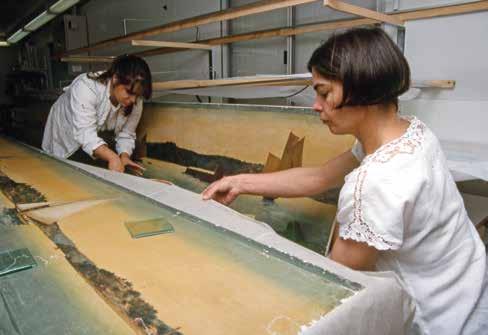
WHEN MOST PEOPLE IMAGINE THE MARITIME MUSEUM, they think of exhibitions, vessels floating on Darling Harbour and tours led by knowledgeable volunteers. But it’s what visitors rarely see – the effort of a large team working away in the background – that helps to keep the show running smoothly. The museum’s conservation team is at the centre of this work.
When museum staff talk about conservation, they mean the preservation of objects – such as the 150,000-odd items held in the National Maritime Collection. A dedicated group of professional conservators cares for these objects, documenting them, preparing them for display, treating deterioration, designing suitable storage, maintaining environmental conditions and performing scientific analysis. Conservators often specialise in specific areas, such as paper, textiles, paintings, wood or metal. The museum’s conservation team has nine staff: six conservators, one conservation preparator and two volunteers.
The national body for the conservation profession is the Australian Institute for the Conservation of Cultural Material (AICCM). Recently, three members of the museum’s conservation team were acknowledged with AICCM awards. The AICCM Outstanding Service to the Profession Award was given to Sue Frost, recognising her 40-year contribution to the conservation community (including 24 years at this museum). Her remarkable career started in the early 1980s as a student, during the formative days of conservation in this country. She began her working life as a junior conservator at the Museum of Applied Arts and Sciences (MAAS). To advance her training and experience, she later went to Europe and worked in the textile conservation department at the Victoria & Albert Museum in London. While abroad she spent several seasons with the Australian Archaeological Institute at the Torone dig site in Chalkidiki, Greece. Eventually, with hard-won knowledge and experience, Sue returned to Australia and the MAAS.
In 1984, Sue and a group of pioneering conservators formed what would become Australia’s largest conservation private practice, International Conservation Services. Sue joined the Maritime Museum in 1996, where she worked firstly as the Senior Textile Conservator and then Senior Conservator – Exhibitions.
Amid the adventure and movement of her career, Sue has been an active volunteer with the AICCM, especially through her heavy involvement with the Textile Special Interest Group (TSIG). In 1994, she was elected as convenor of the TSIG. Throughout her career she has presented numerous conference papers that have advanced textile conservation in Australia.
01
Conservation volunteer Sue Brian with storage solutions she created for fragile silk fans.
Image Lucilla Ronai/ANMM
02 The travelling exhibition
Exposed – the story of swimwear featured swimsuits and items of clothing prepared by Sue Frost.
Image Andrew Frolows/ANMM
03
Conservation volunteer
Jan Russell sewing a cover for light-sensitive framed artworks.
Image Lucilla Ronai/ANMM
Conservators often specialise in specific areas, such as paper, textiles, paintings, wood or metal
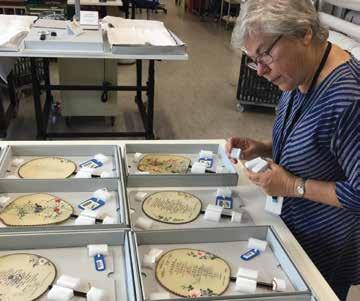

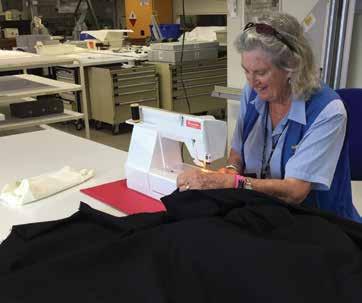
Over the years, Sue has played a leading role in major conservation projects at the Maritime Museum. One such example is the conservation treatment and mounting of the Binney Frieze, a four-panelled panorama of Sydney Harbour with a total length of 19.5 metres. To remove staining, Sue washed each panel with diluted alcohol and carefully dried it. Each section was then lined with Japanese paper and attached to lightweight honeycomb panels to allow for display. The conservation of the Binney Frieze was made possible by a large donation from the Vincent Fairfax Family Foundation.
Sue has been instrumental in establishing the museum’s education program. The education materials for the Conservation and Applied History Workshop, Senior Maritime Archaeology Workshop and Textiles Workshop all have conservation content that Sue created. Her input has allowed generations of secondary school students to learn about the conservation profession for the first time.
In her role as Senior Conservator – Exhibitions, Sue coordinated conservation activities relating to the museum’s exhibition program. Most notably, she worked closely with curators during the development of Exposed – the story of swimwear, an exhibition that broke new ground in the presentation of Australian swimming costumes. Her creative display solutions allowed this exhibition to travel around Australia to state and regional institutions.
The museum cannot think of anyone more deserving of the AICCM’s Outstanding Service to the Profession Award than Sue Frost.
Conservation volunteers Jan Russell and Sue Brian each received the AICCM Outstanding Conservation Volunteer Award.
Conservation volunteers Jan Russell and Sue Brian each contribute hundreds of hours every year to the museum
Since 2007, Jan Russell has volunteered about 550 hours of her time each year – one day a fortnight in the conservation laboratory and the remainder on the museum floor.
Jan is exceptionally good at designing and producing storage solutions for collection objects. The high standard of Jan’s work is most easily seen in the dust covers that she sews for large, complicated, three-dimensional collection objects. These covers can take days to complete and her results are, without fail, functional, durable and beautiful to look at.
Sue Brian joined the conservation team in 2015 and volunteers with us one day each week, or some 390 hours every year. Sue contributes a unique and valuable mix of expertise. As a retired chemistry teacher, she holds vital scientific and practical knowledge. She is also involved with the Norfolk Island Museum, and so has experience in collection management and maritime archaeological conservation. Her knowledge of traditional weaving techniques has proved useful when researching this type of collection object.
Jan and Sue are just two of the hundreds of volunteers at Darling Harbour and across Australia who work with the public and behind the scenes to help make our museum such a special place to visit.
We congratulate Sue, Jan and Sue for their awards and thank them for their contribution to the museum.

Acknowledgments
The Australian National Maritime Museum acknowledges the support provided to the museum by all our volunteers, members, sponsors, donors and friends.
The museum particularly acknowledges the following people who have made a significant contribution to the museum in an enduring way or who have made or facilitated significant benefaction to it.
Honorary Fellows
RADM Andrew Robertson
AO DSC RAN (Rtd)
John Mullen AM
Peter Dexter AM
Ambassador Christine Sadler
Major Donors – SY Ena Conservation Fund
David and Jennie Sutherland Foundation
Honorary Life Members
Dr Kathy Abbass
Robert Albert AO RFD RD
Bob Allan
Vivian Balmer
Vice Admiral Tim Barrett AO CSC
Maria Bentley
Mark Bethwaite AM
Paul Binsted
Marcus Blackmore AM
John Blanchfield
Alex Books
Ian Bowie
Ron Brown OAM
Paul Bruce
Anthony Buckley
Richard Bunting
Capt Richard Burgess AM
Kevin Byrne
Sue Calwell
RADM David Campbell AM
Marion Carter
Victor Chiang
Robert Clifford AO
Helen Clift
Hon Peter Collins AM QC
John Coombs
Kay Cottee AO
Helen Coulson OAM
Vice Admiral Russell Crane AO CSM
John Cunneen
Laurie Dilks
Anthony Duignan
Leonard Ely
Dr Nigel Erskine
John Farrell
Kevin Fewster AM
Bernard Flack
Daina Fletcher
Sally Fletcher
CDR Geoff Geraghty AM
Tony Gibbs
RADM Stephen Gilmore AM CSC RAN
Paul Gorrick
Lee Graham
Macklan Gridley
Sir James Hardy KBE OBE
RADM Simon Harrington AM
Chris Harry
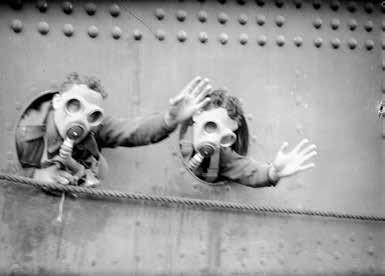
Gaye Hart AM
Peter Harvie
Janita Hercus
Robyn Holt
William Hopkins
Julia Horne
RADM Tony Hunt AO
Marilyn Jenner
John Jeremy AM
Vice Admiral Peter Jones AO DSC
Hon Dr Tricia Kavanagh
John Keelty
Kris Klugman OAM
Jean Lane
Judy Lee
Keith Leleu OAM
Andrew Lishmund
James Litten
Hugo Llorens
Tim Lloyd
Ian Mackinder
Casimiro Mattea
Jack McBurney
Bruce McDonald AM
Ronald McJannett
Ron Miller
Arthur Moss
Patrick Moss
Rob Mundle OAM
Alwyn Murray
Martin Nakata
David O’Connor
Gary Paquet
Prof John Penrose AM
Neville Perry
Hon Justice Anthe Philippides
Peter Pigott AM
Len Price
Eda Ritchie AM
RADM Andrew Robertson
AO DSC RAN (Ret)
John Rothwell AO
Kay Saunders AM
Kevin Scarce AC CSC RAN
David Scott-Smith
Sergio Sergi
Mervyn Sheehan
Ann Sherry AO
Shane Simpson AM
Congratulations to Earl Hingston, who won the Signals 129 caption competition with this entry: ‘Help us! The captain wears the same socks every day!’
Peter R Sinclair AC KStJ (RADM)
Peter John Sinclair AM CSC
John Singleton AM
Brian Skingsley
Eva Skira
Bruce Stannard AM
J J Stephens OAM
Michael Stevens
Neville Stevens AO
Dr Andrew Sutherland AM
Frank Talbot AM
Mitchell Turner
Adam Watson
Jeanette Wheildon
Mary-Louise Williams AM
Nerolie Withnall
Cecilia Woolford (nee Caffrey)
Captain’s Circle Members
Dan Janes
Jonathon Casson
Mark Bethwaite AM
John Jeremy AM
Dawn Bradner
William Hopkins OAM JP
Louise Taggart
David Mathlin
Hon Margaret White AO
Arlene Tansey
Jeff Hughes
Judy Lee
Jaz Stephens OAM
David N Blackley
Peter Poland
Campbell Edmondson
Nick Yates
Martin Rathbone
Peter Dexter AO
Doyle Cook – Port Kembla Gateway
Honorary Research Associates
Lindsey Shaw
Jeffrey Mellefont
Paul Hundley
Rear Admiral Peter Briggs
Ian MacLeod
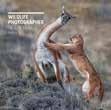
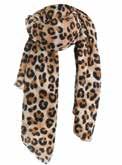
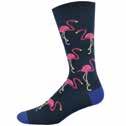
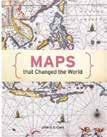




Wildlife Photographer of the Year
Portfolio 29
Portfolio 29 displays the full collection of 100 images awarded in the 2019 competition. Accompanies the exhibition now showing at the museum.
$55.00 / Members $49.50
Leopard print s carf
Add some wildness to your winter with this warm and stylish scarf. 200 x 90 cm.
$39.95 / Members $35.95
Flamingo socks
Soft but durable socks made from thermo-regulating bamboo keep feet warm in winter and cool in summer.
$19.95 / Members $17.95
Some of the world’s most famous maps, stretching back to when cartography was in its infancy. Hardback, 256 pages. $35.00 / Members $31.50
Wheeler’s Islands of Australia
Not just an island continent, Australia is a continent of islands. Lonely Planet co-founder Tony Wheeler explores its islets, cays, atolls and archipelagos.
$39.95 / Members $35.95
Desert waterhole candle holder
Design by Aboriginal artist Kathleen, of Pitjantjatjara descent, inspired by her childhood in a remote community in Central Australia. A portion of each sale goes to the artist. 11 cm diameter.
$35.00 / Members $31.50

Members’ discounts Open 9.30 am–5 pm 7 days a week 02 9298 3698 Or shop online at store.anmm.gov.au
This engraving, after a painting by George Stubbs, was the first published image of the kangaroo. 40 x 40 cm
$45.00 / Members $40.50
Port Jackson tote bag
This map provides a snapshot of Port Jackson and associated waterways and suburbs in 1893, plus advertisements for local businesses. 40 x 40 cm
$45.00 / Members $40.50
James Cook by Peter FitzSimons
Revealing the man behind the famous name – his strengths and weaknesses, passions and pursuits, failures and successes.
$50.00 / Members $45.00
Signals
ISSN 1033-4688
Editor Janine Flew
Assistant editor Laura Signorelli
Staff photographer Andrew Frolows
Design & production Austen Kaupe
Printed in Australia by Pegasus Print Group
Material from Signals may be reproduced, but only with the editor’s permission.
Editorial and advertising enquiries
signals@sea.museum – deadline midJanuary, April, July, October for issues March, June, September, December
Signals is online
Search all issues at sea.museum/signals
Signals back issues
Back issues $4 each or 10 for $30
Extra copies of current issue $4.95
Call The Store 02 9298 3698
Australian National Maritime Museum
Open daily except Christmas Day 9.30 am to 5 pm (6 pm in January)
2 Murray Street Sydney NSW 2000 Australia. Phone 02 9298 3777
The Australian National Maritime Museum is a statutory authority of the Australian Government
Become a museum Member.
Benefits include four issues of Signals per year; free museum entry; discounts on events and purchases; and more. Visit sea.museum or phone 02 9298 3646. Corporate memberships are also available.
ANMM Council
Chairman Mr John Mullen AM
Director and CEO Mr Kevin Sumption PSM
Councillors
Mr David Blackley
Hon Ian Campbell
Hon Justice S C Derrington
Mr John Longley AM
Rear Admiral Jonathan Mead AM RAN
Ms Alison Page
Ms Arlene Tansey
Dr Ian Watt AC
Hon Margaret White AO
Australian National Maritime Foundation Board
Chairman Mr Daniel Janes
Director Mr Peter Dexter AM
Director Mr Rob Mundle OAM
Director Ms Arlene Tansey
Ex officio Chair Mr John Mullen AM
Ex officio
Director Mr Kevin Sumption PSM
David Mathlin
Tom O’Donnell
Dr Jeanne-Claude Strong
American Friends of the
Australian National Maritime Museum
Hon Peter Collins AM QC (Chairman)
Mr Robert Moore II
Mr John Mullen AM
Mr Kevin Sumption PSM
Ms Sharon Hudson-Dean
Foundation sponsor ANZ
Major sponsors
Commonwealth Superannuation
Corporation
Nine
Sponsors
Aurora Expeditions
Challis & Company
Colin Biggers & Paisley
Department of Foreign Affairs and Trade
Laissez-Faire Catering
Lockheed Martin
National Geographic
Nova Systems
Sydney by Sail
White Umbrella
Supporters
Australian Government
Ovolo 1888
Property NSW
Queensland Government
Queensland Museum Network
Royal Wolf
Shipping Australia Limited
Silentworld Foundation
Sydney Fish Market
Tyrrell’s Vineyards
TimeOut
Signals is printed in Australia on Hannoart Plus Silk 250 gsm (cover) and Hannoart Plus Silk 113 gsm (text) using vegetable-based inks.






